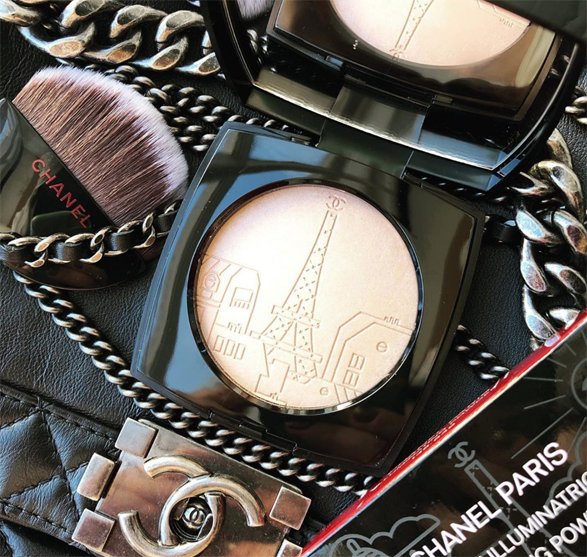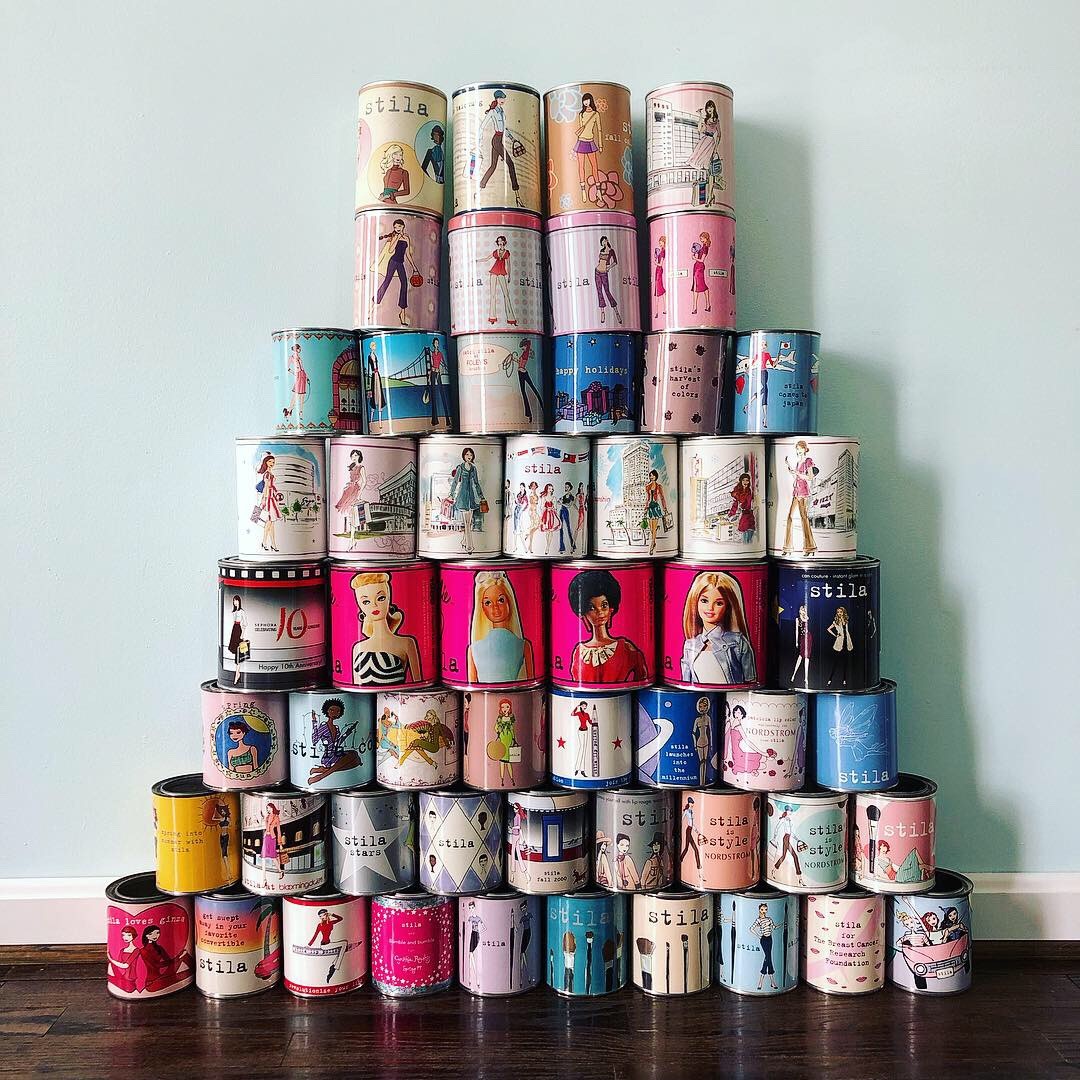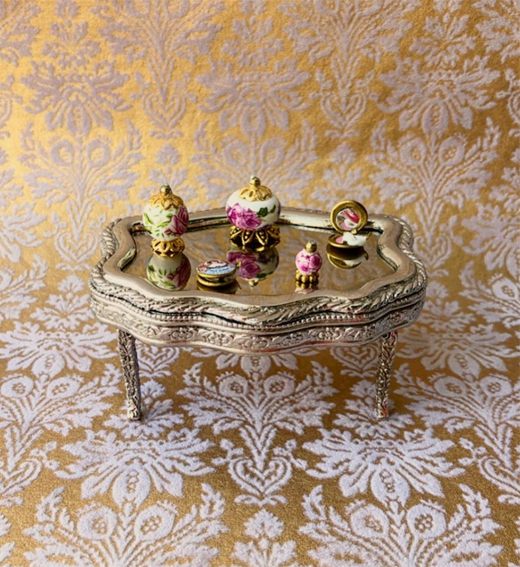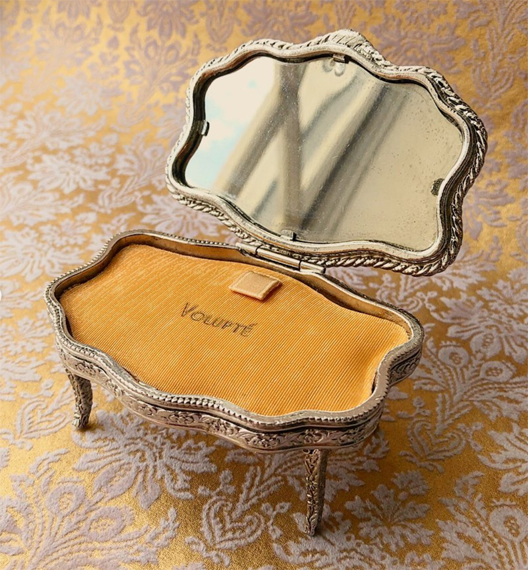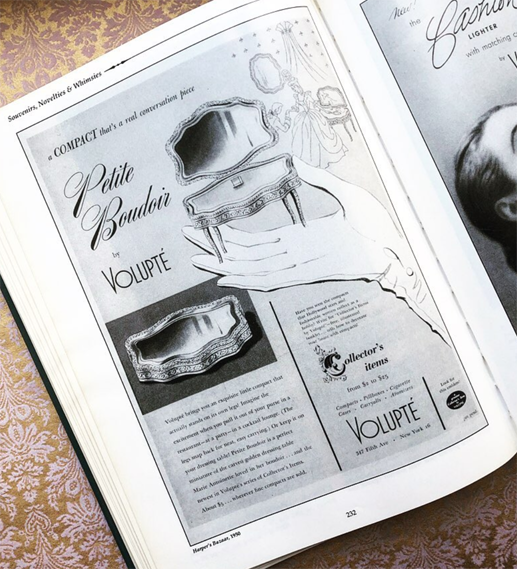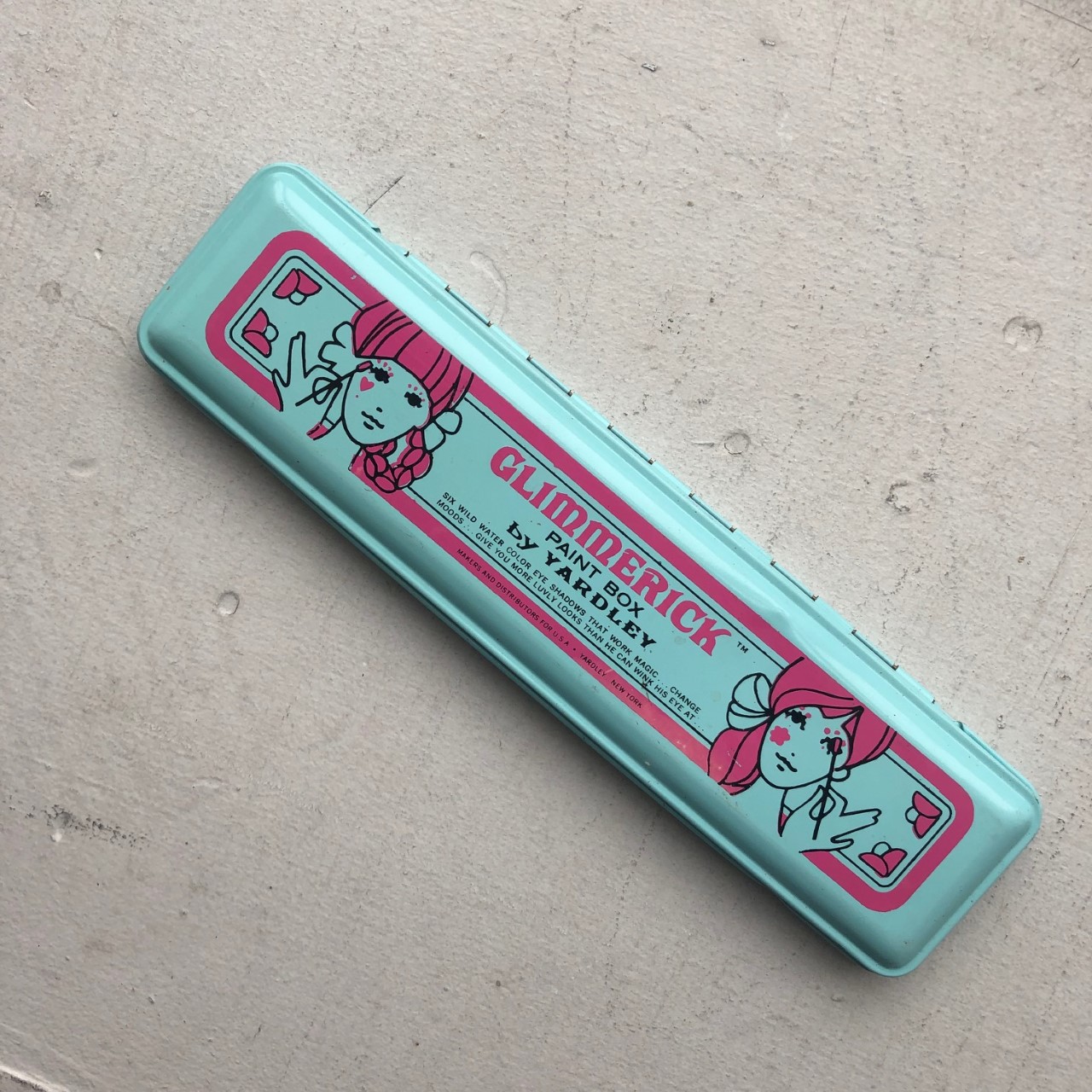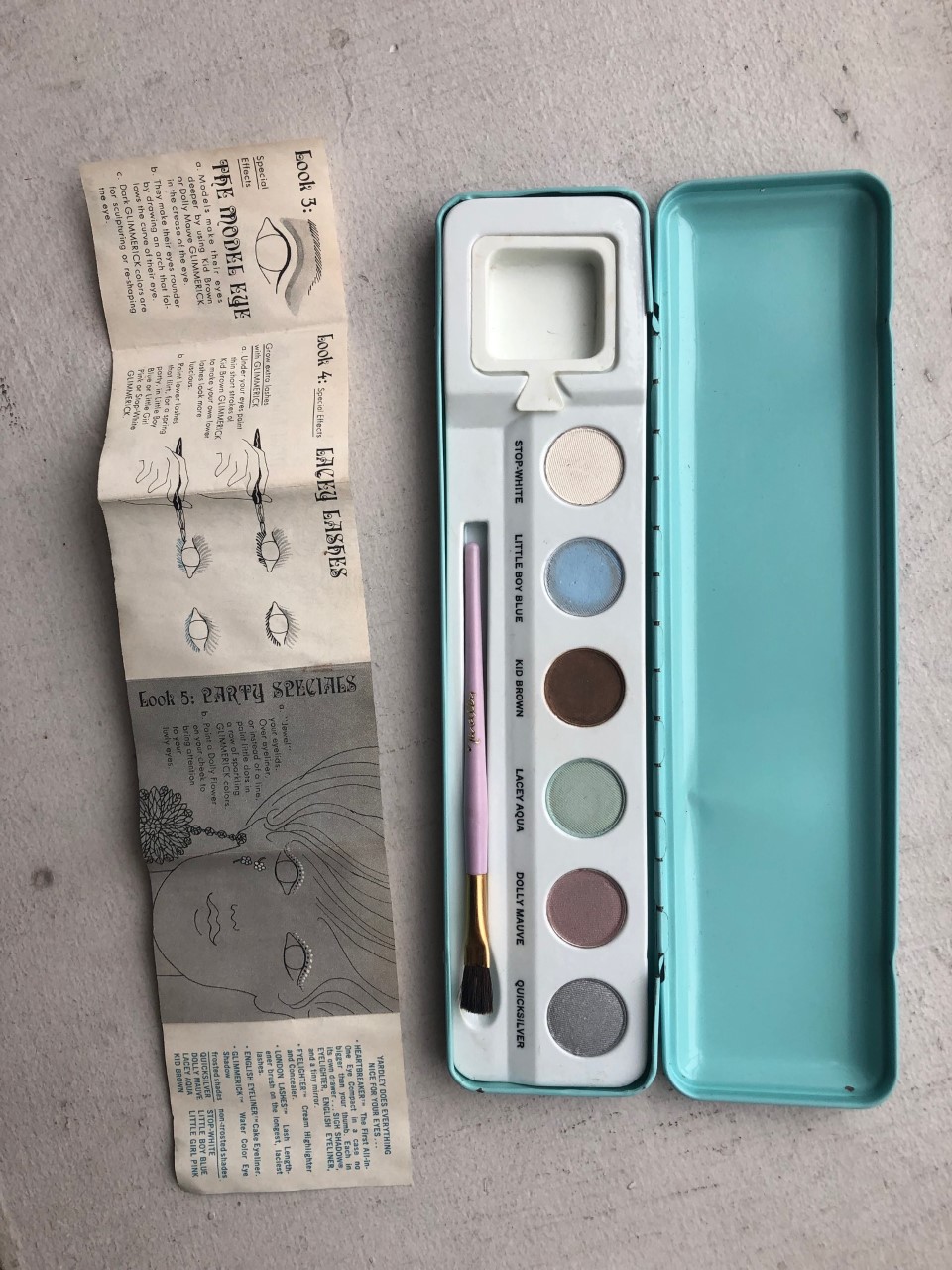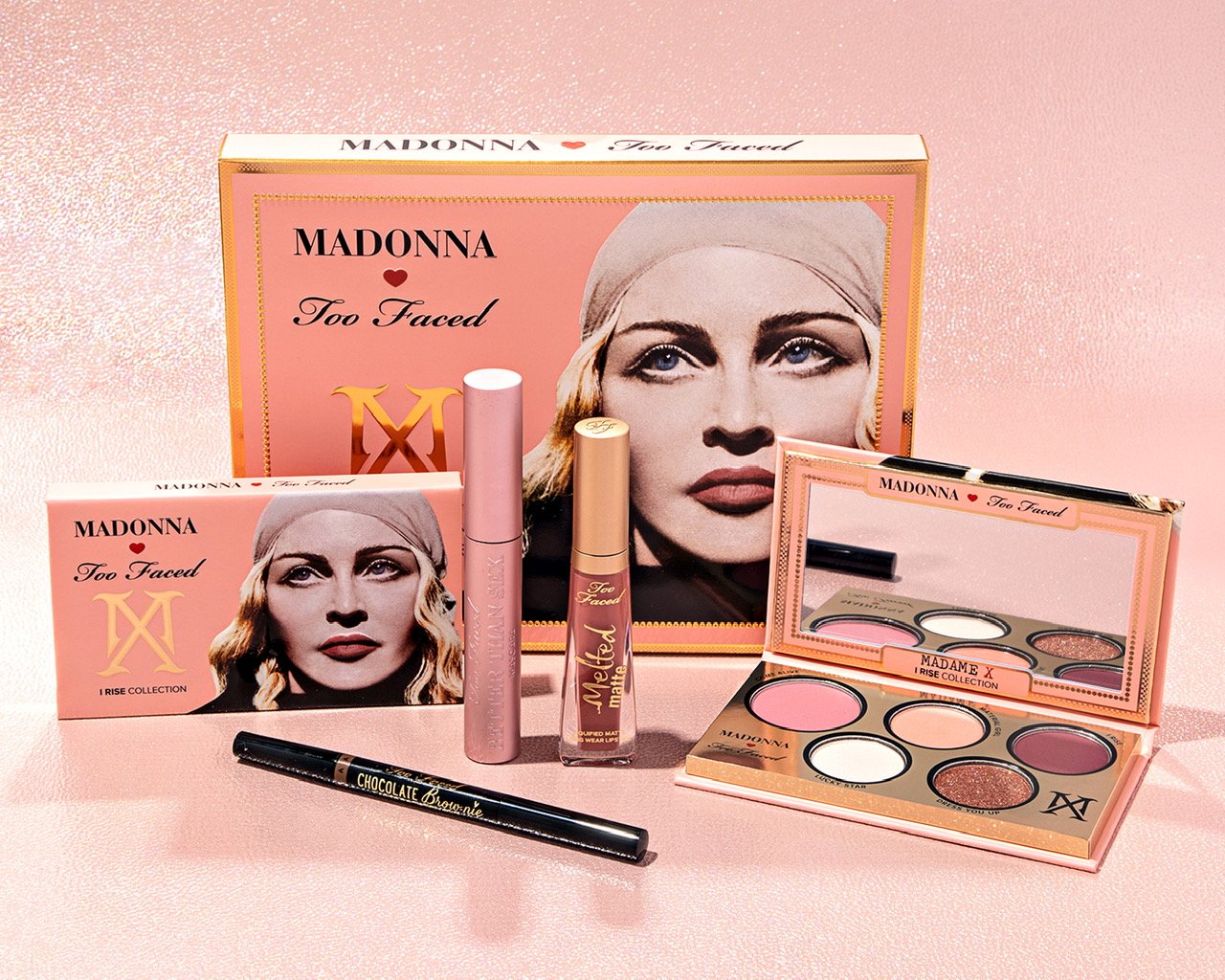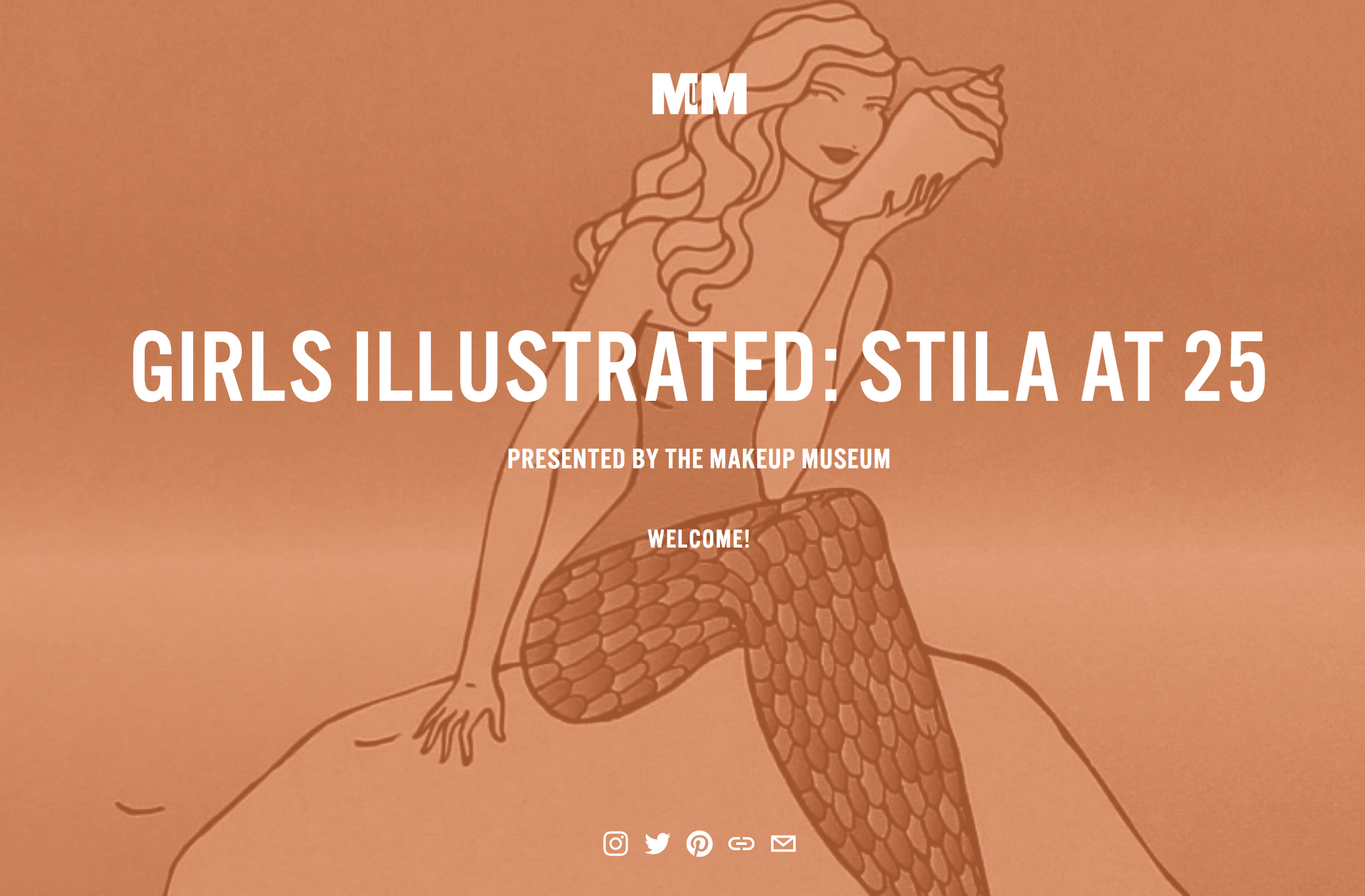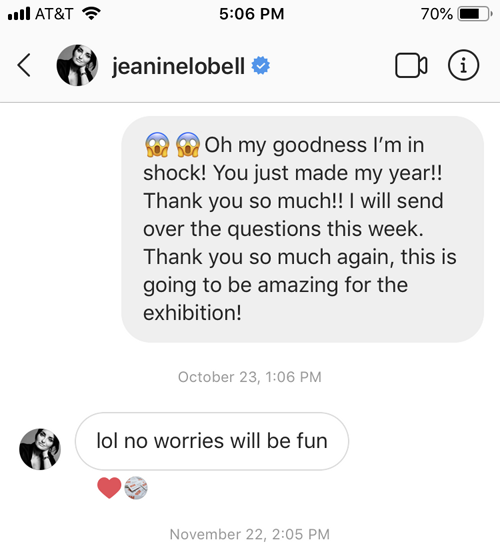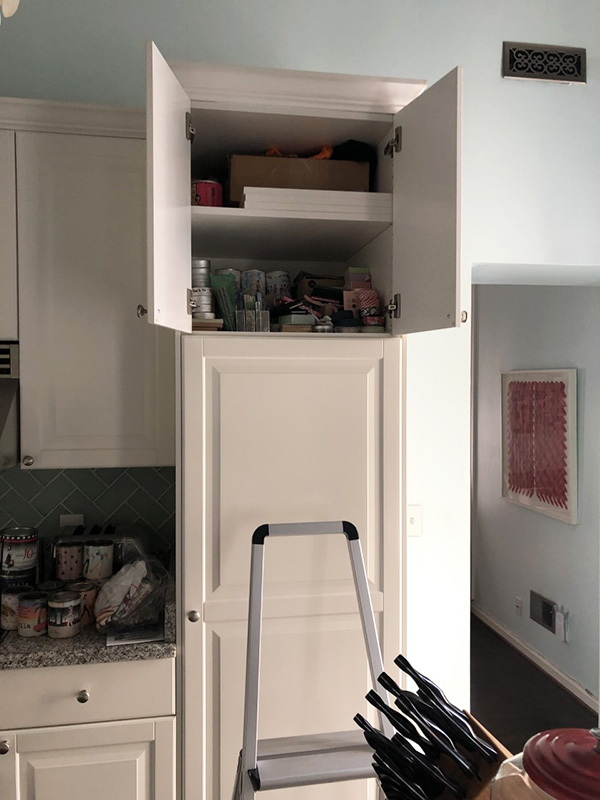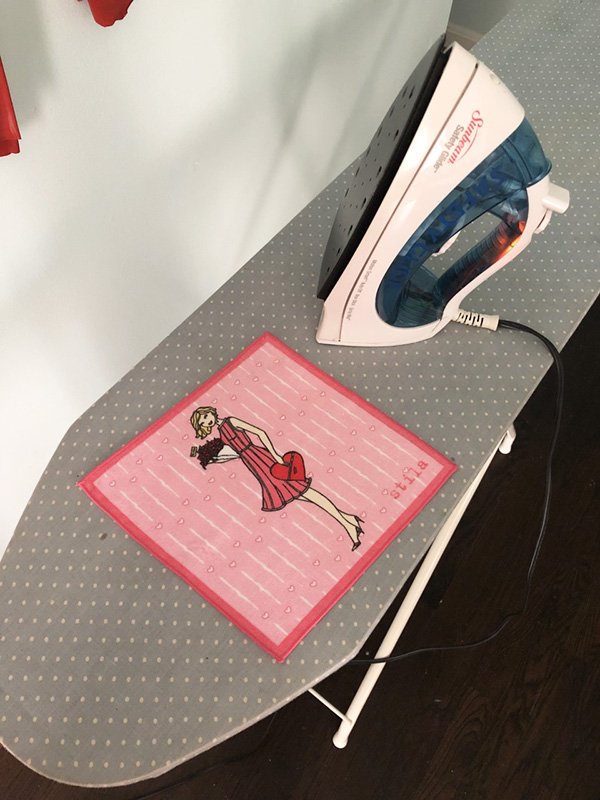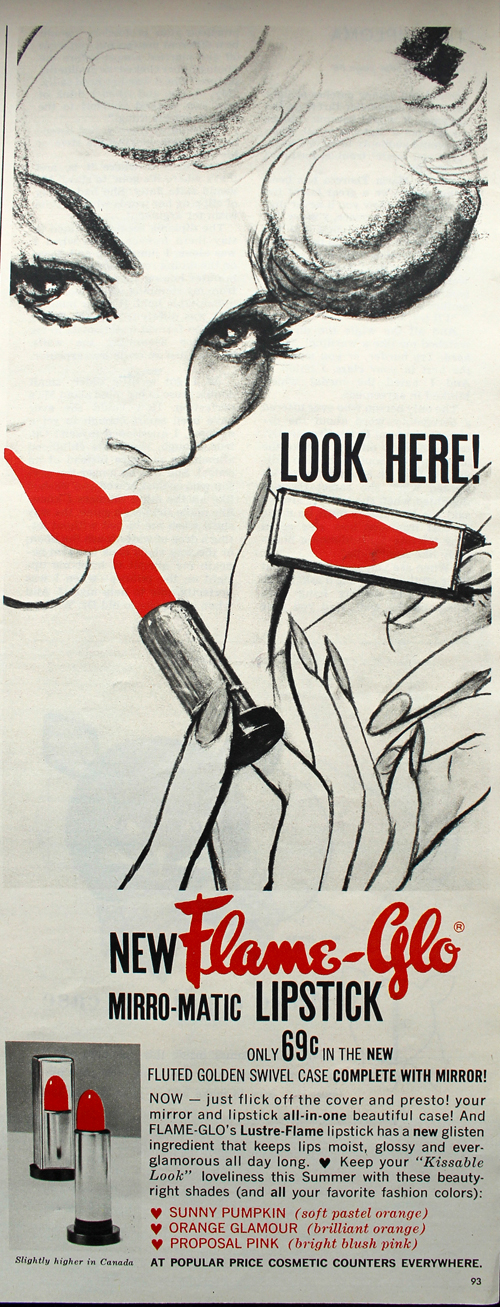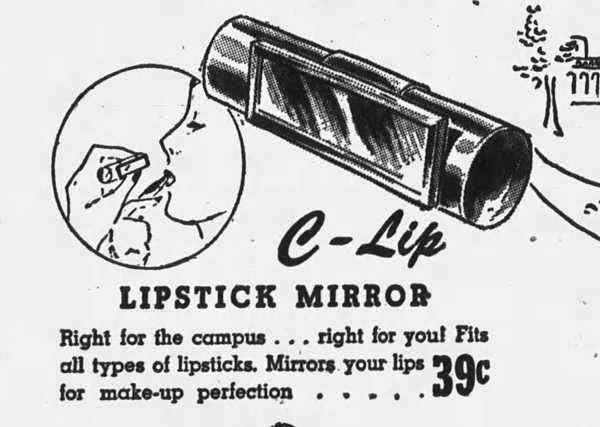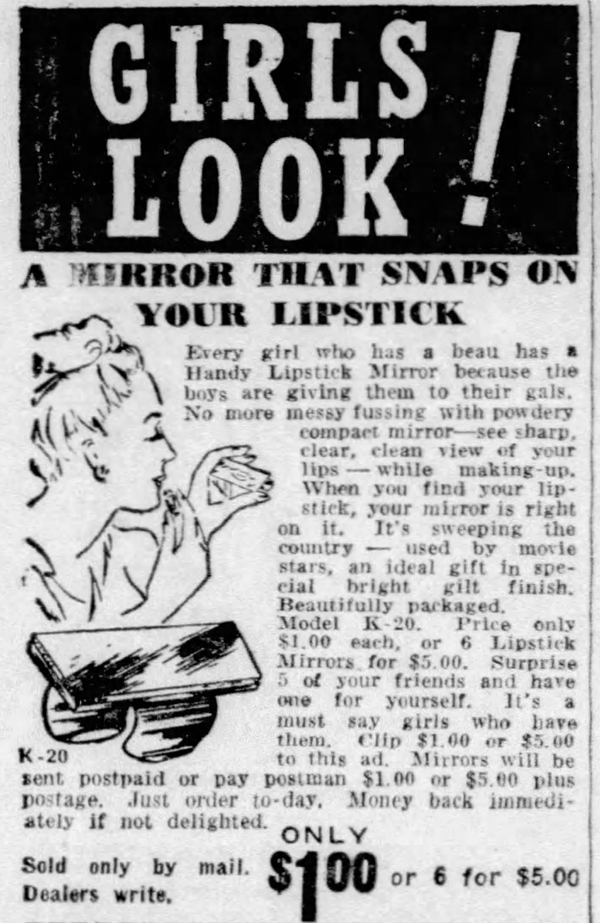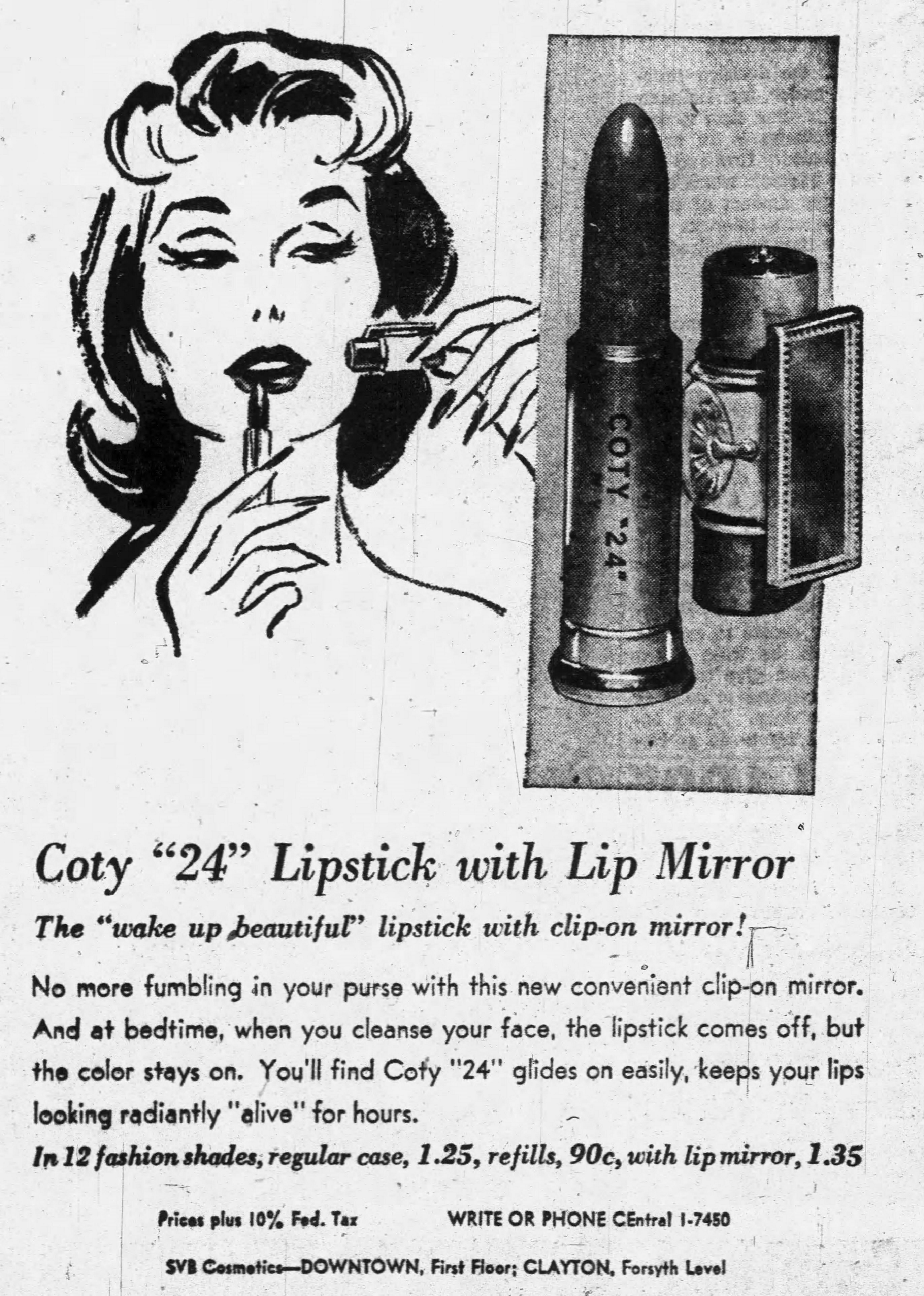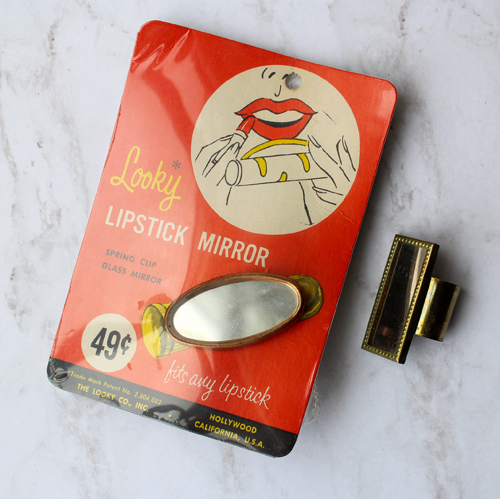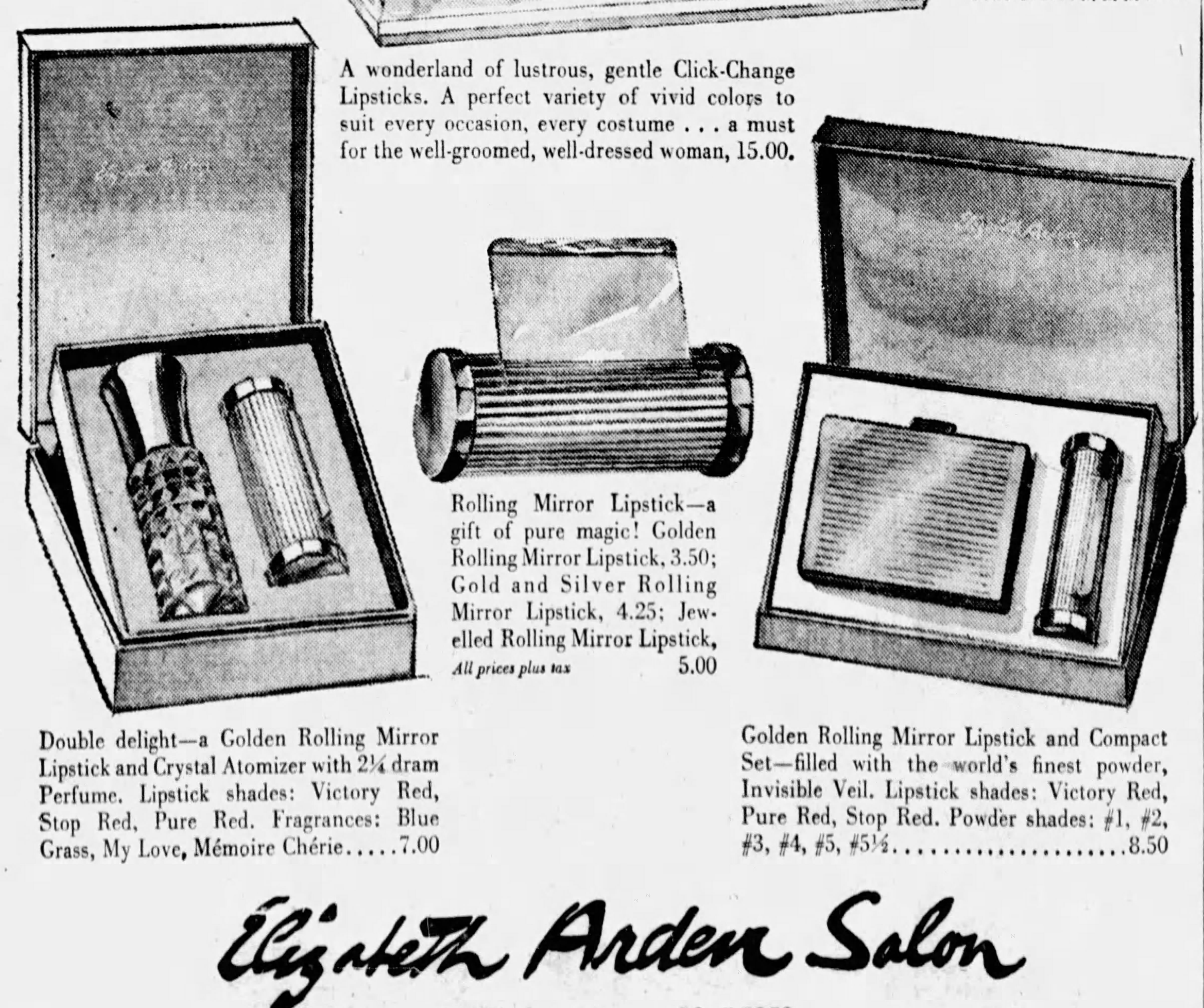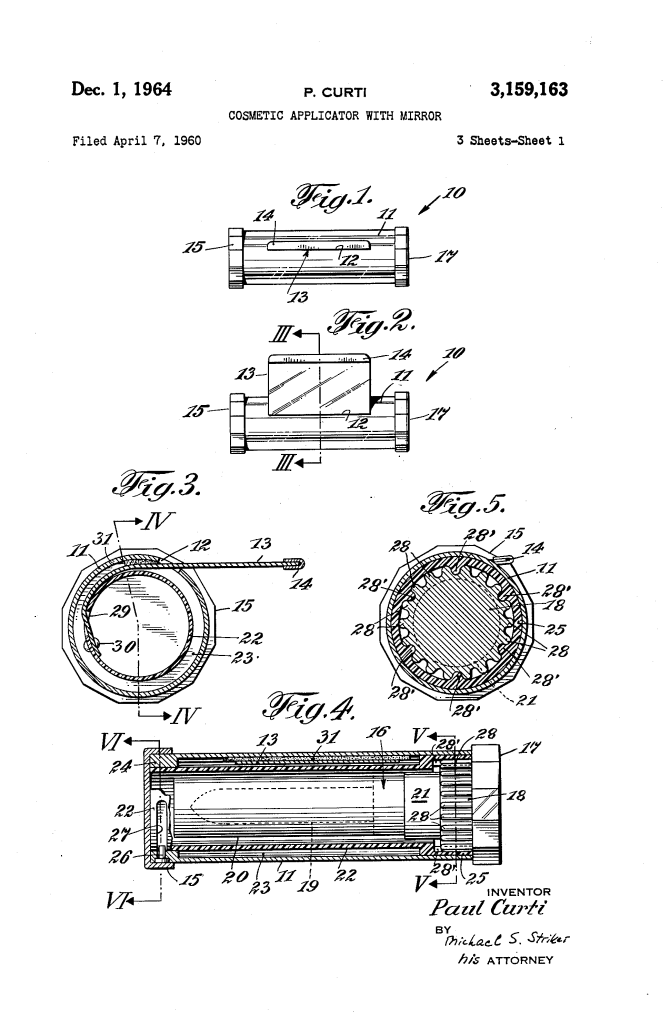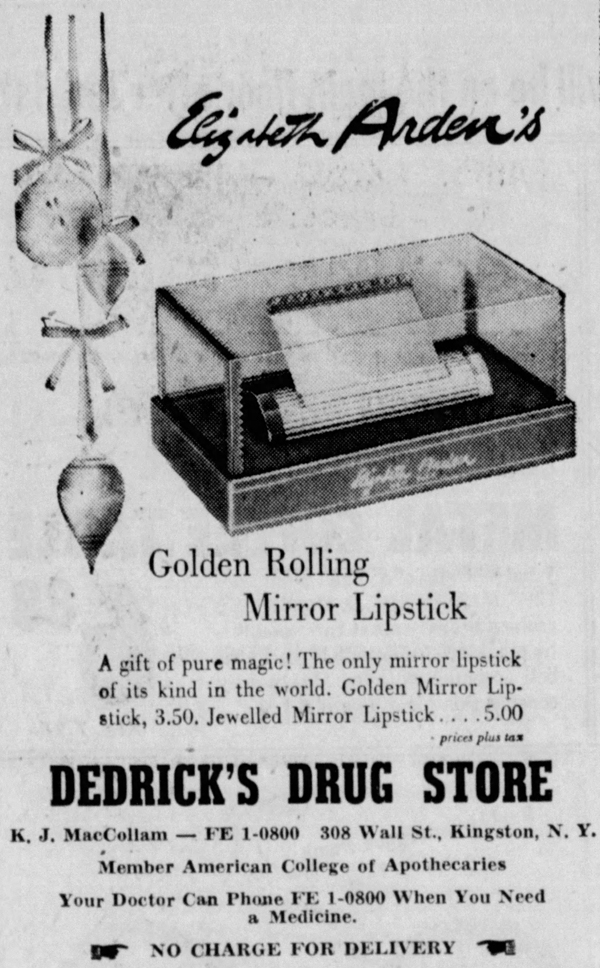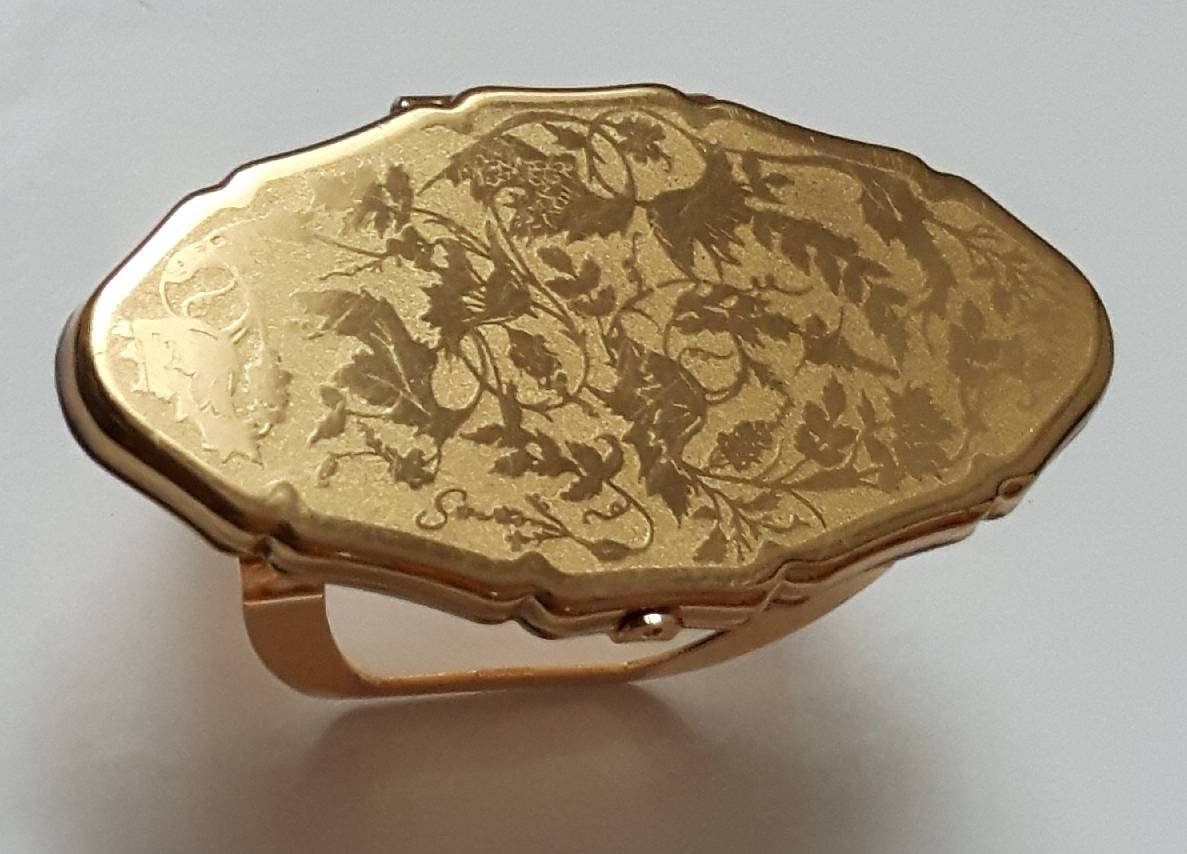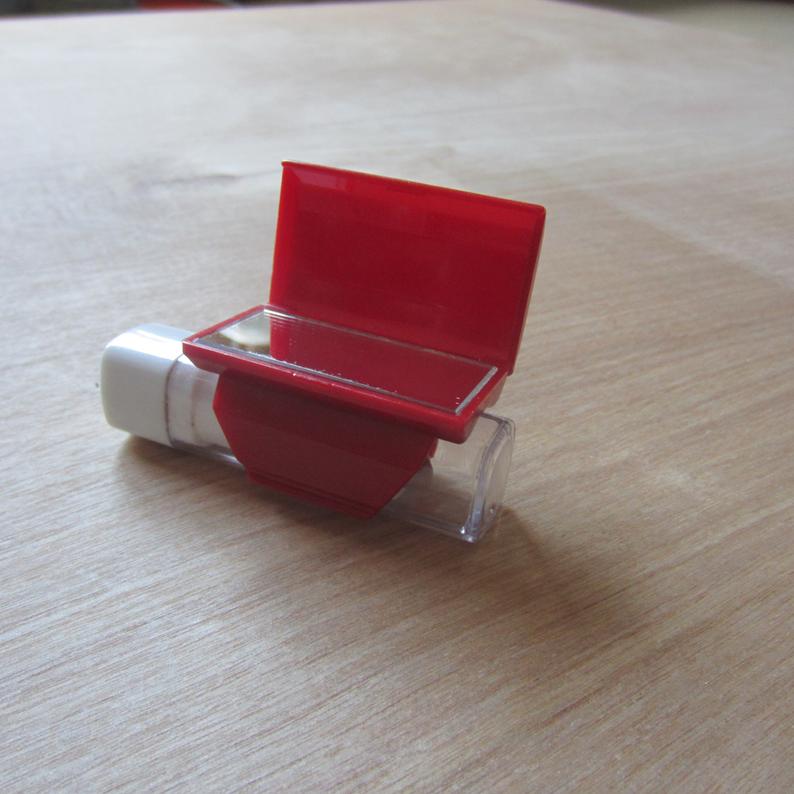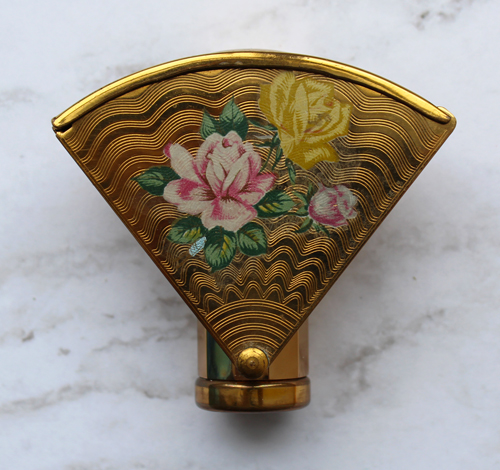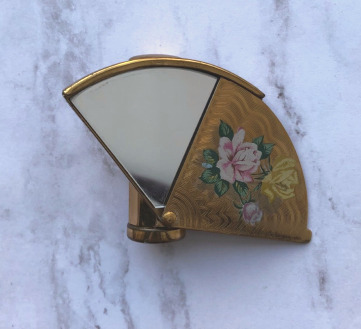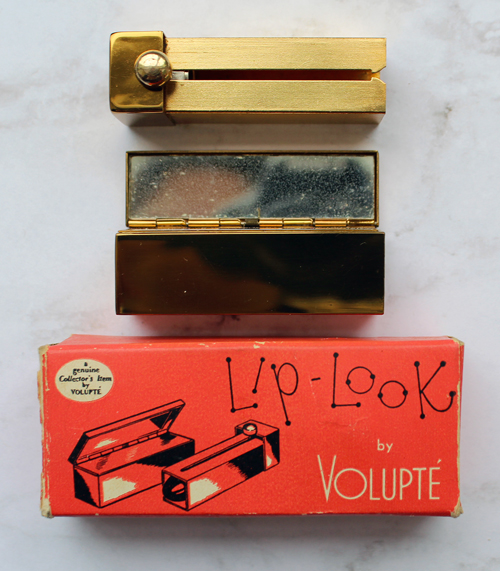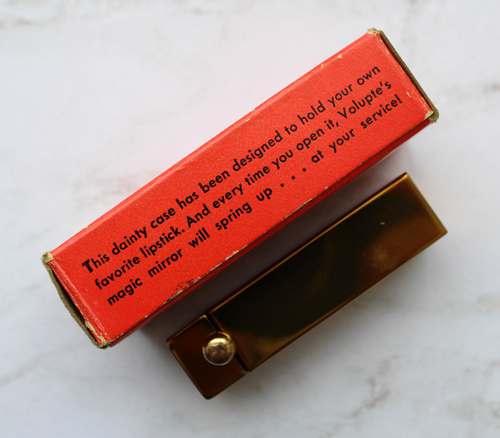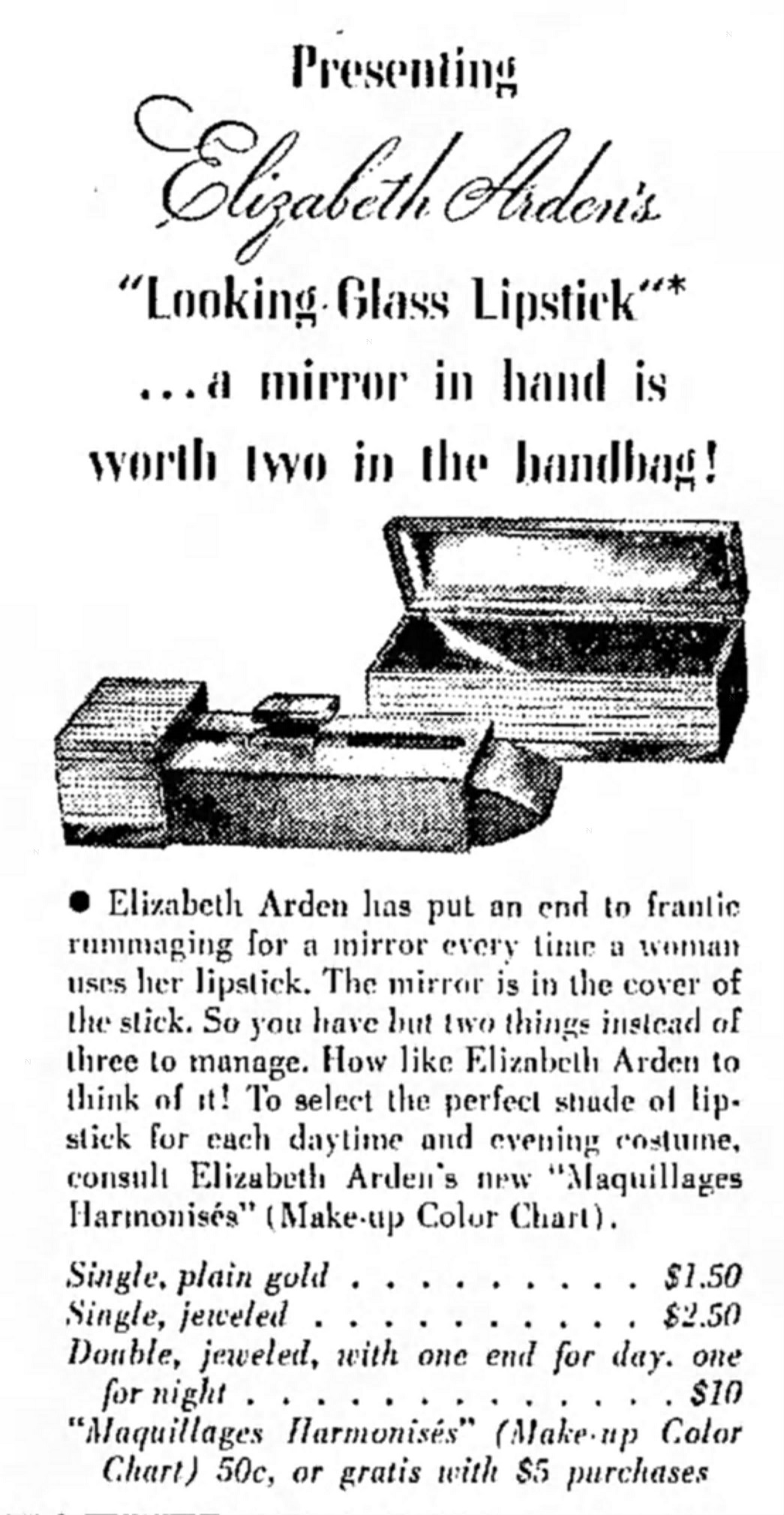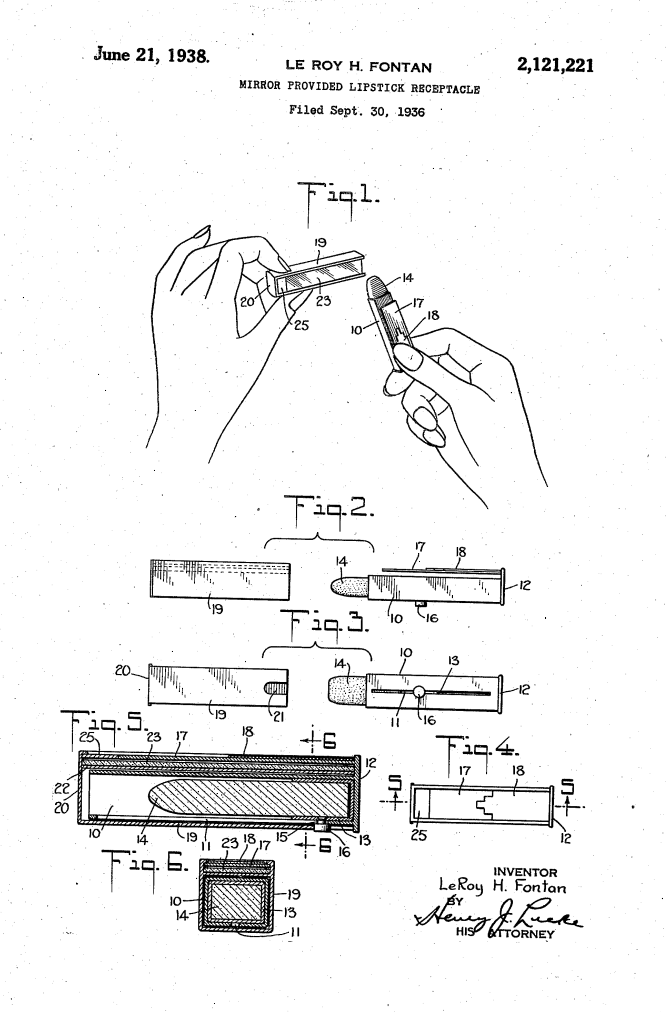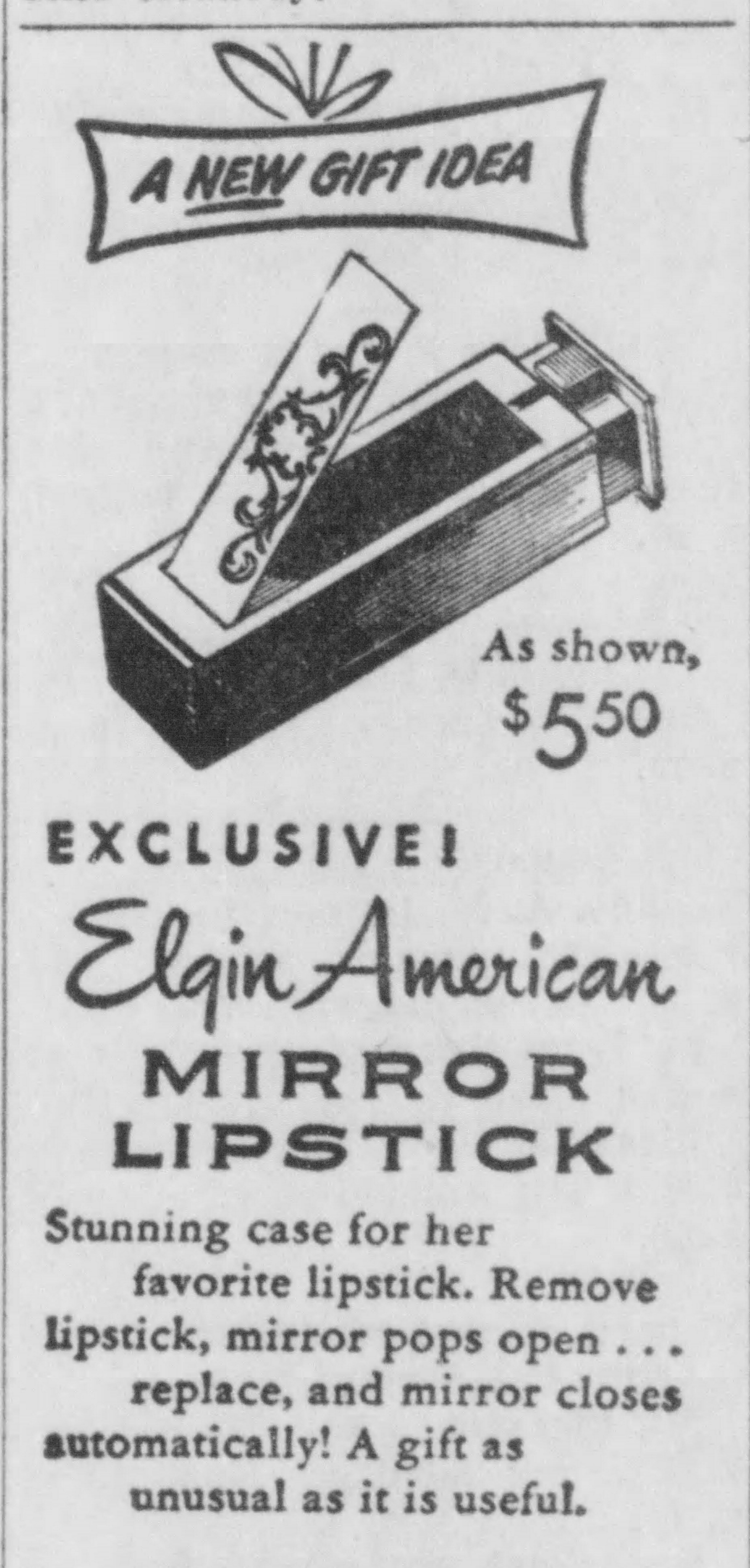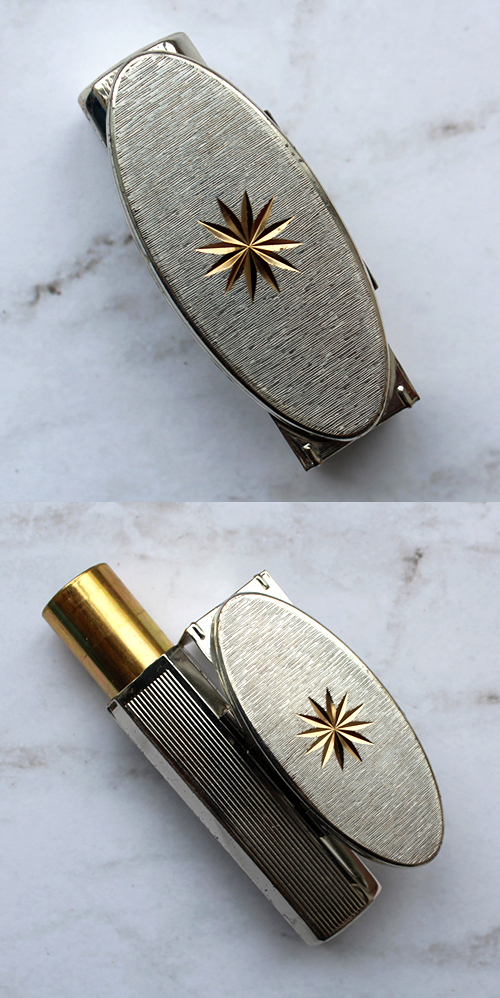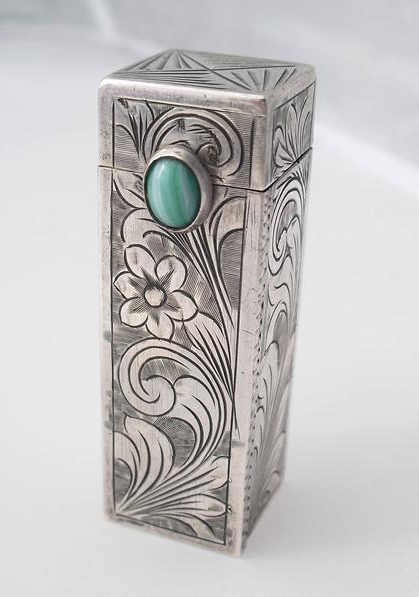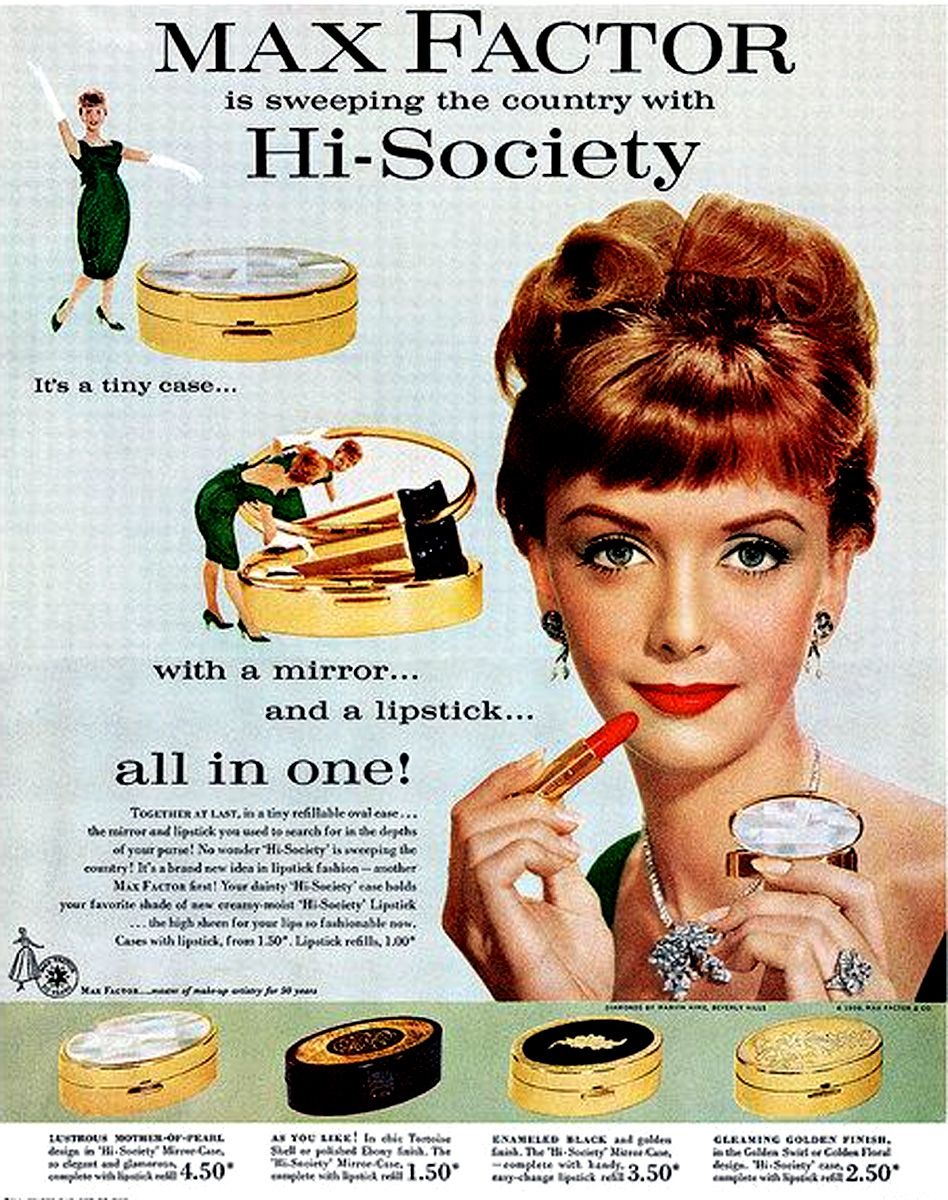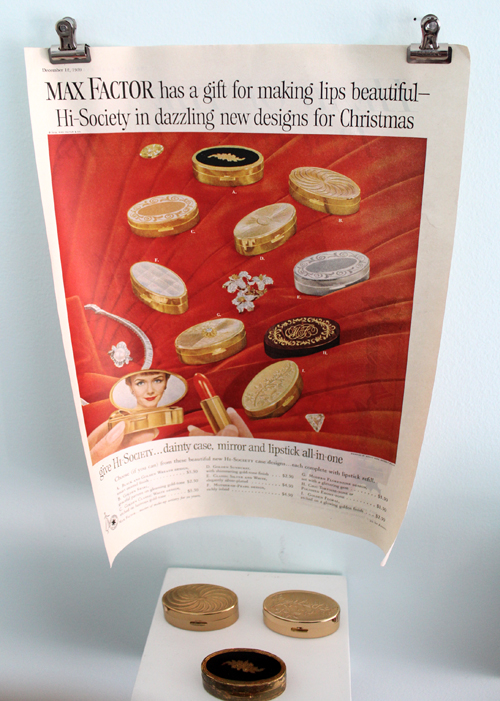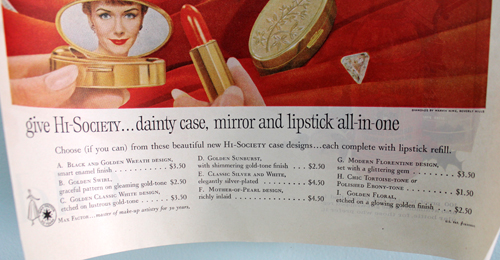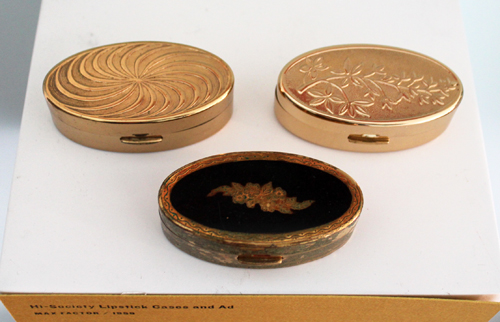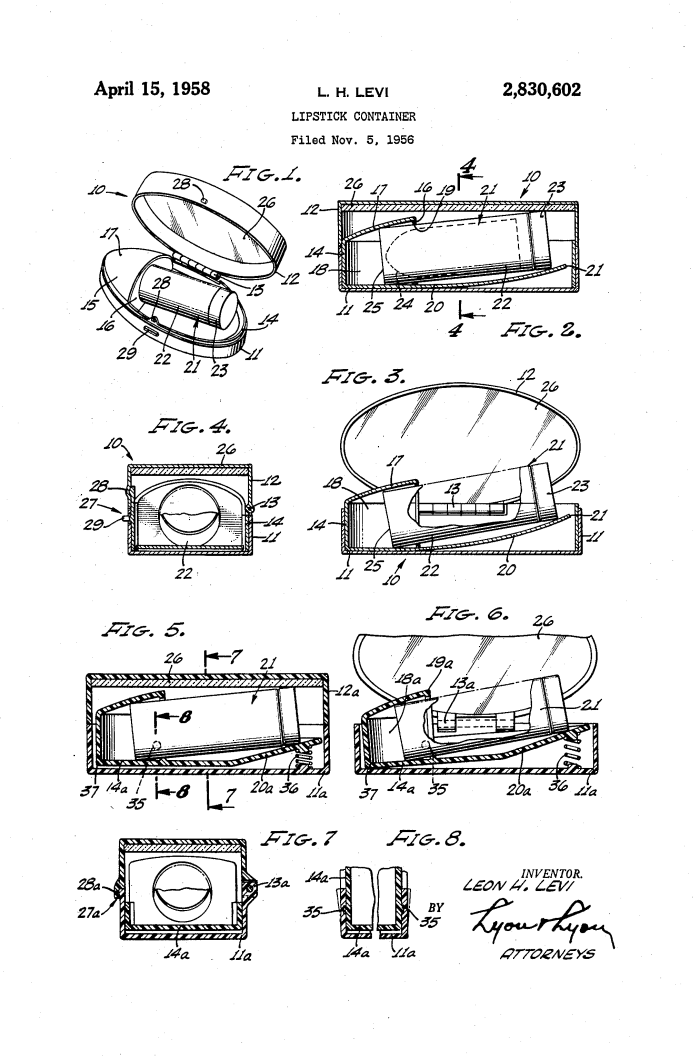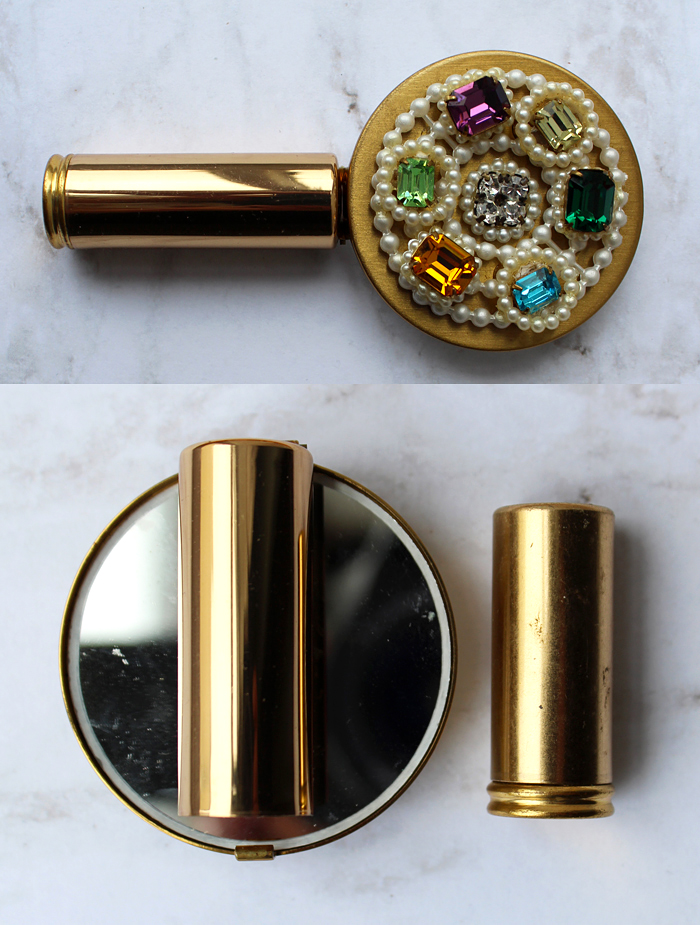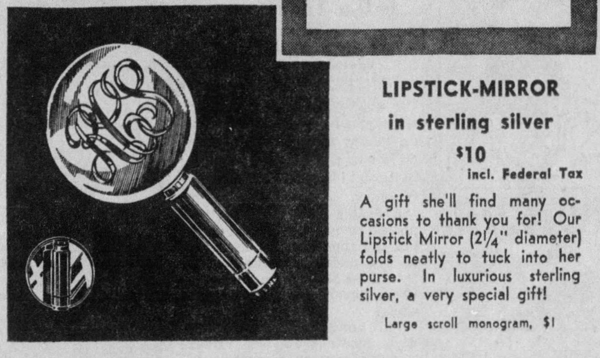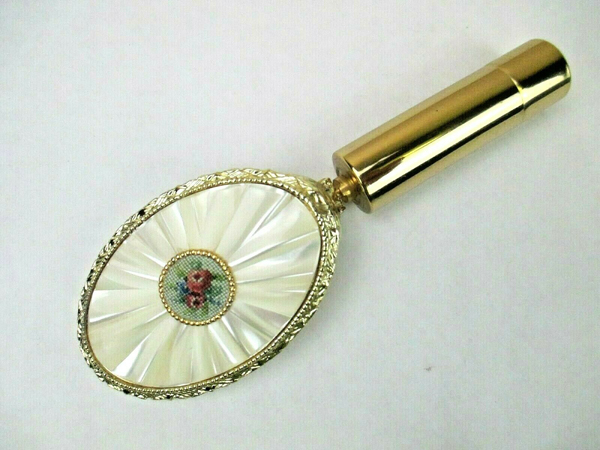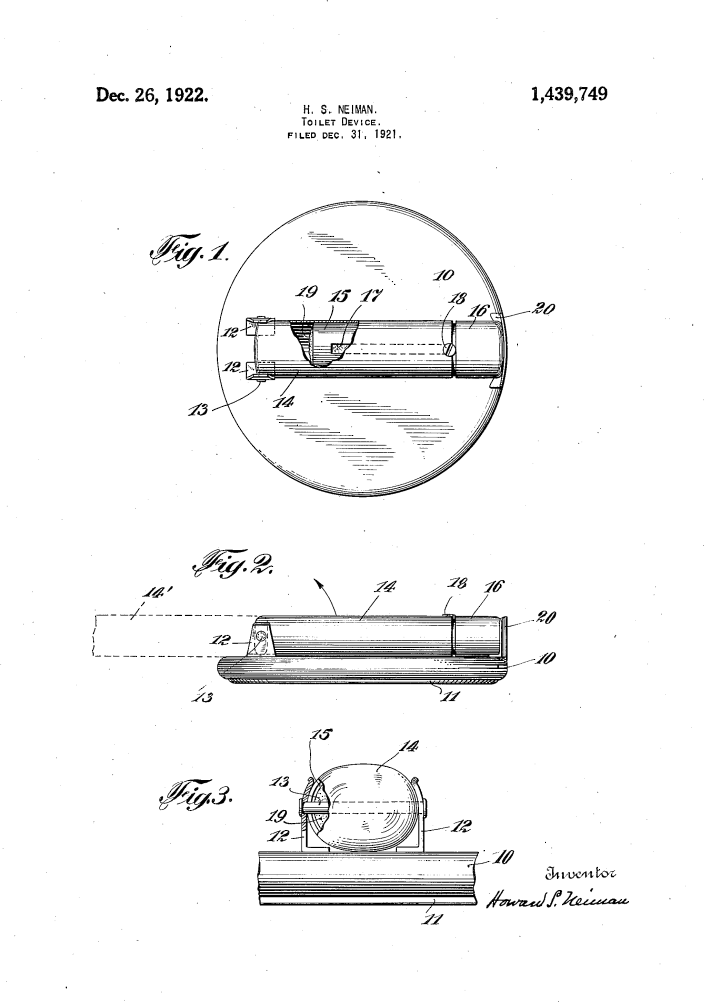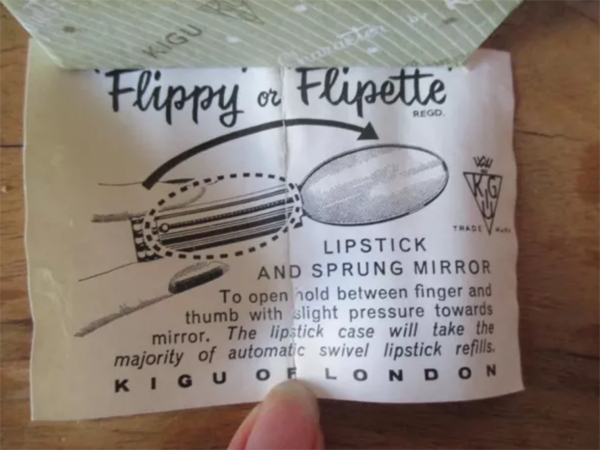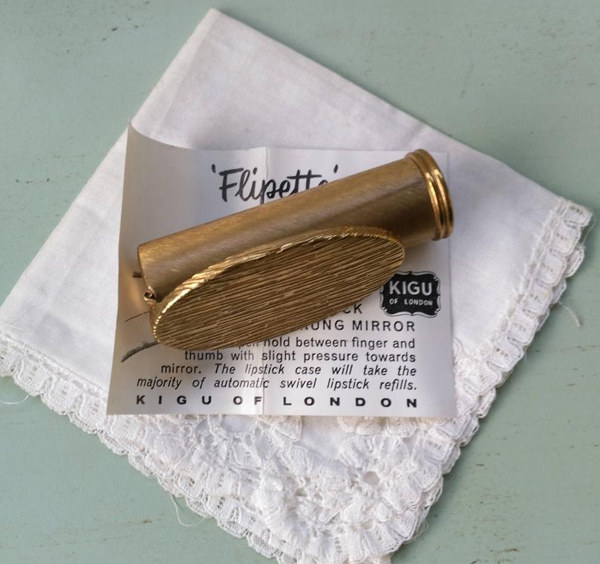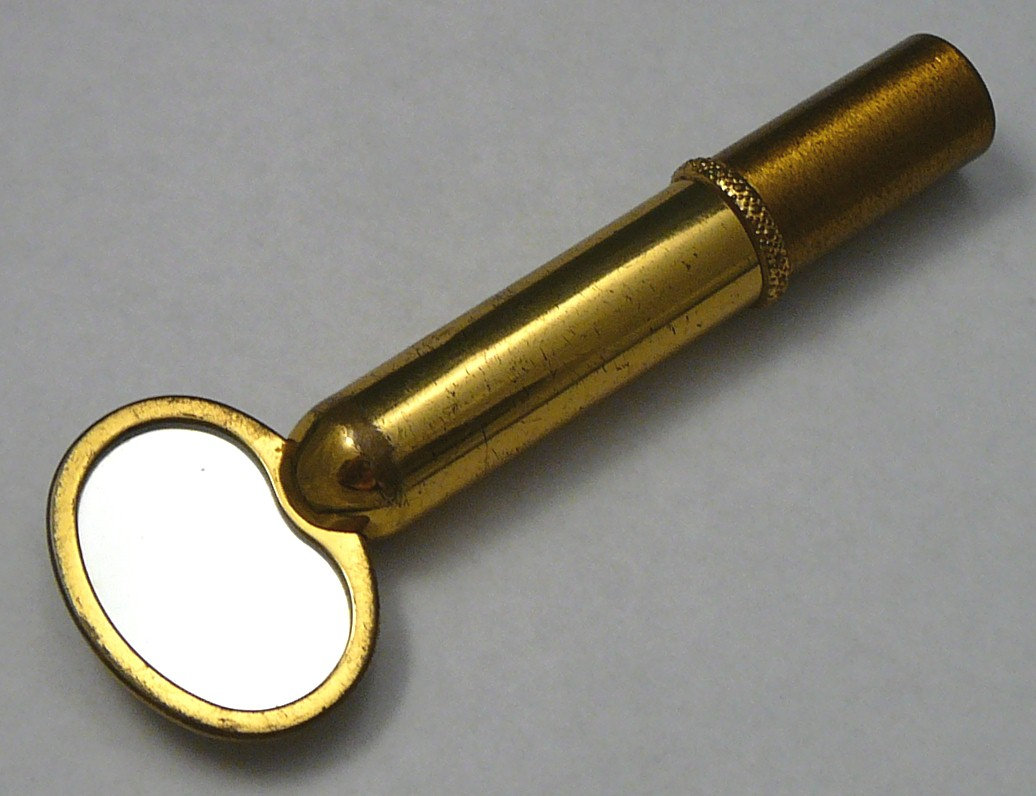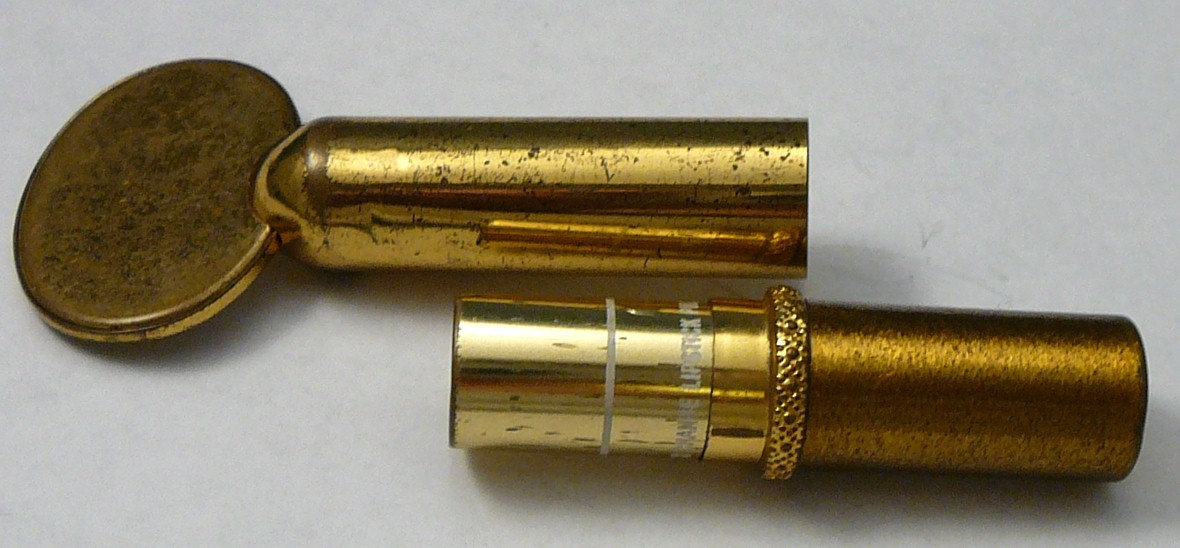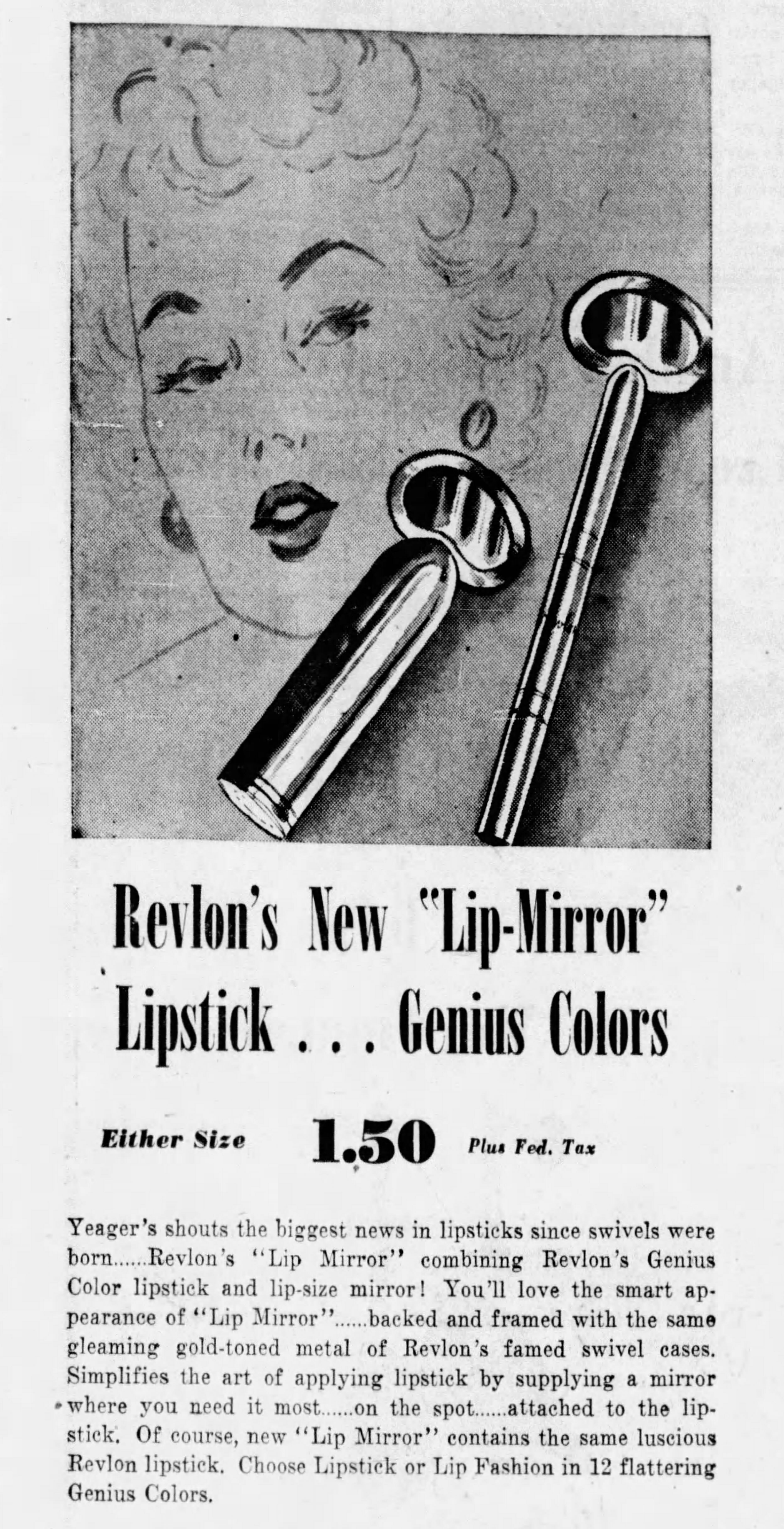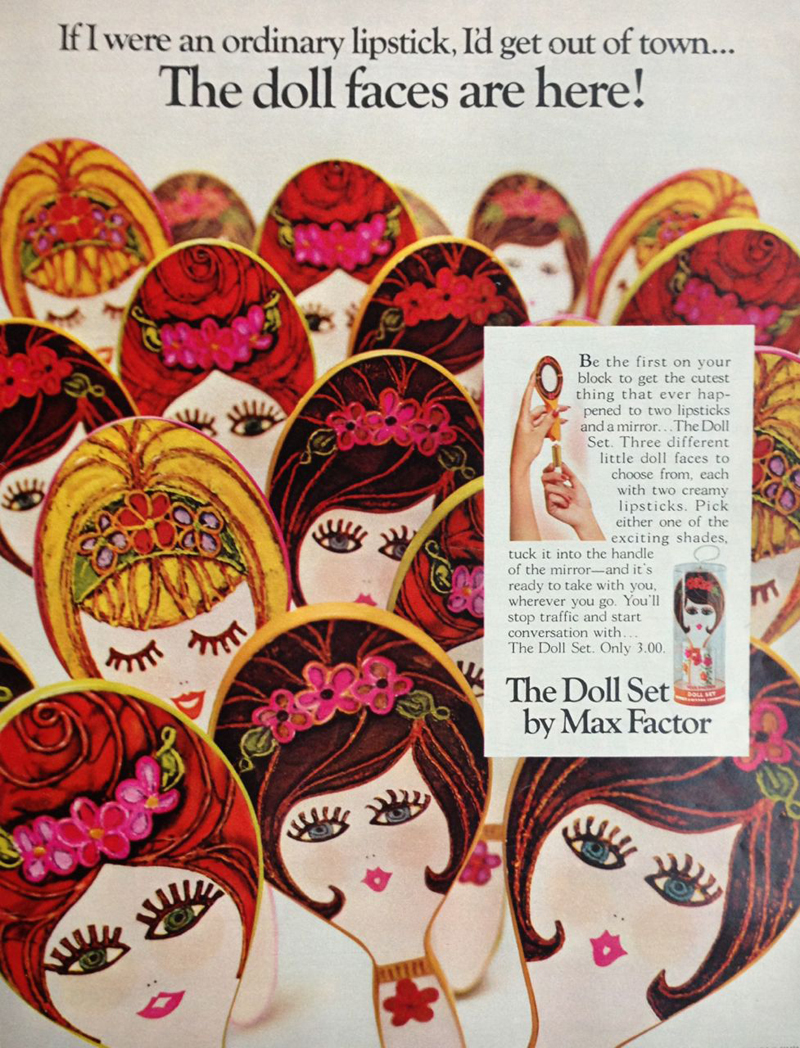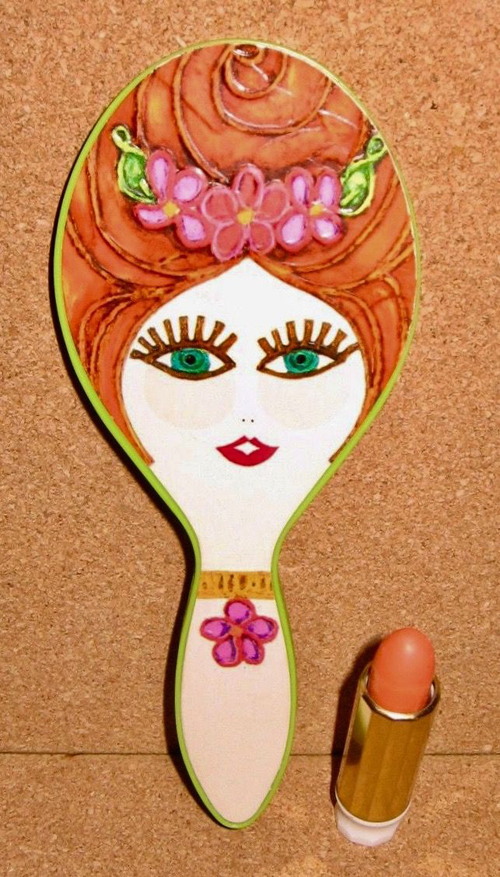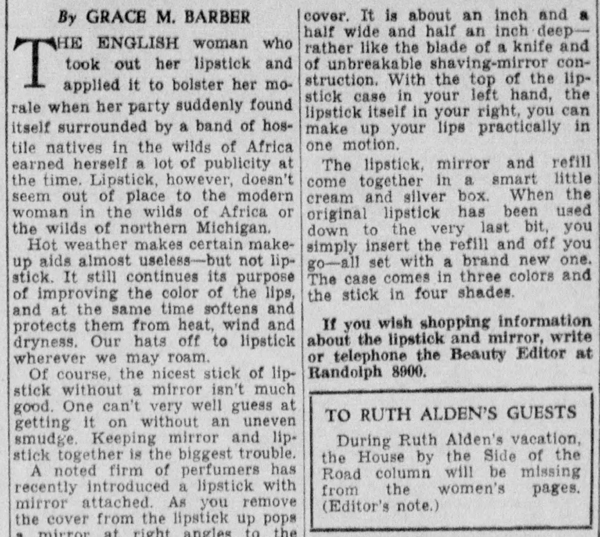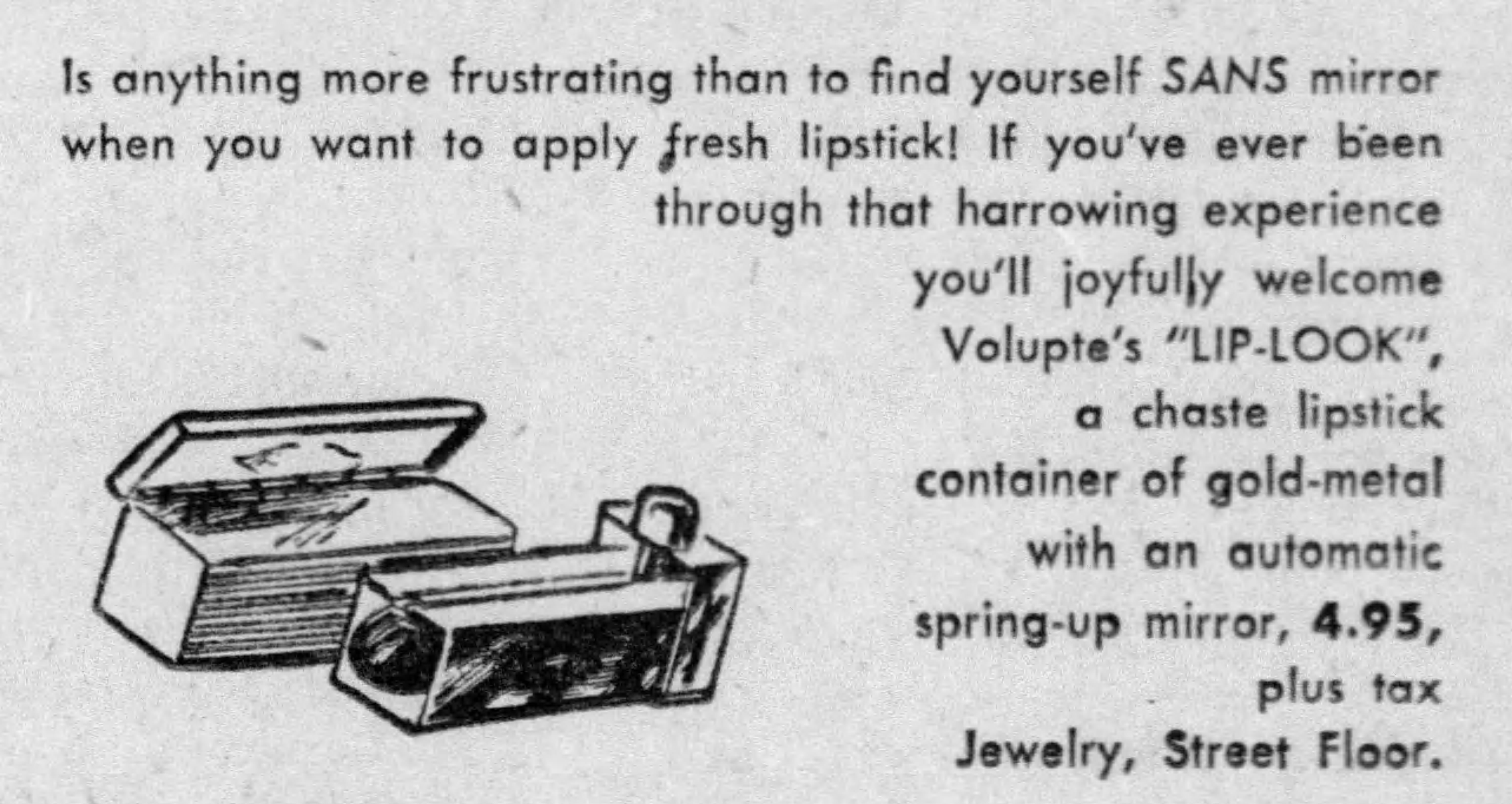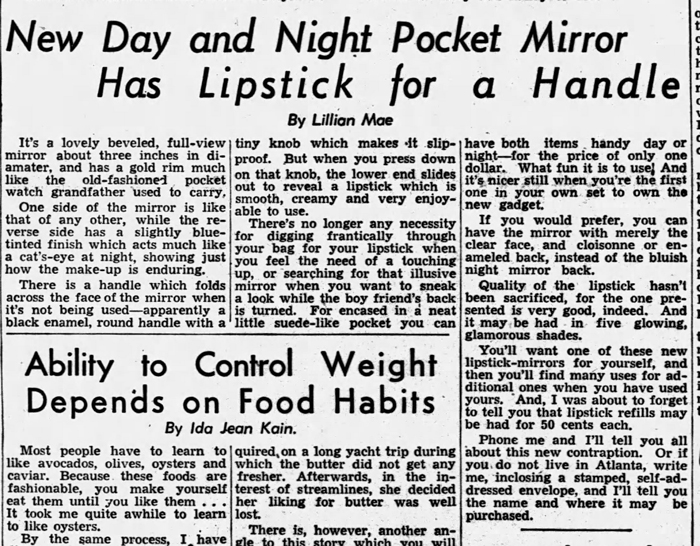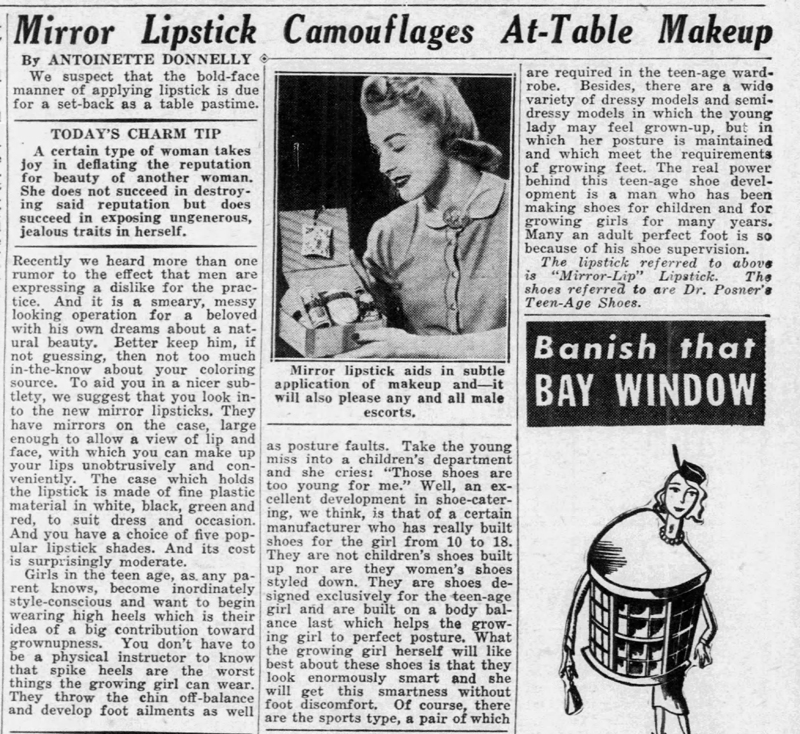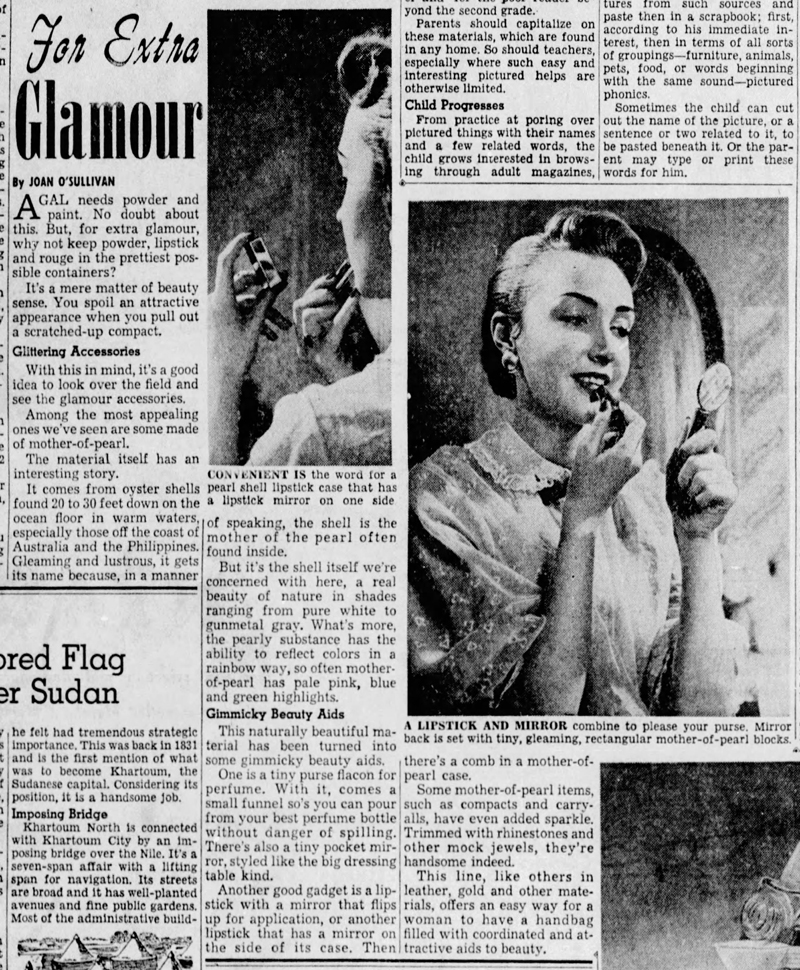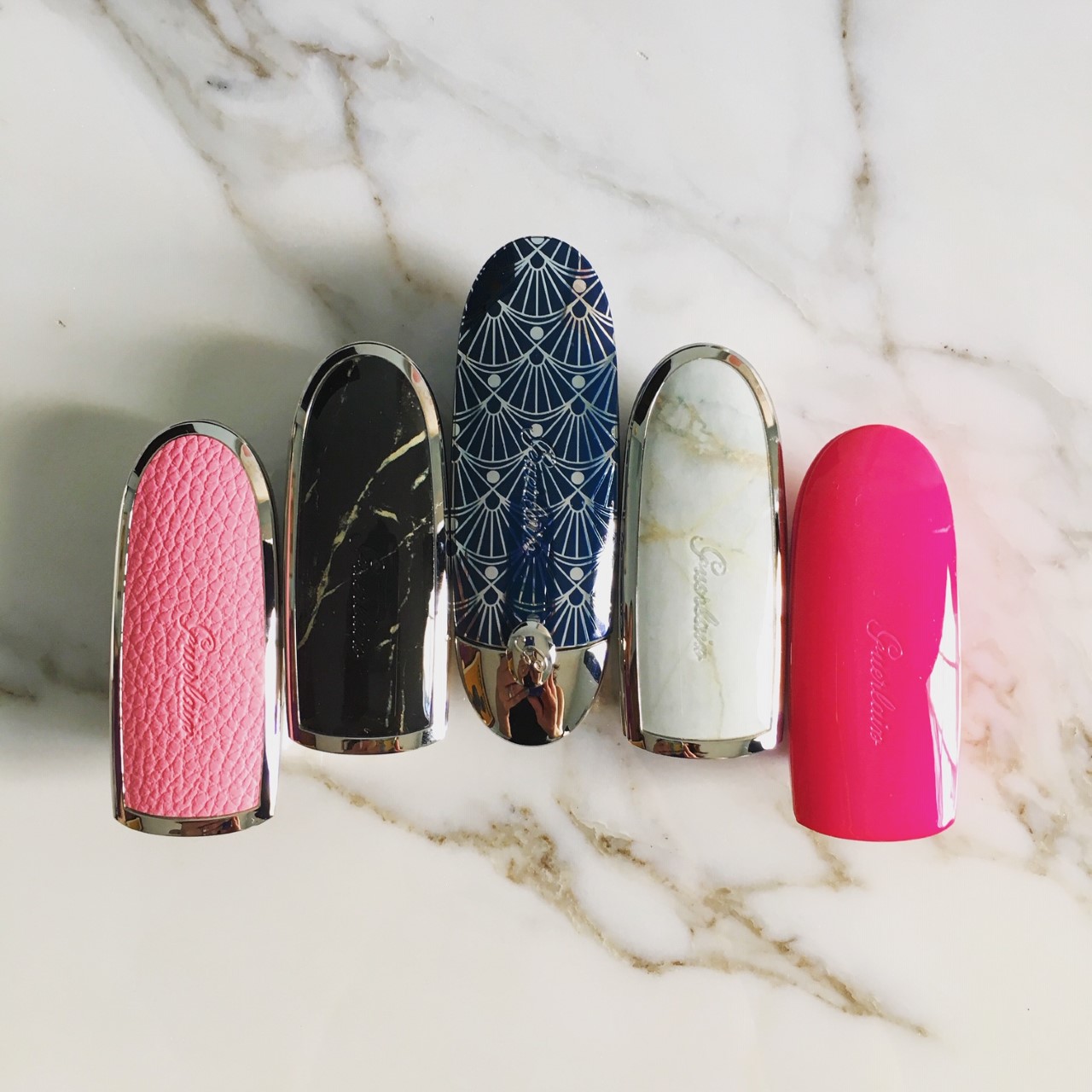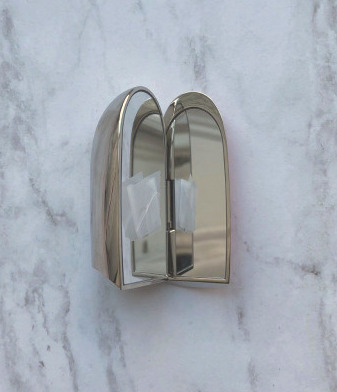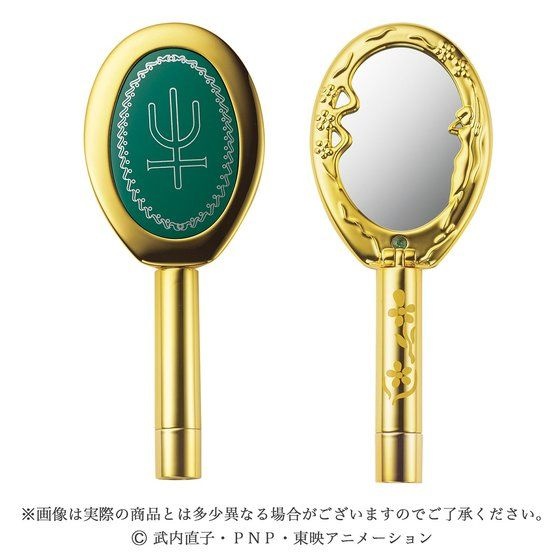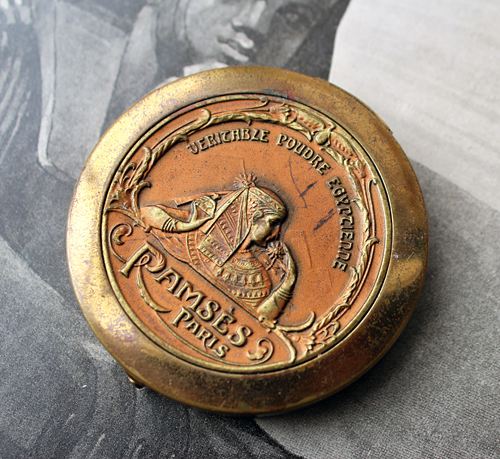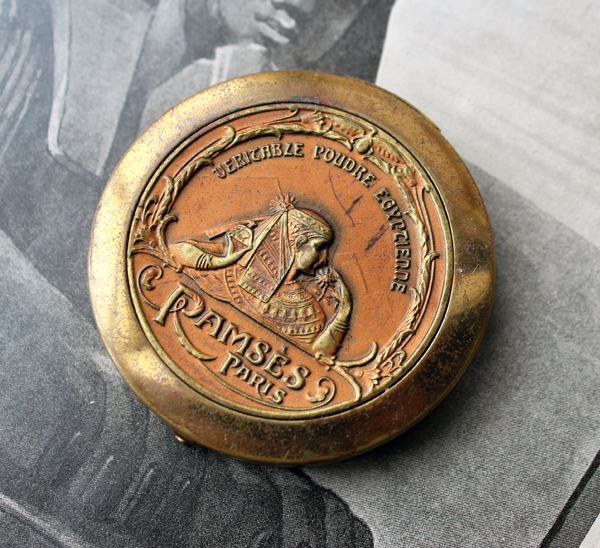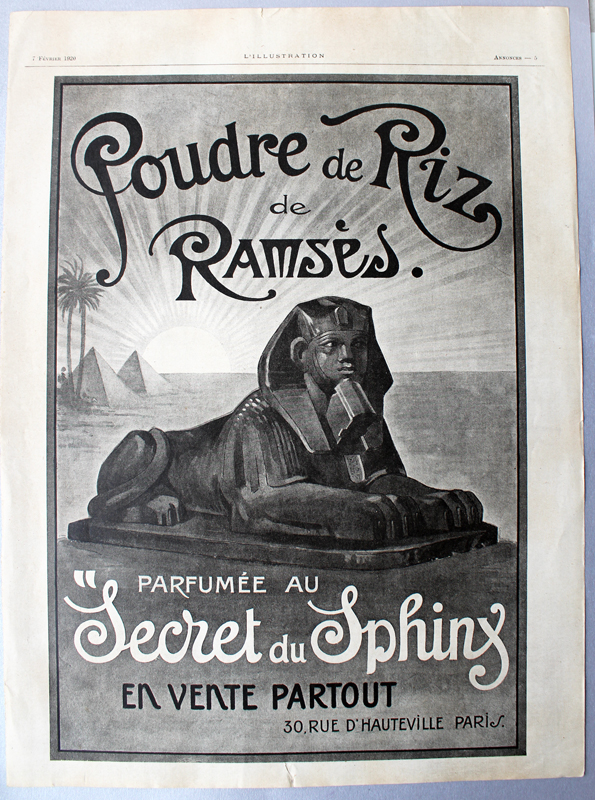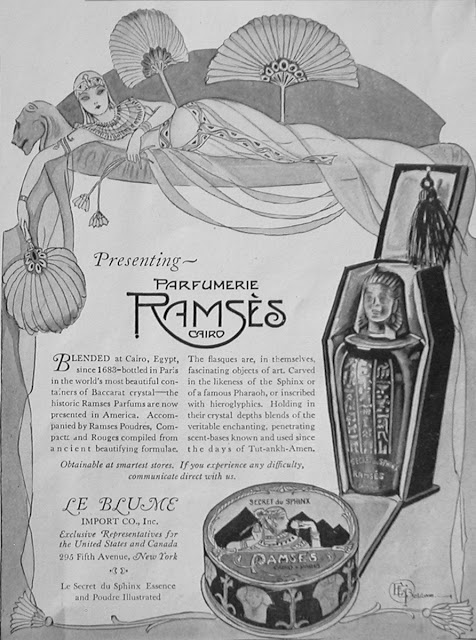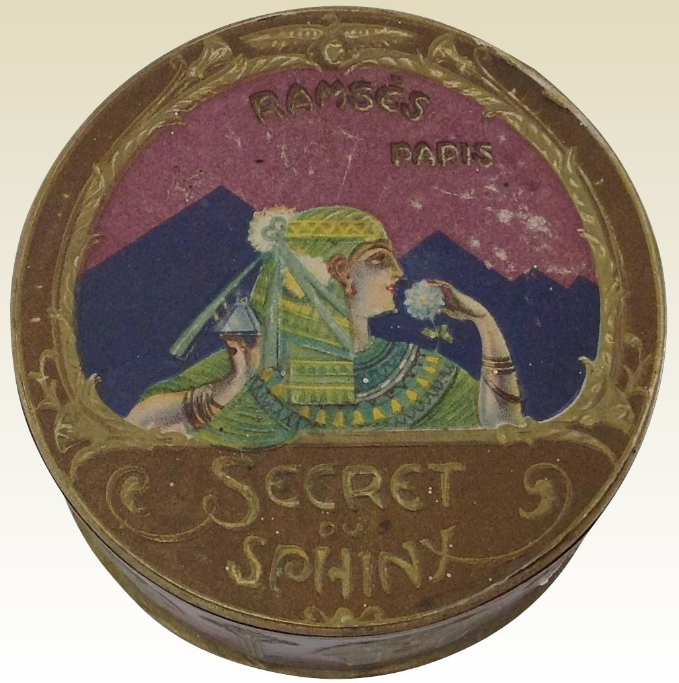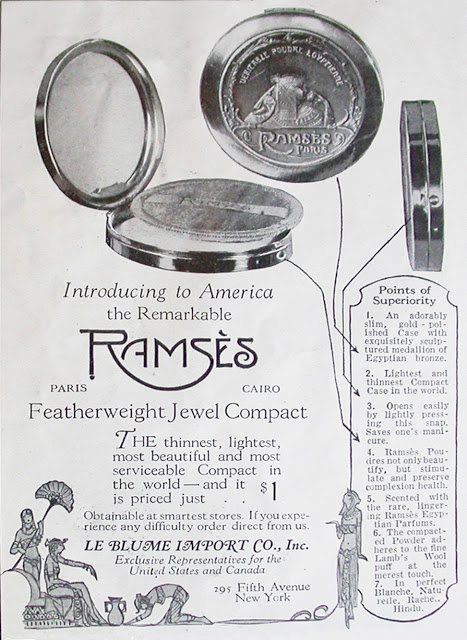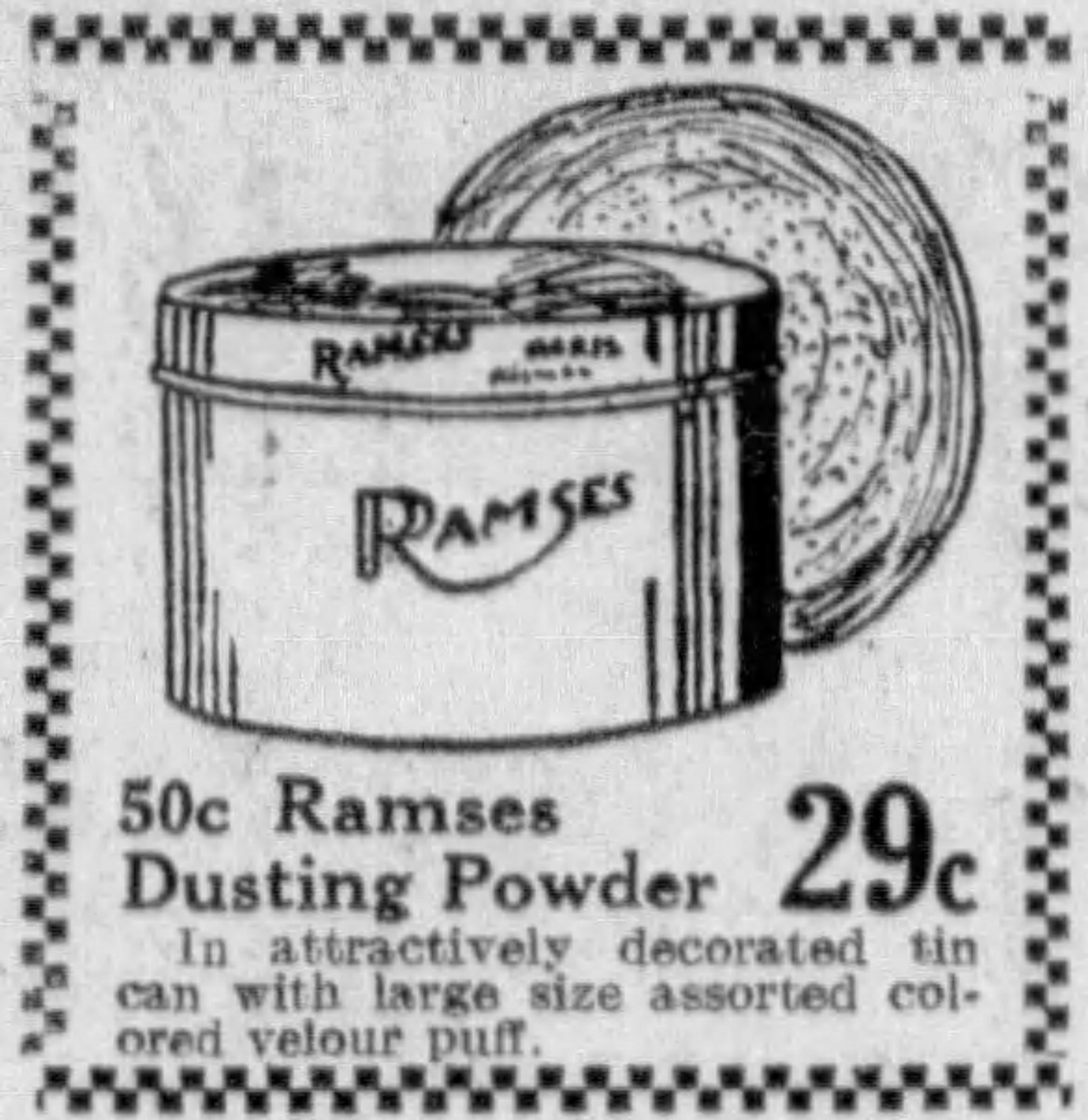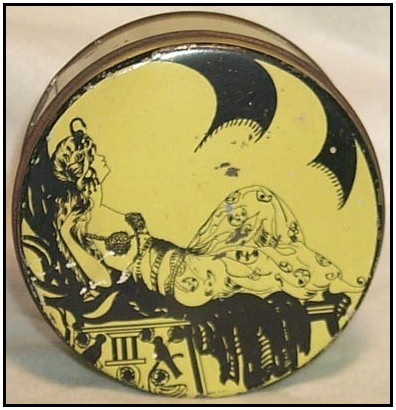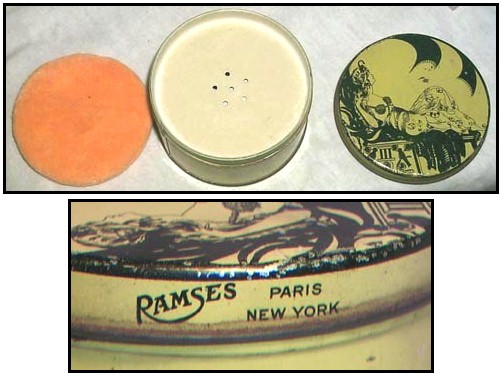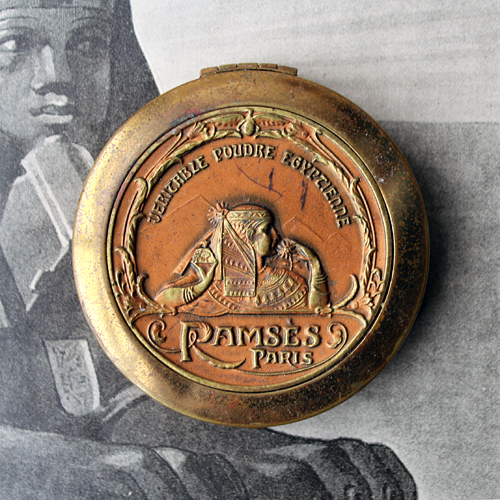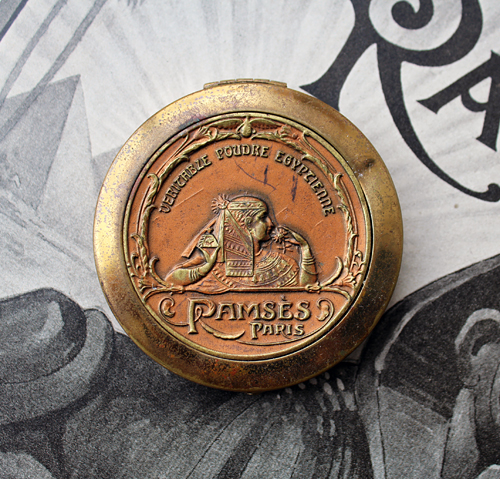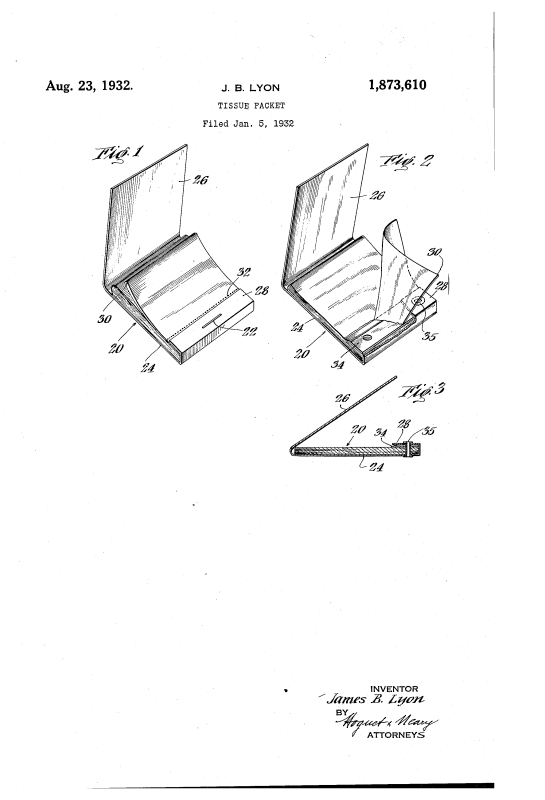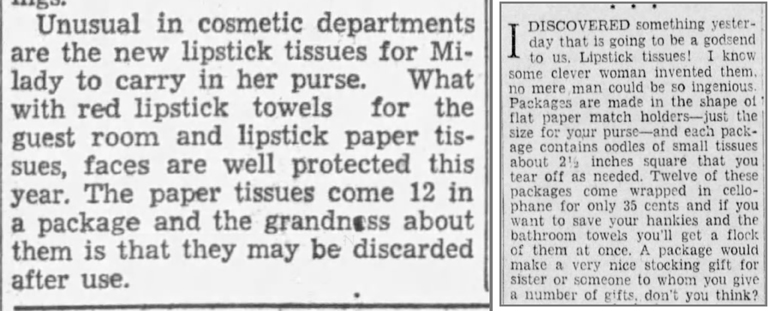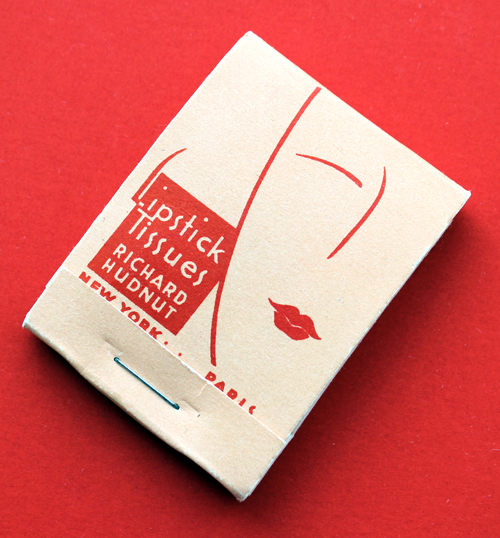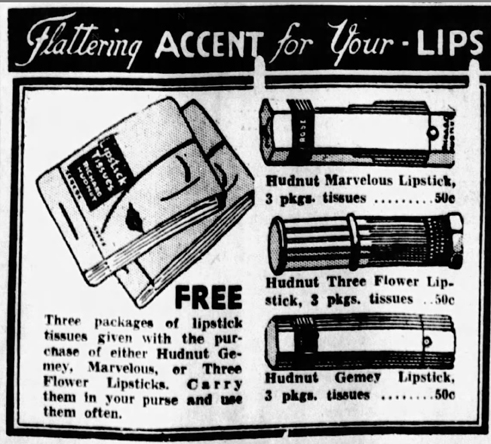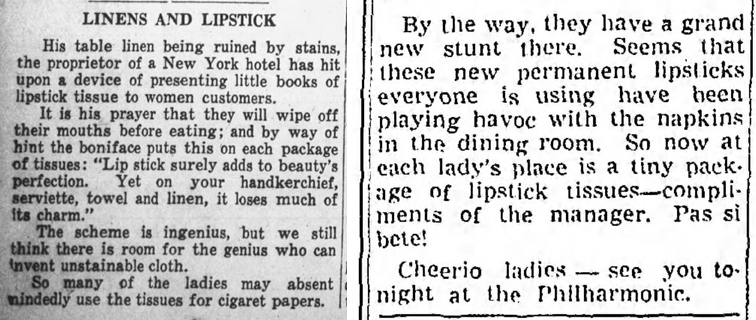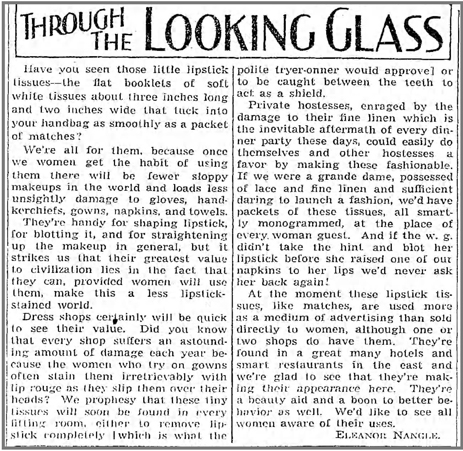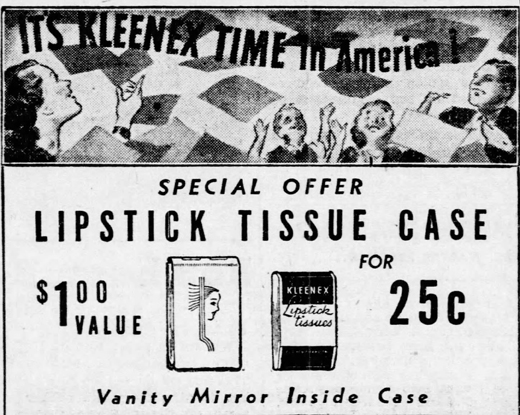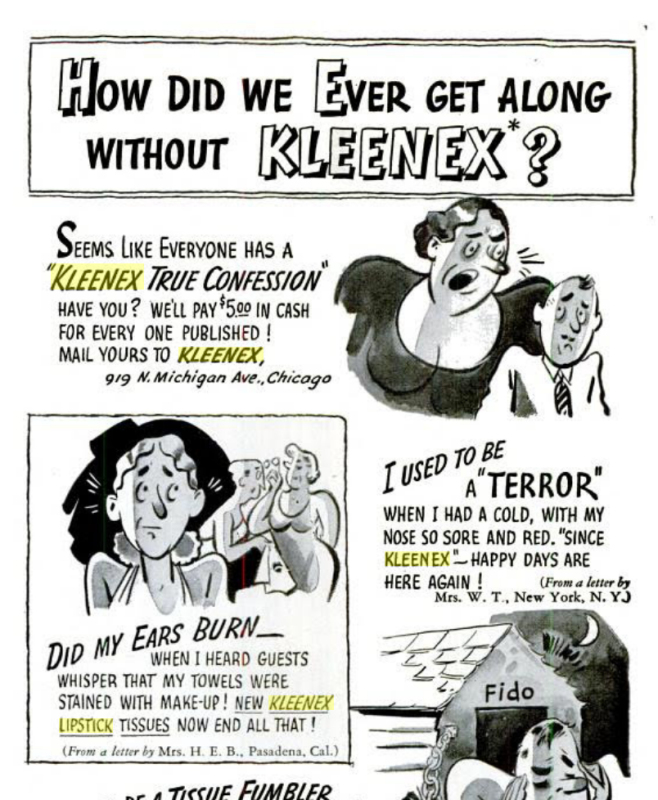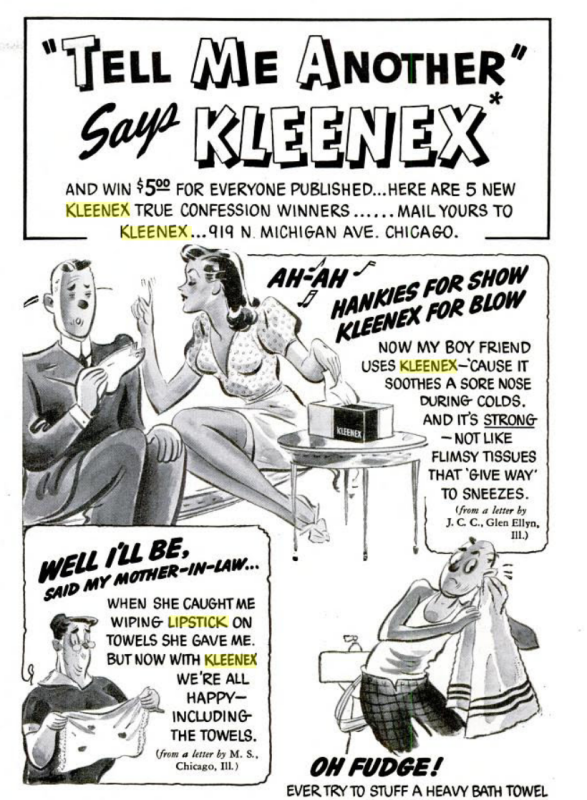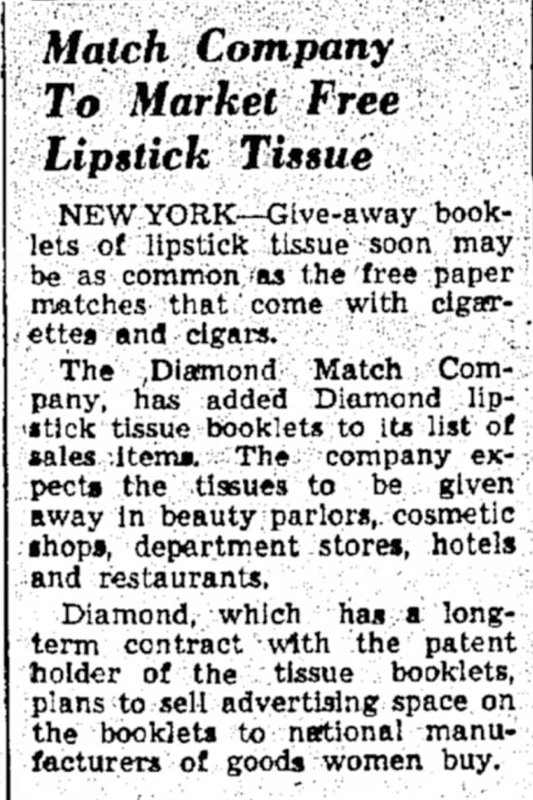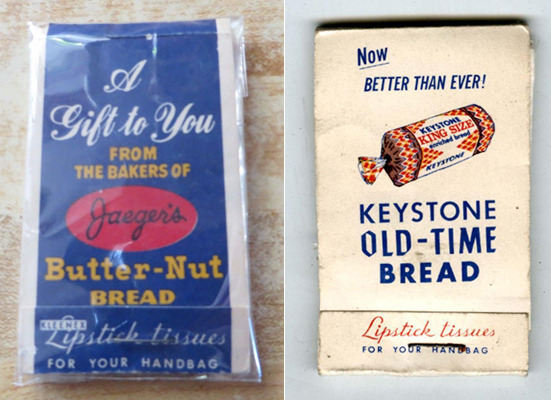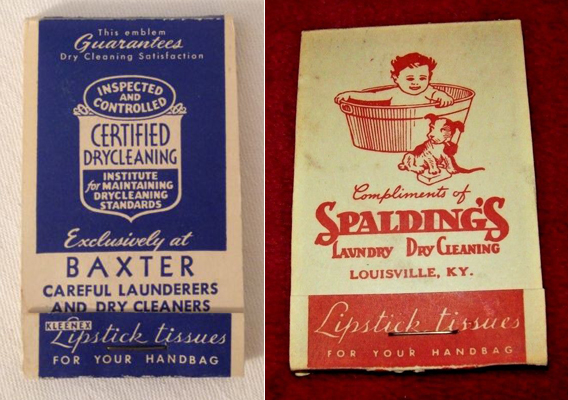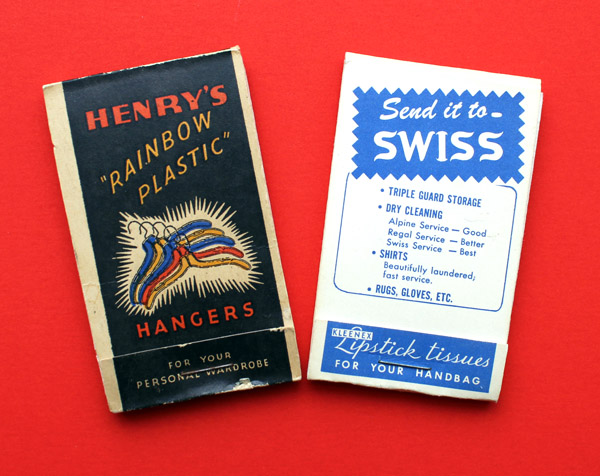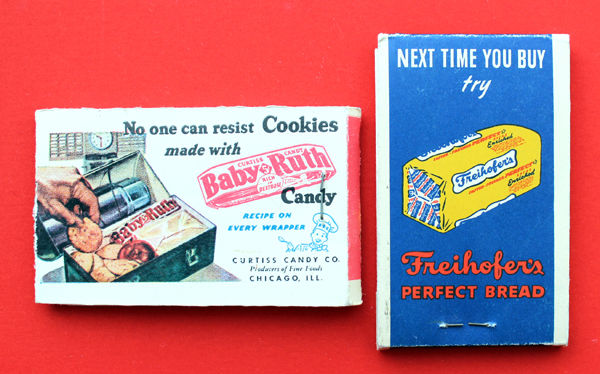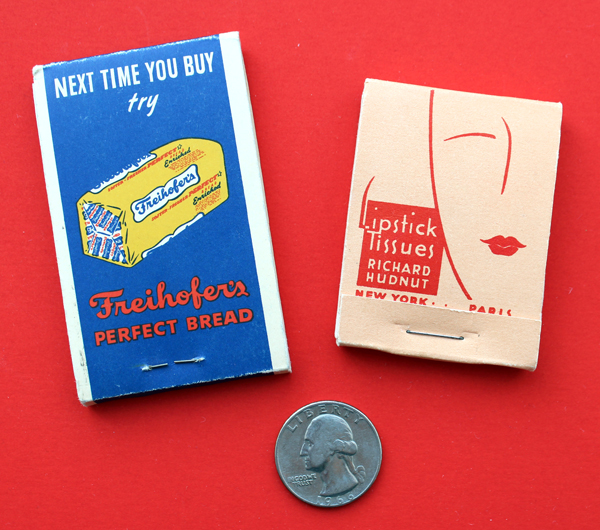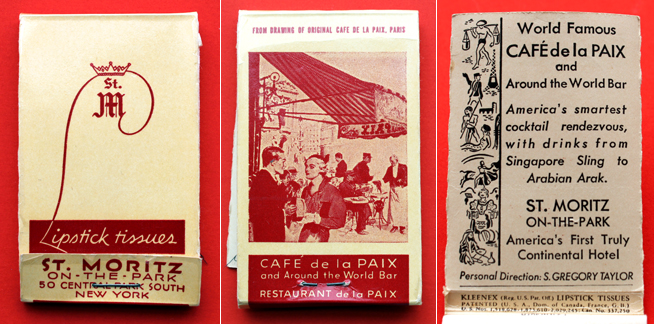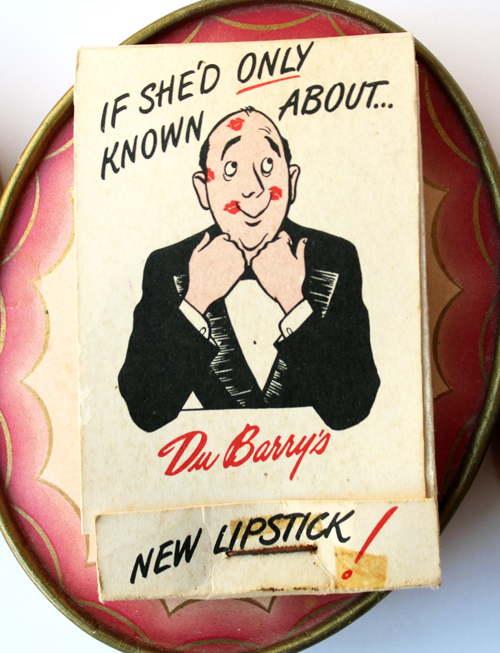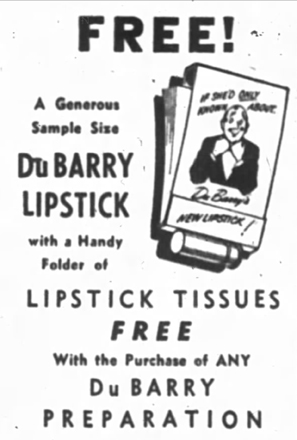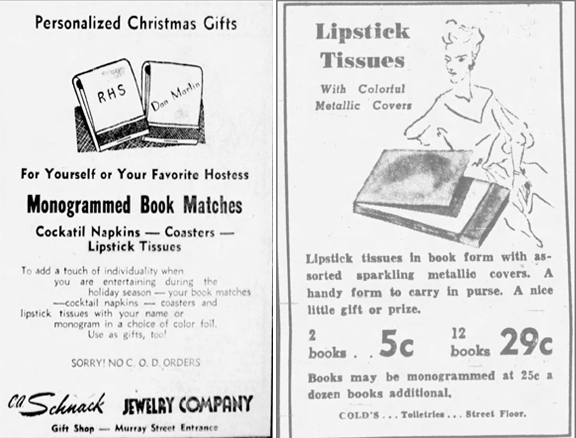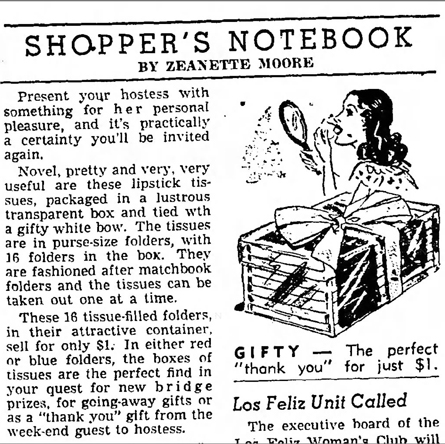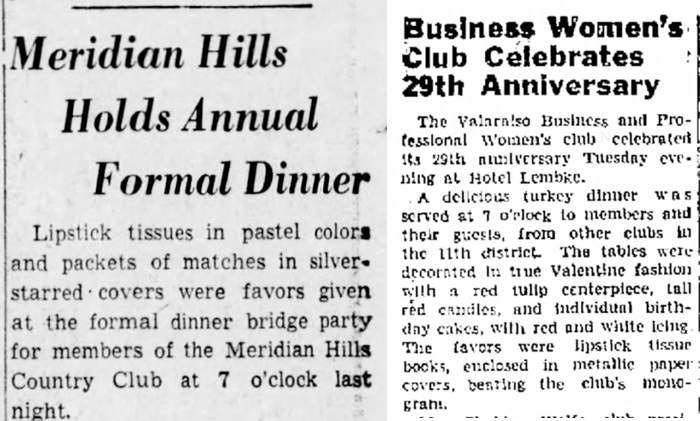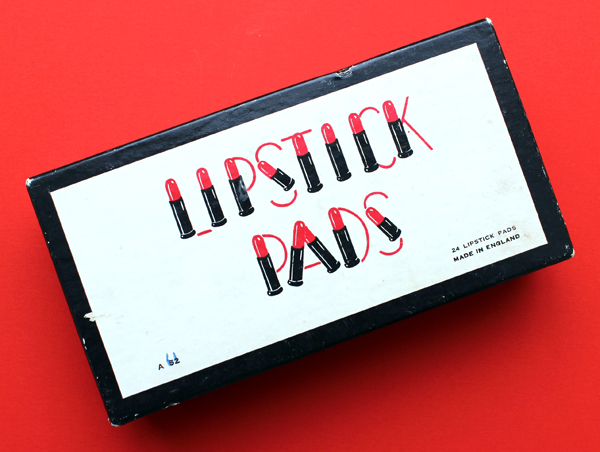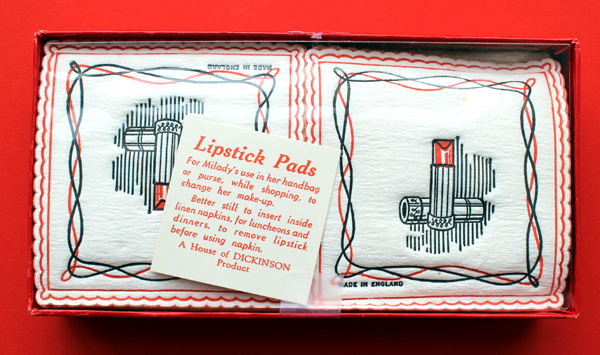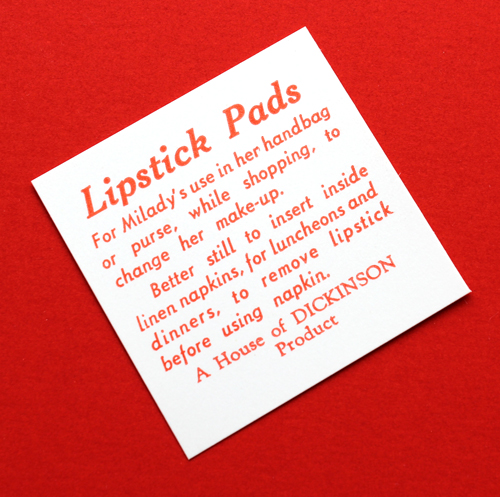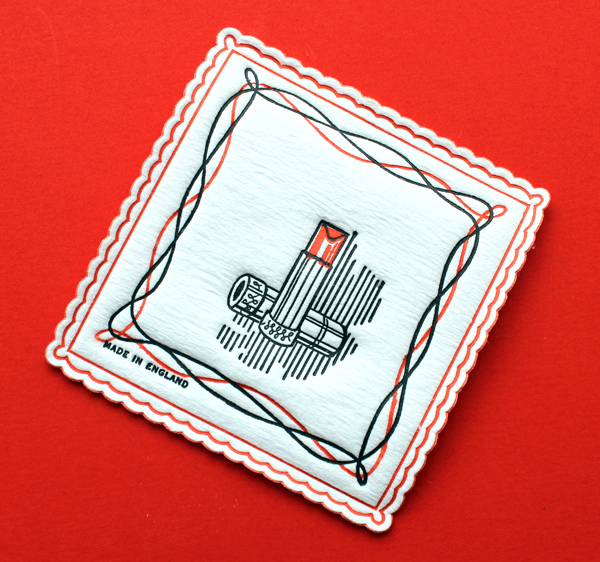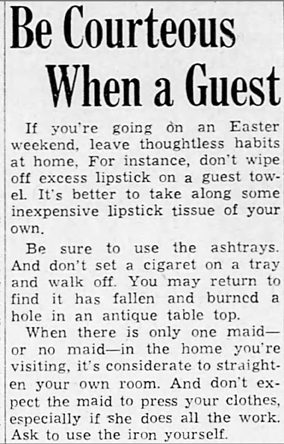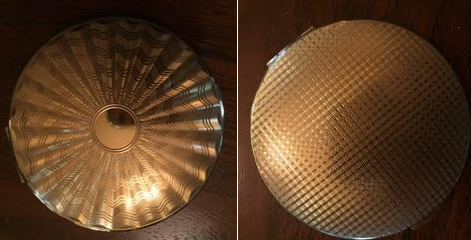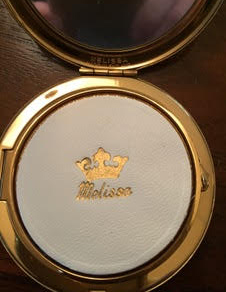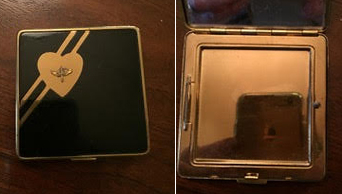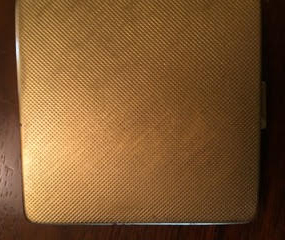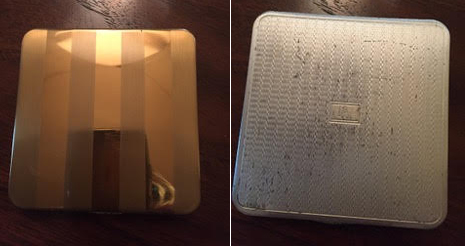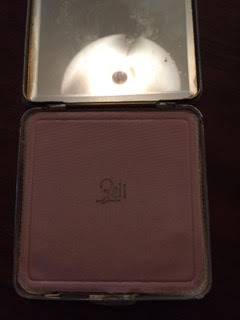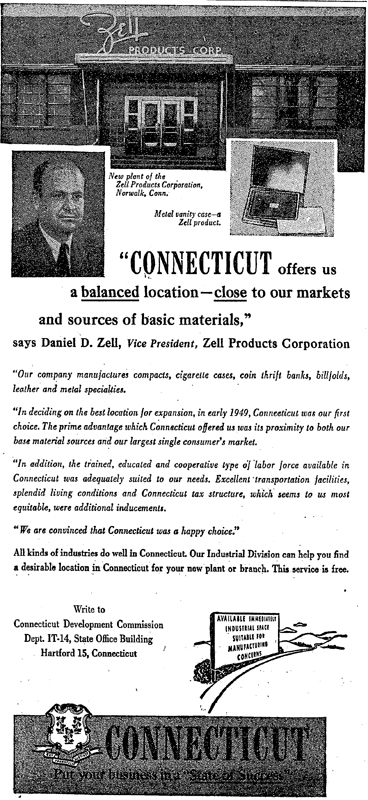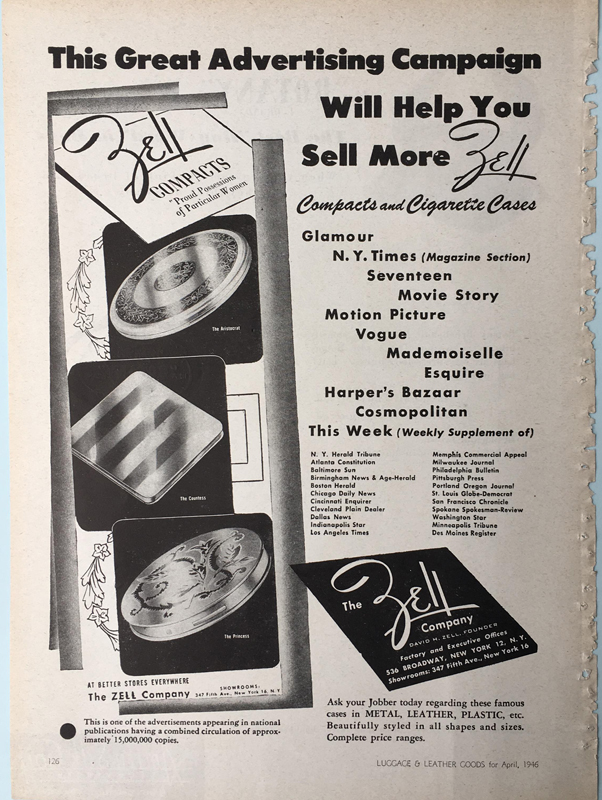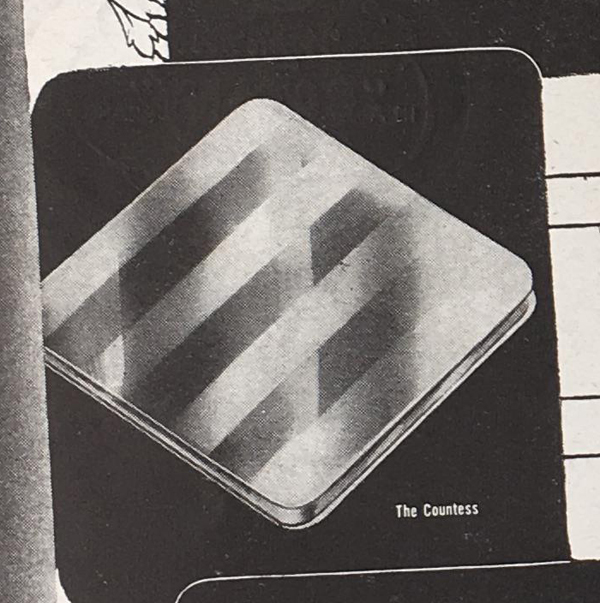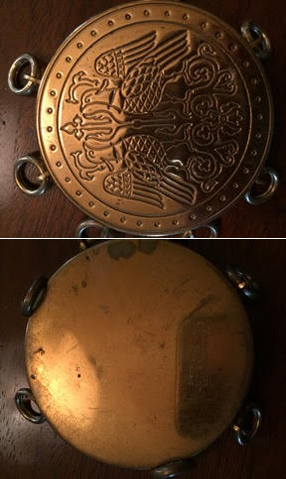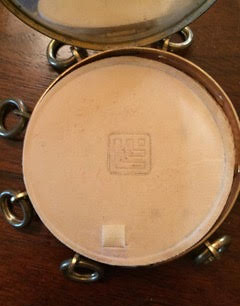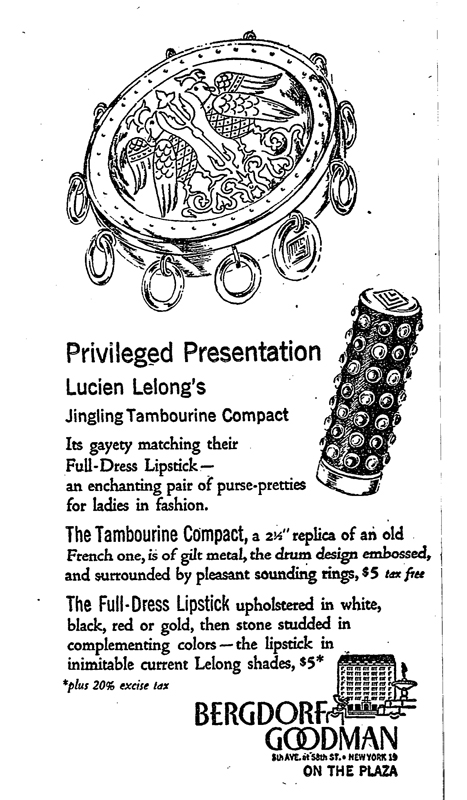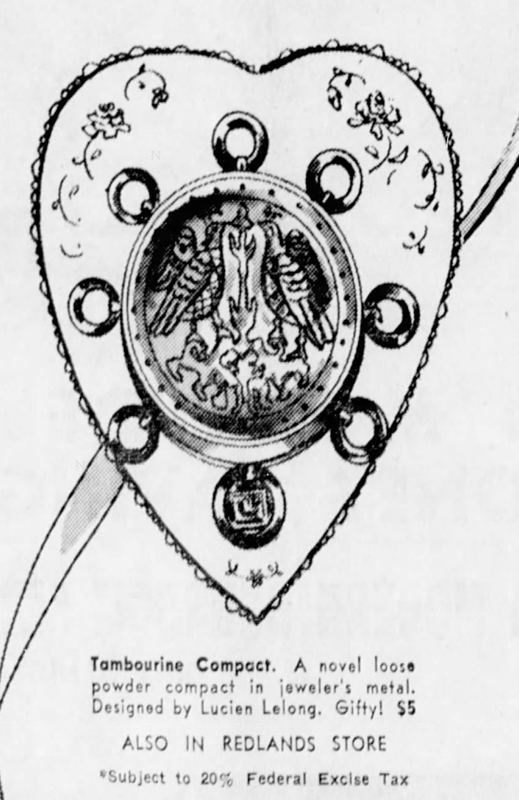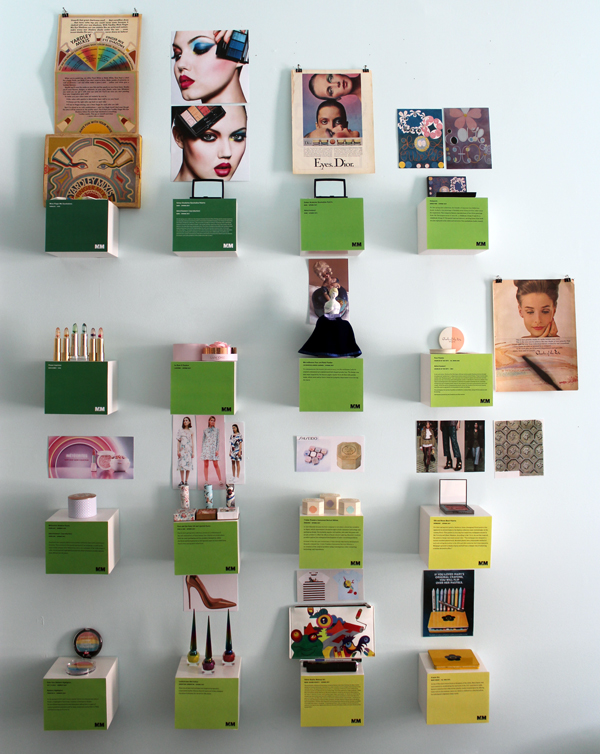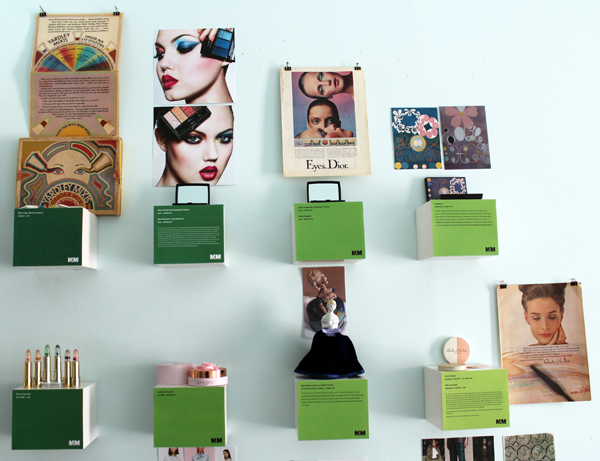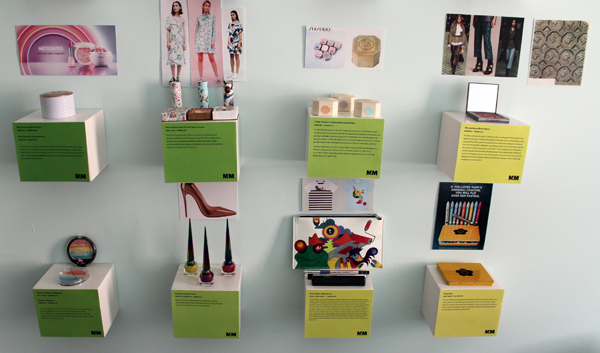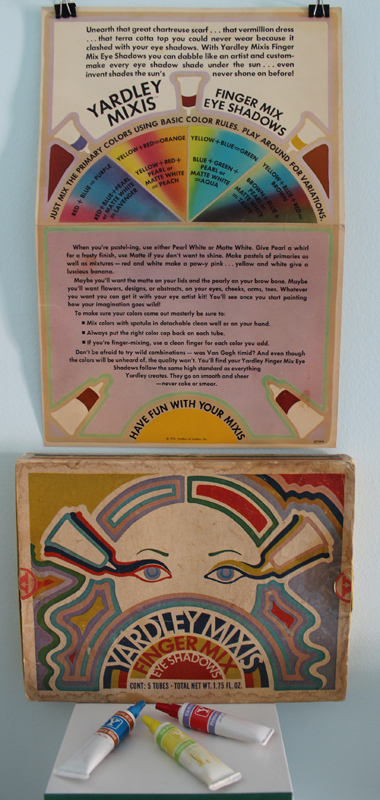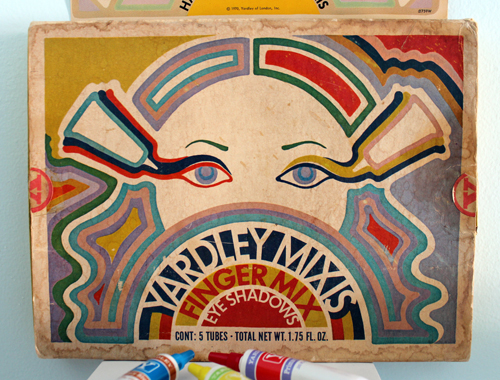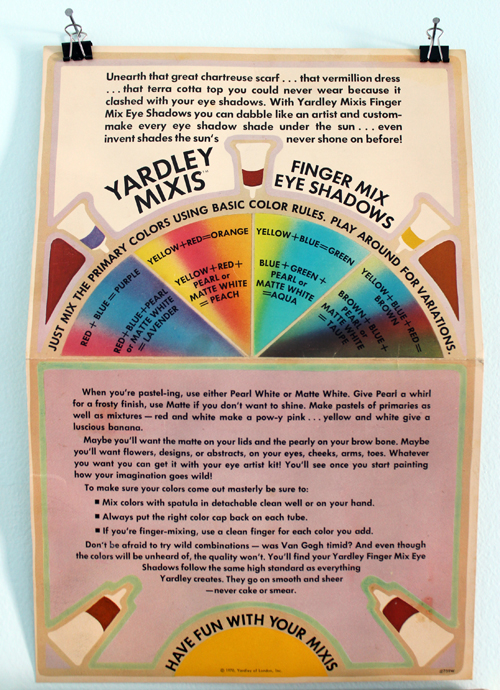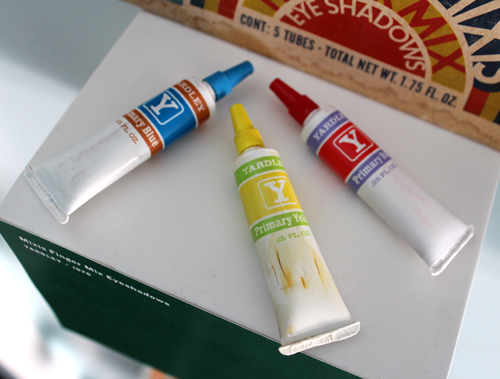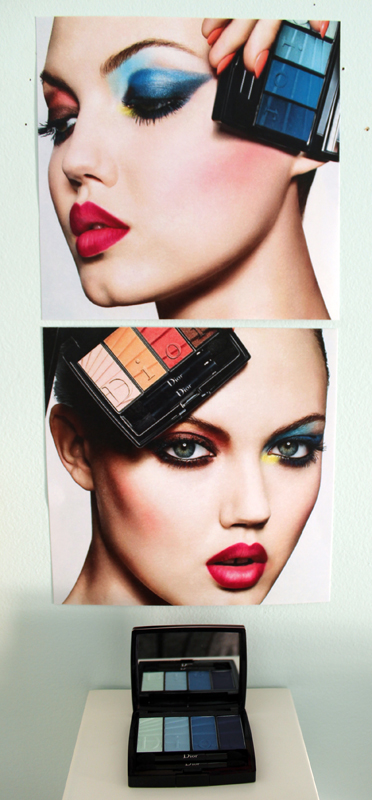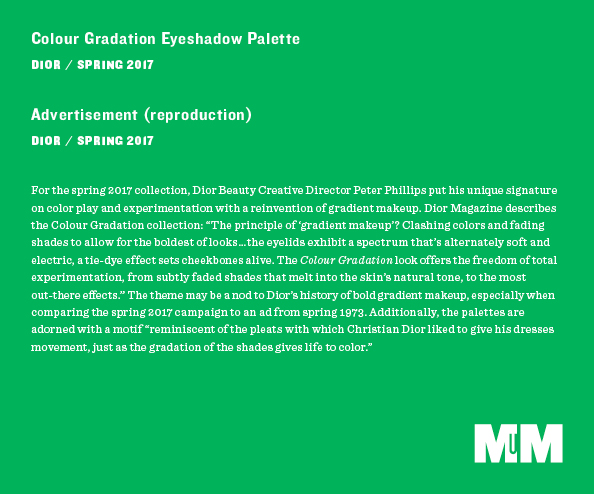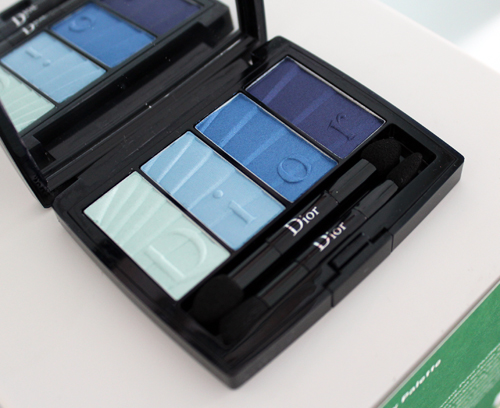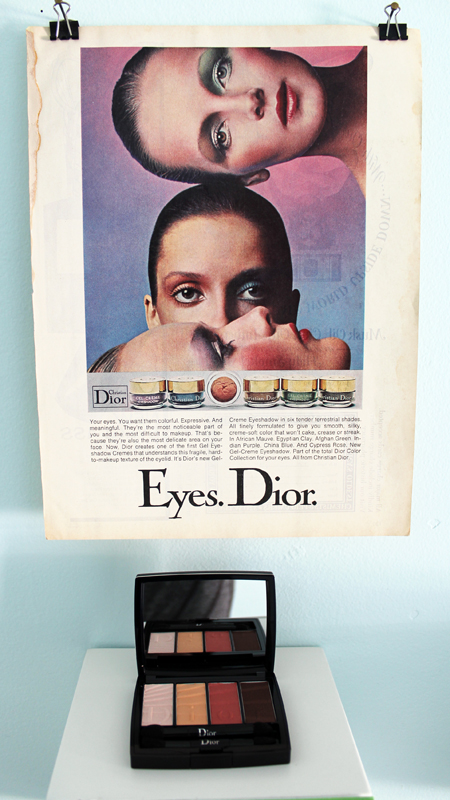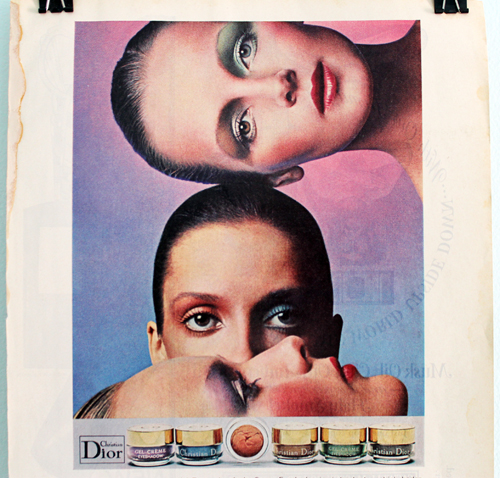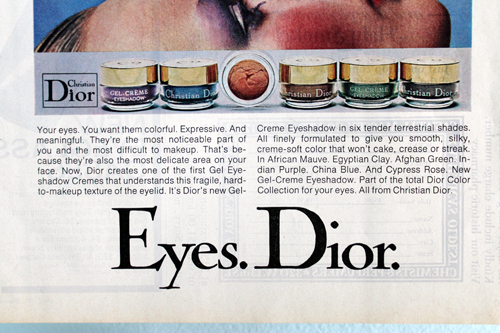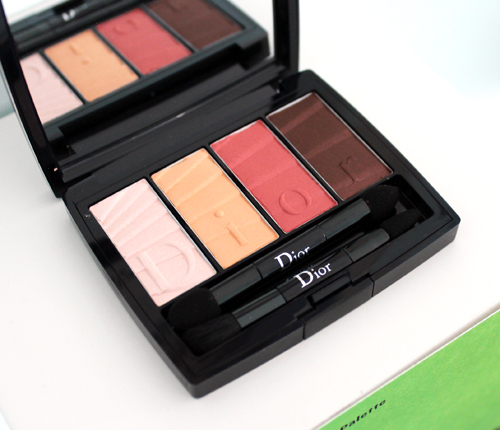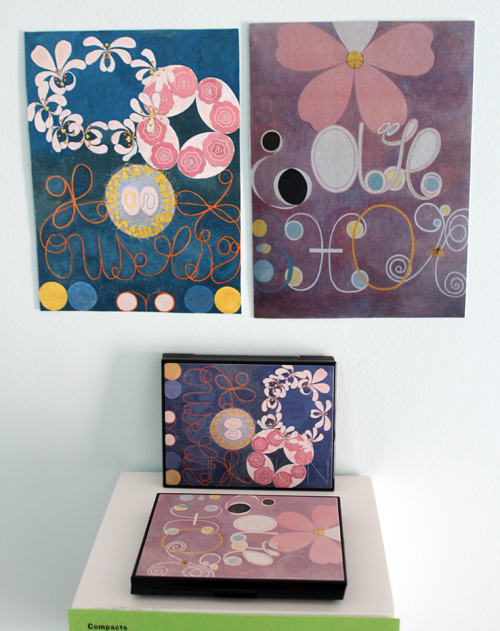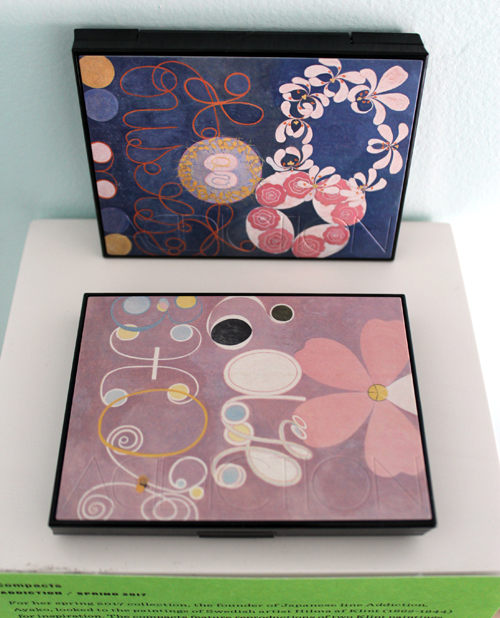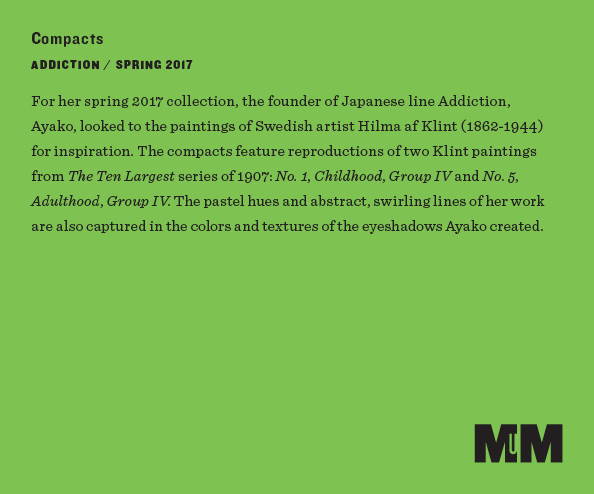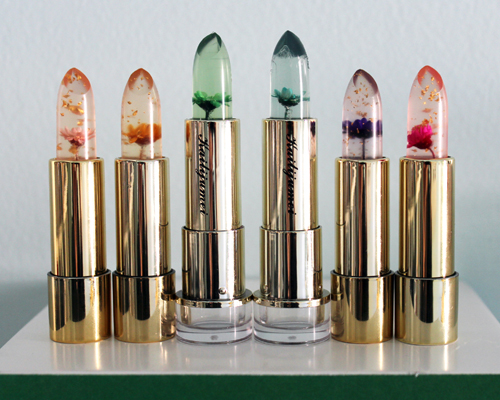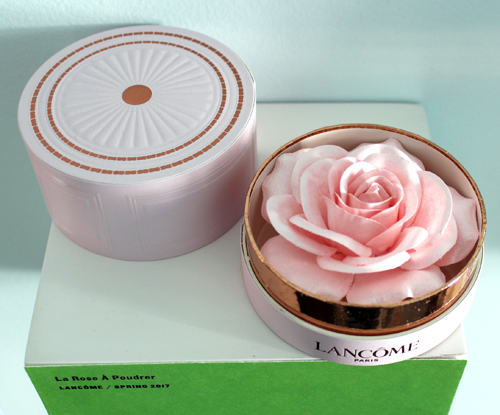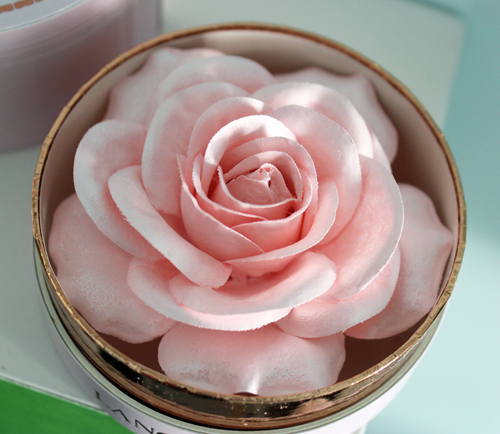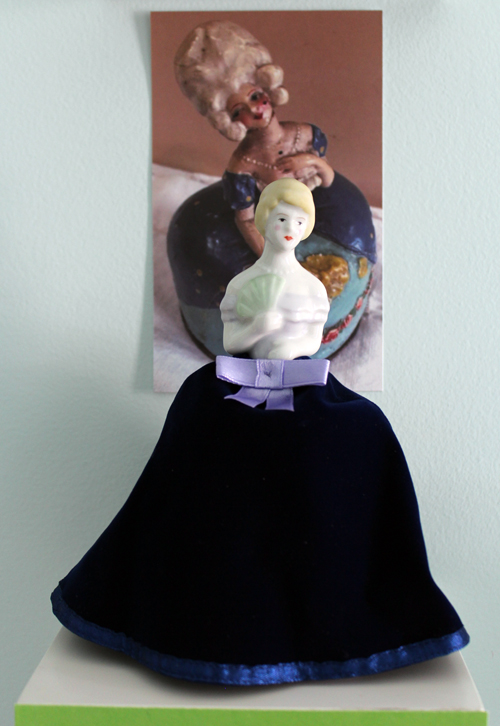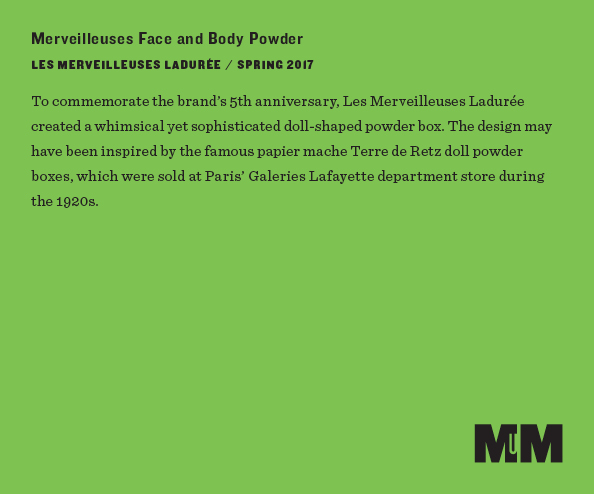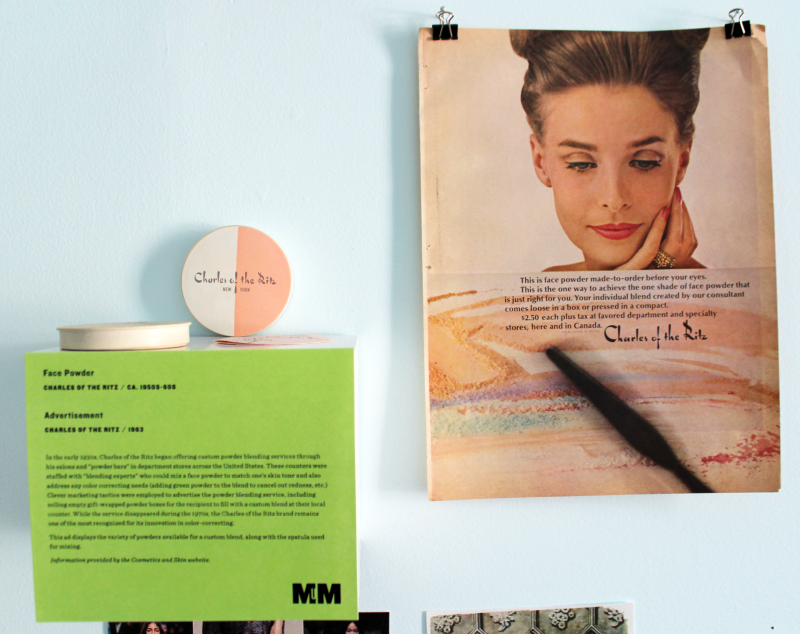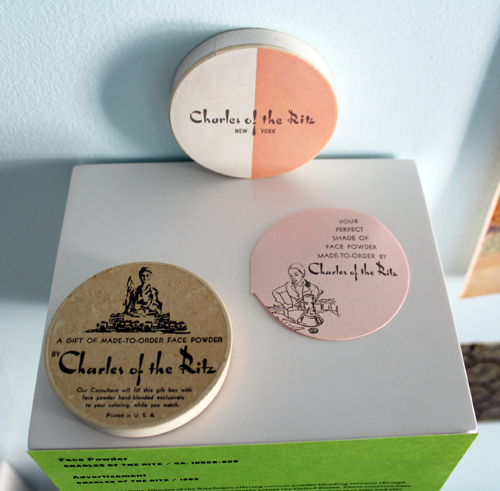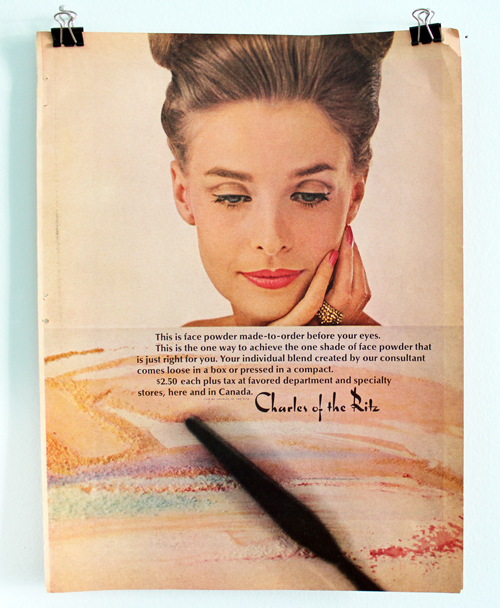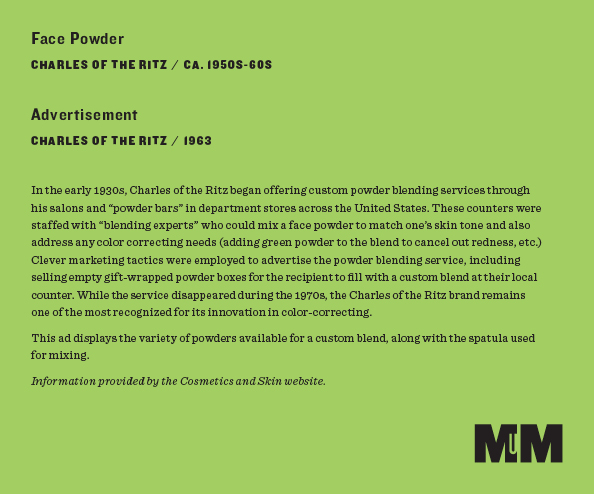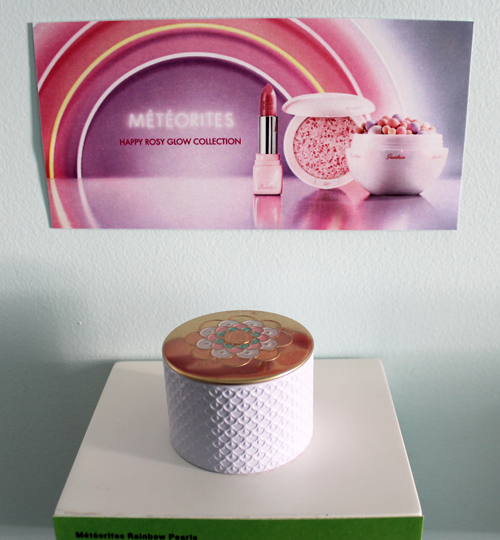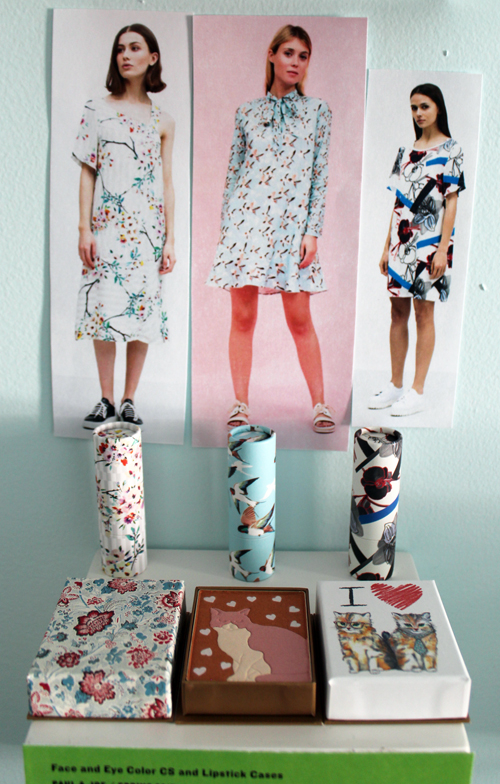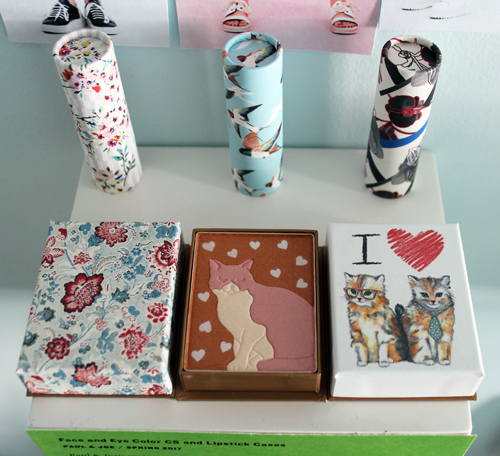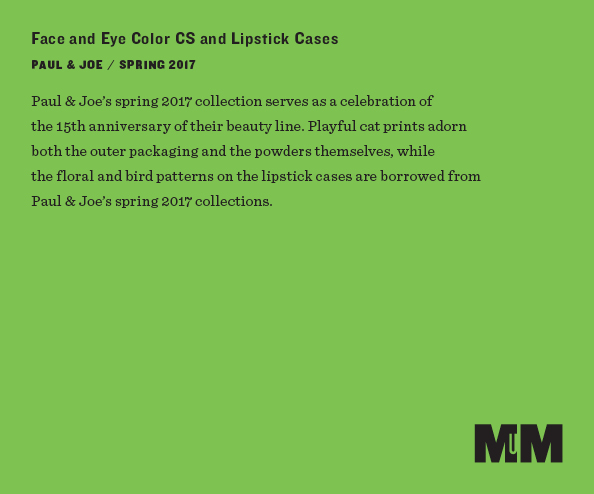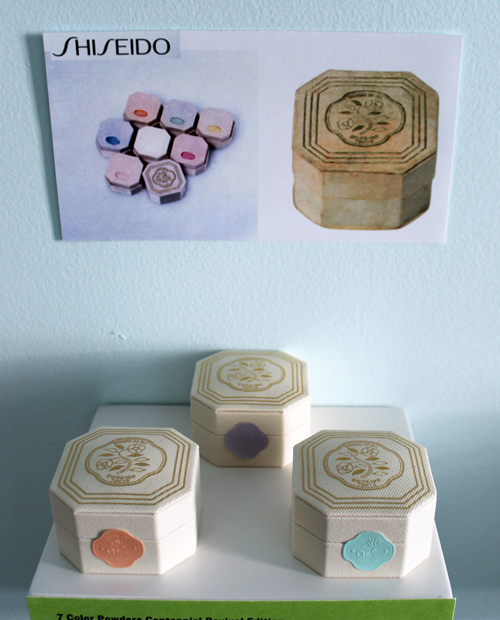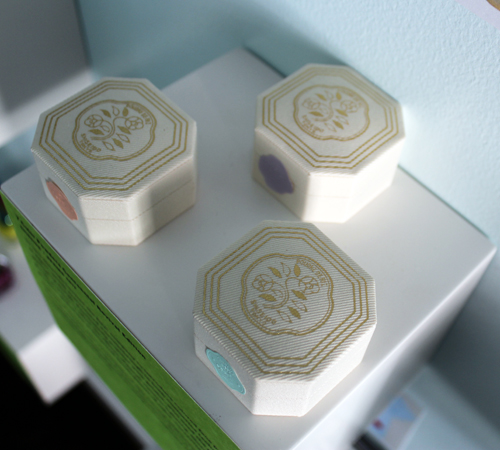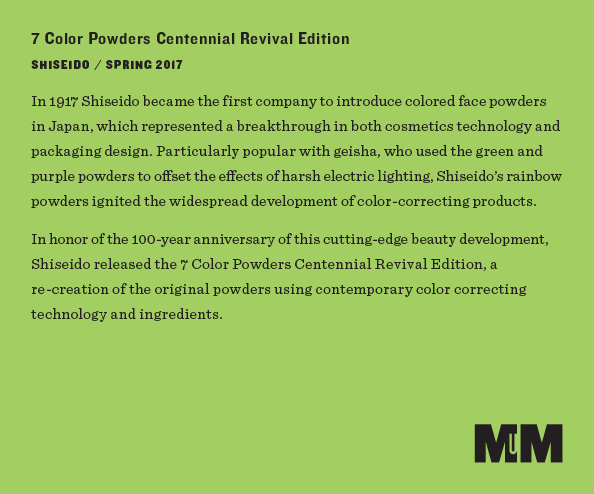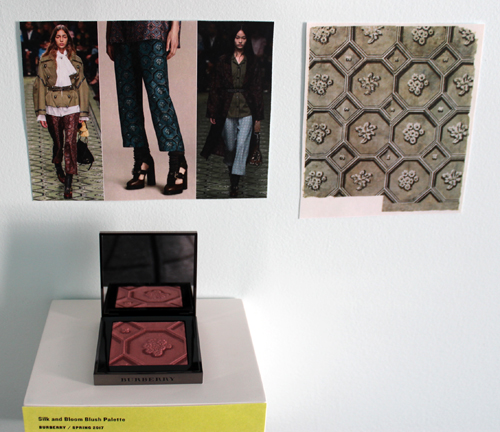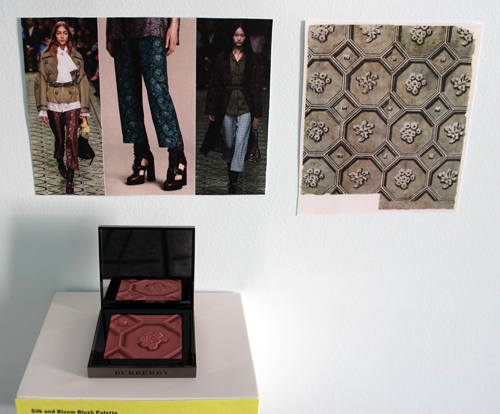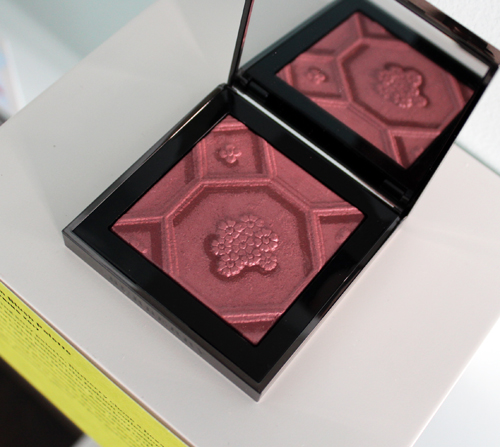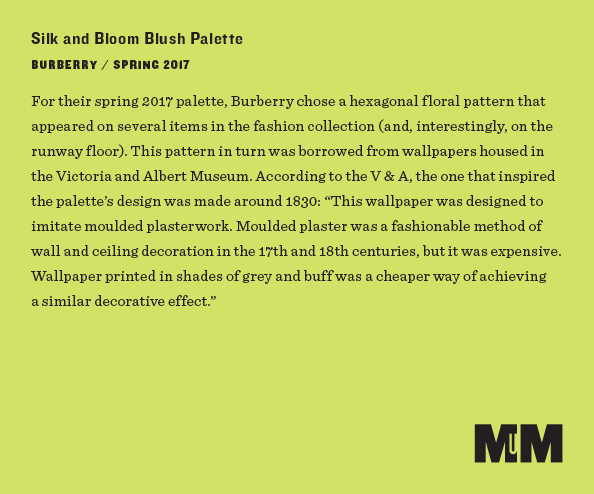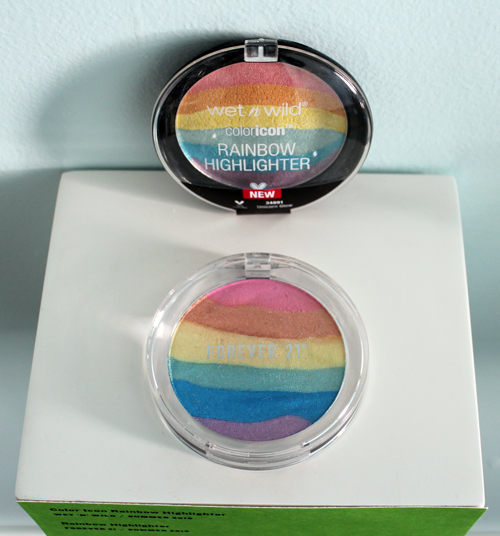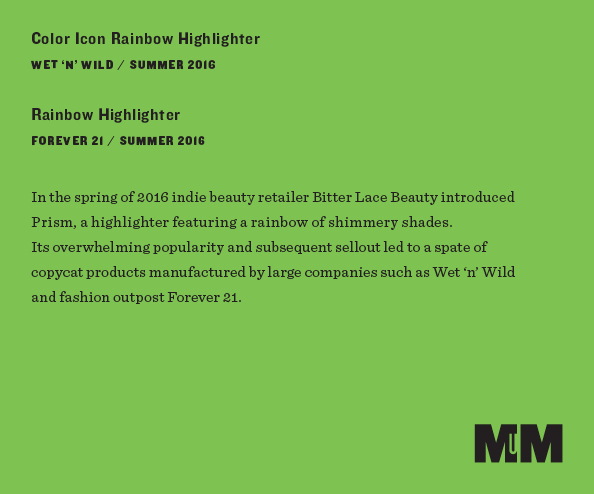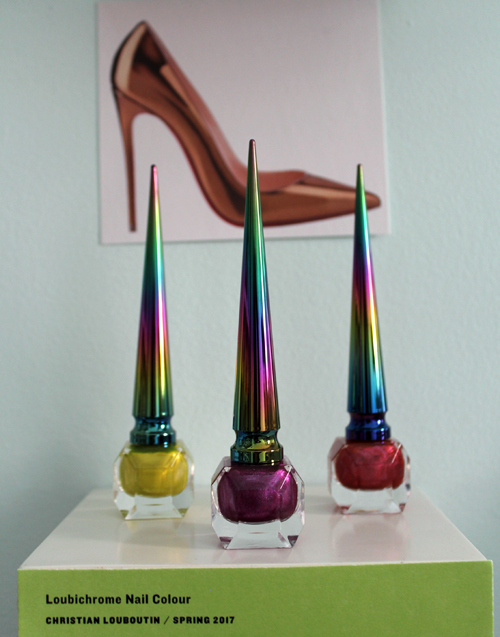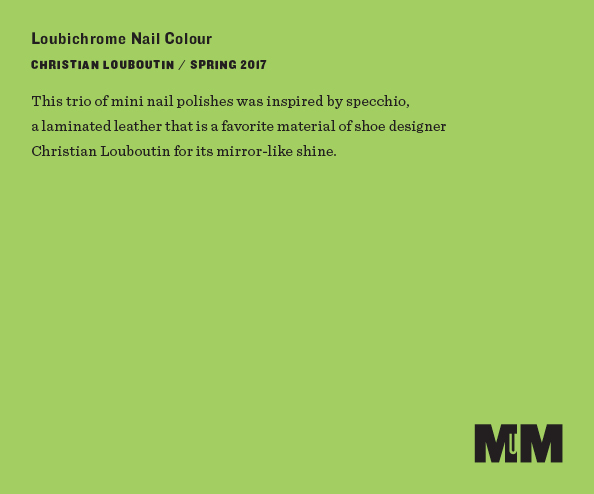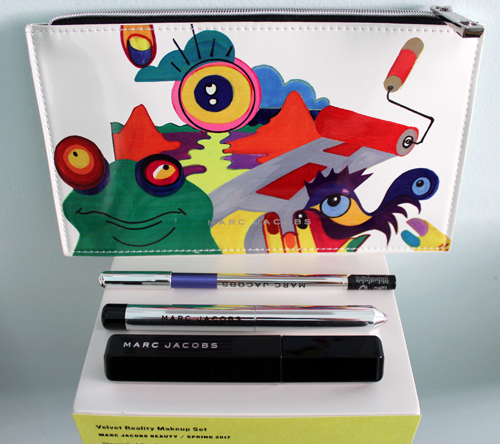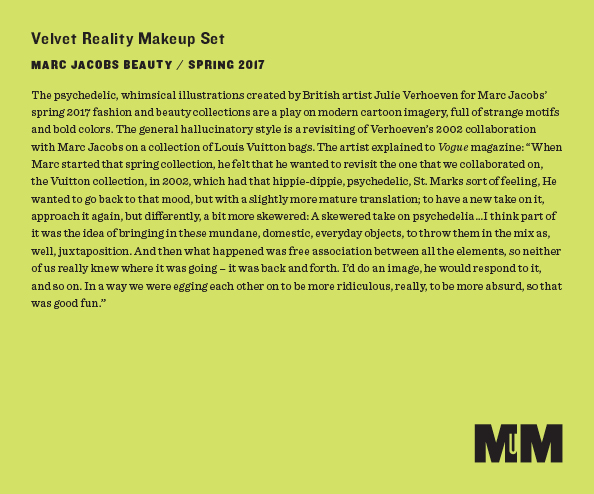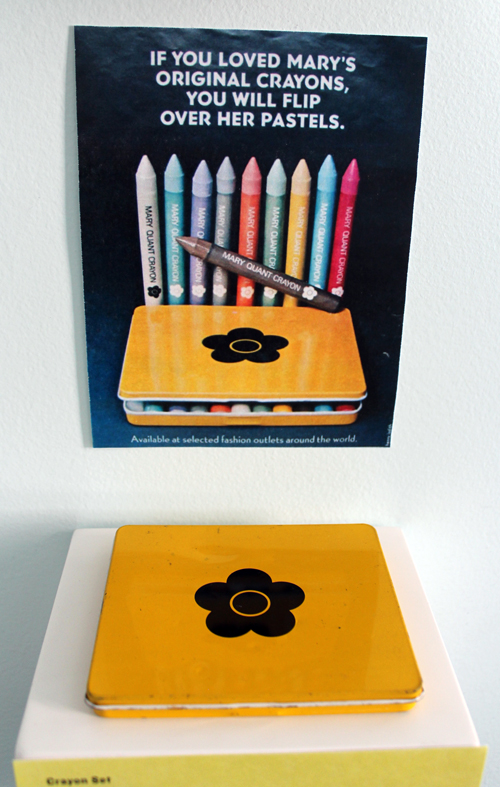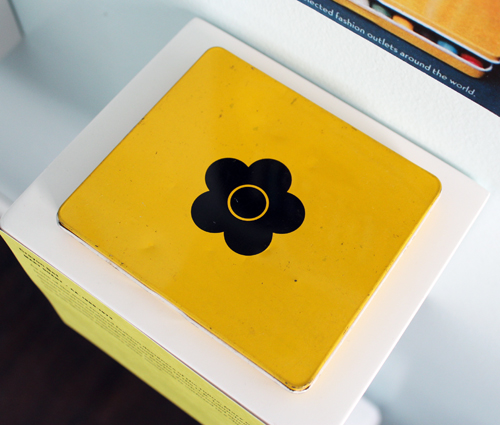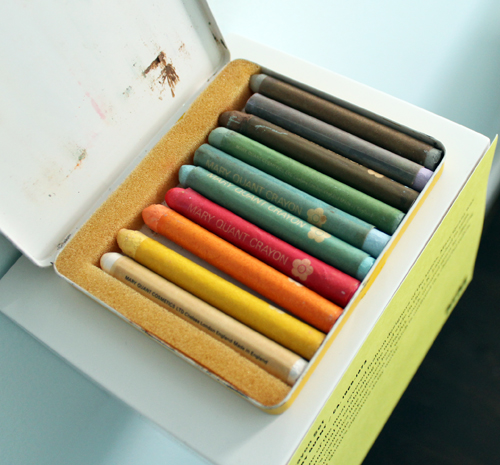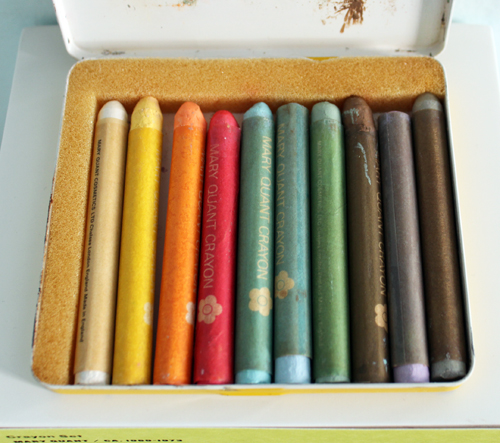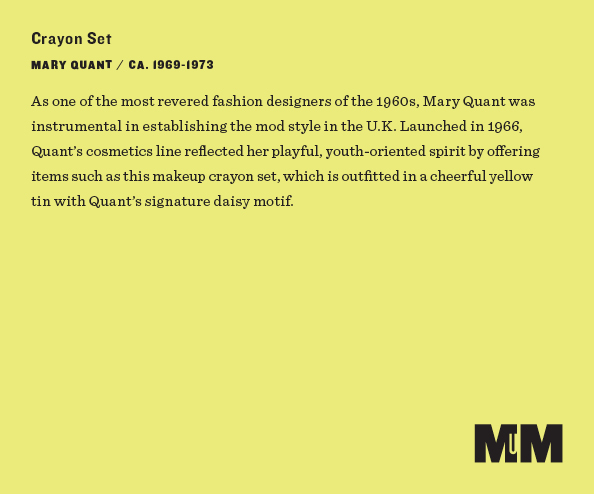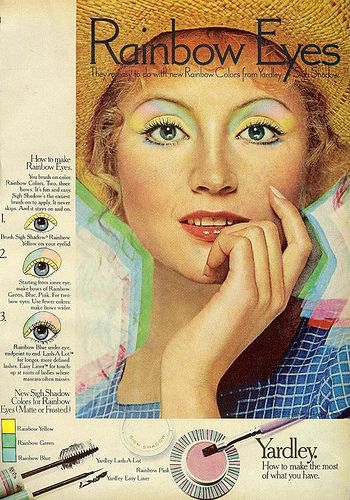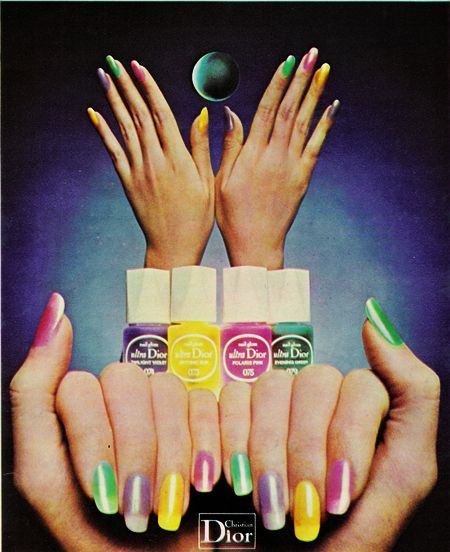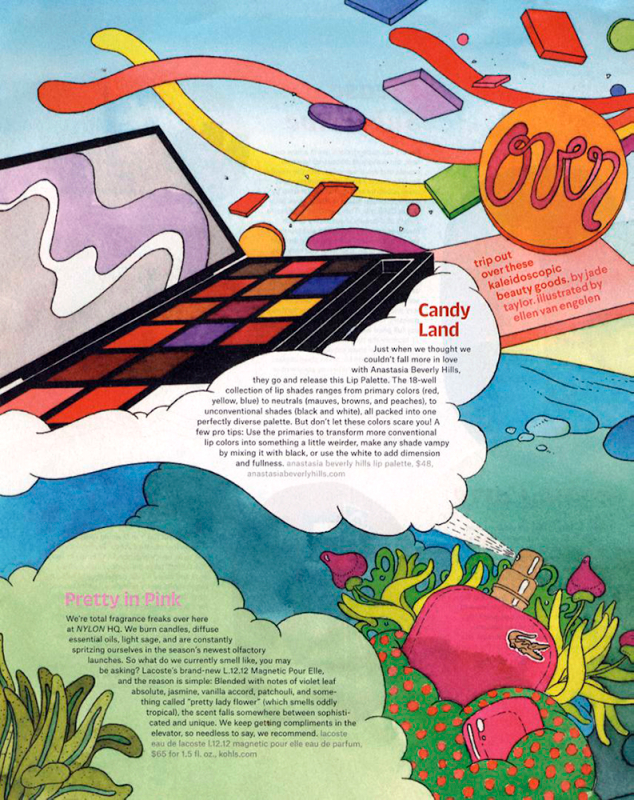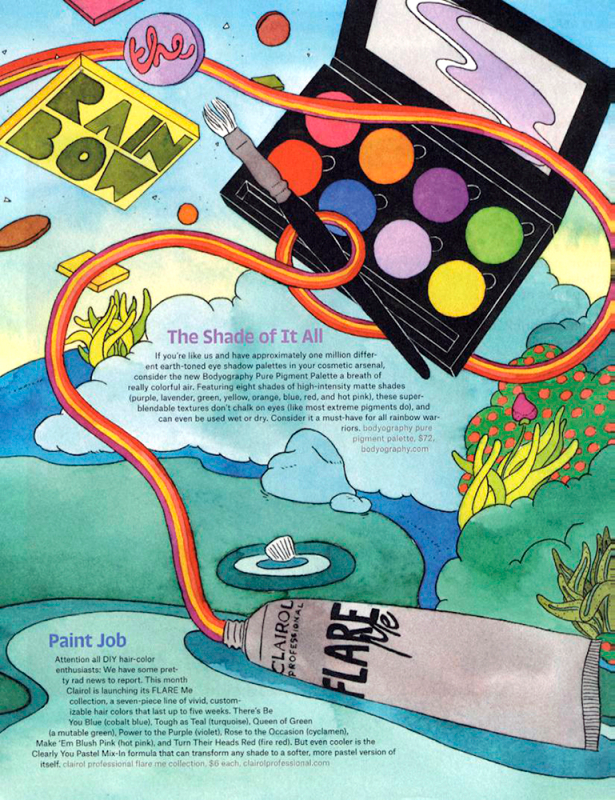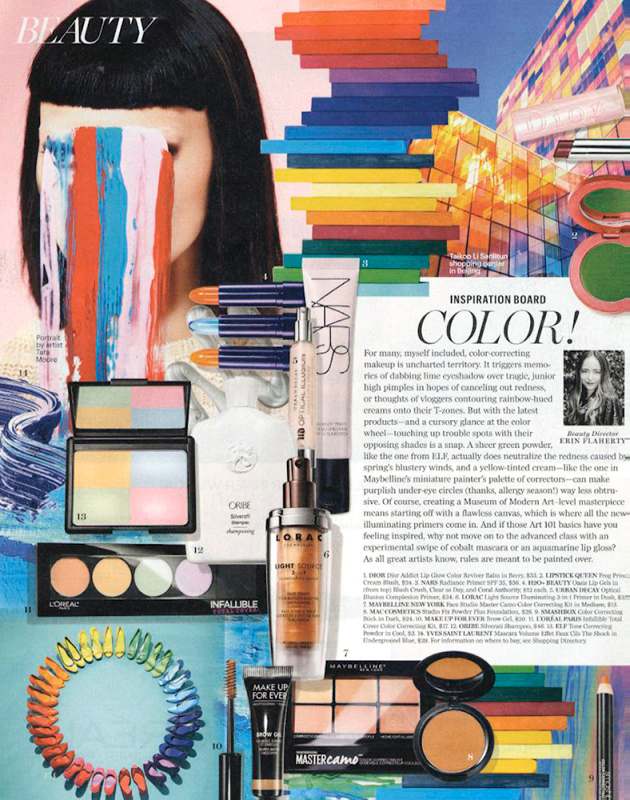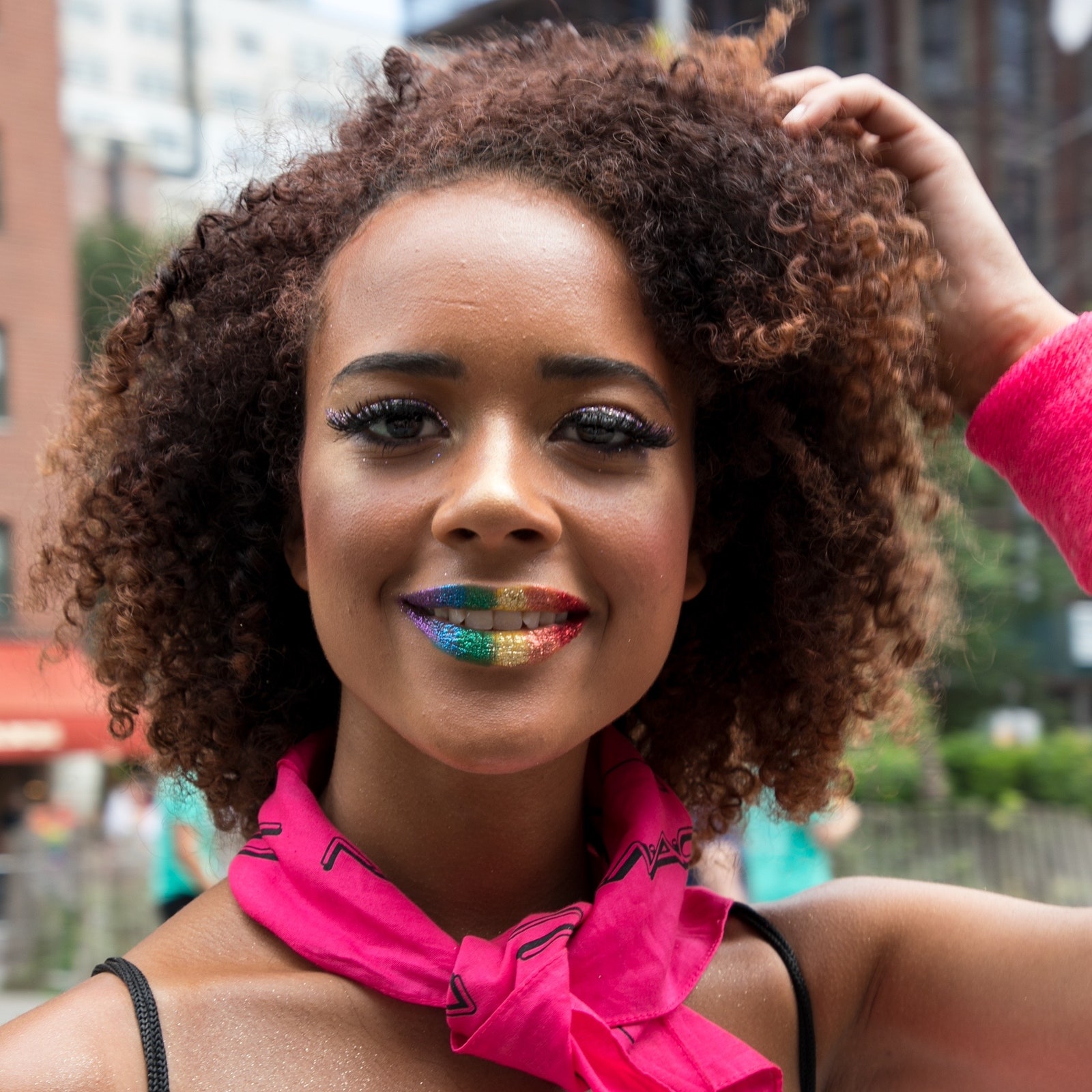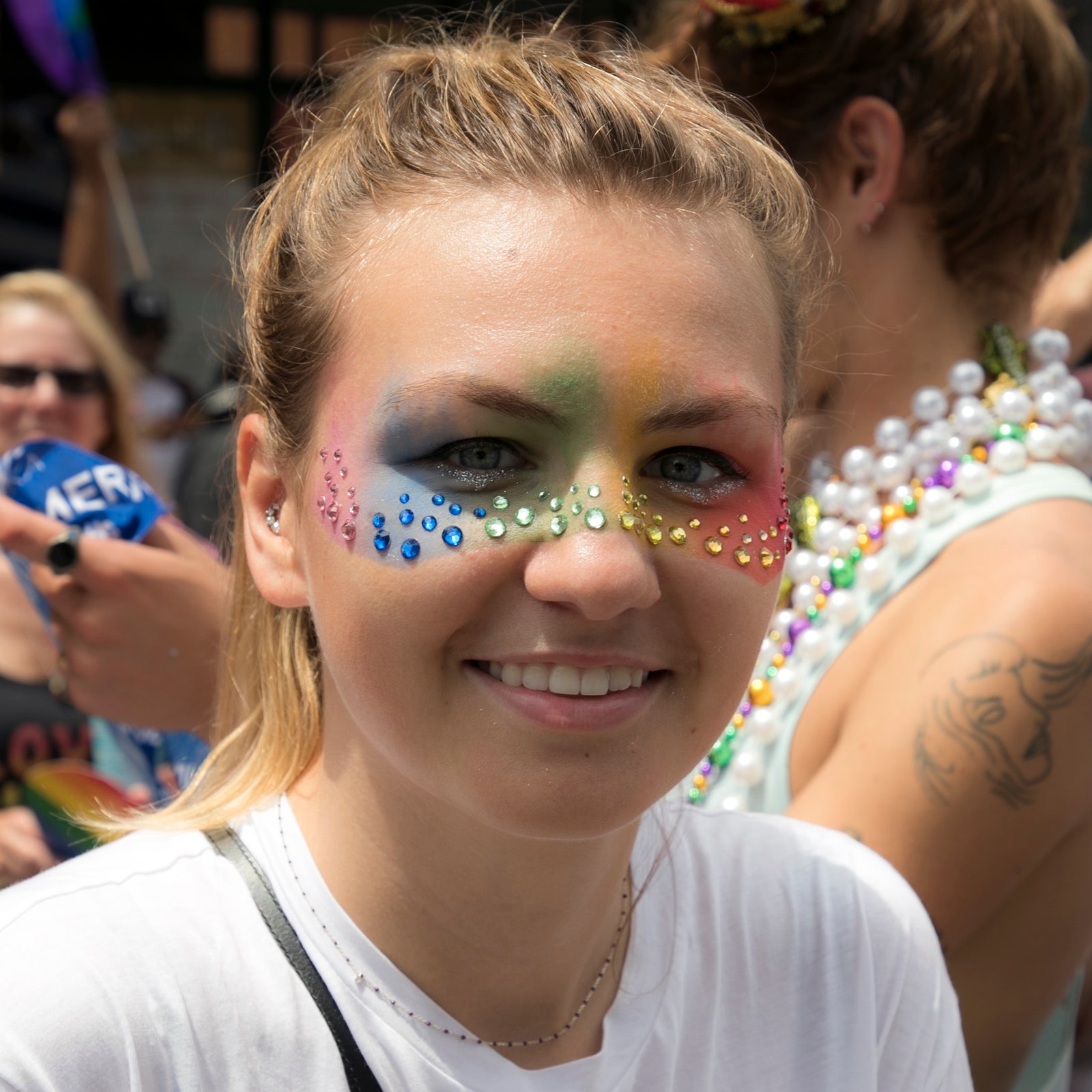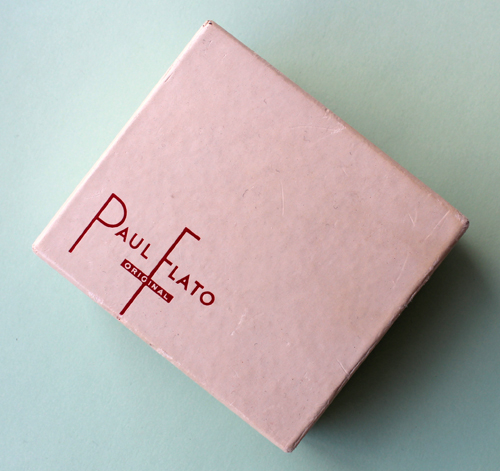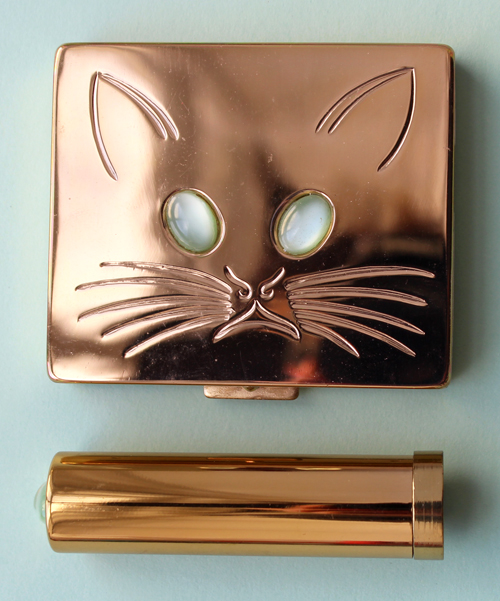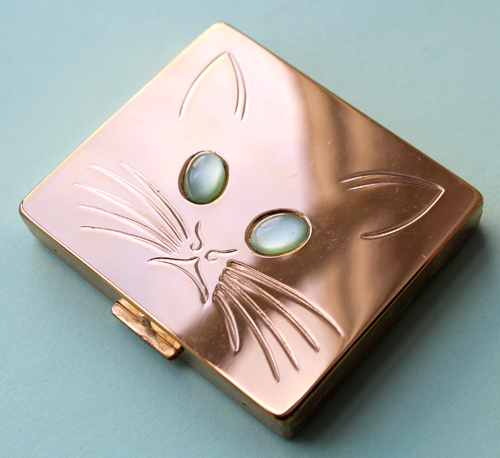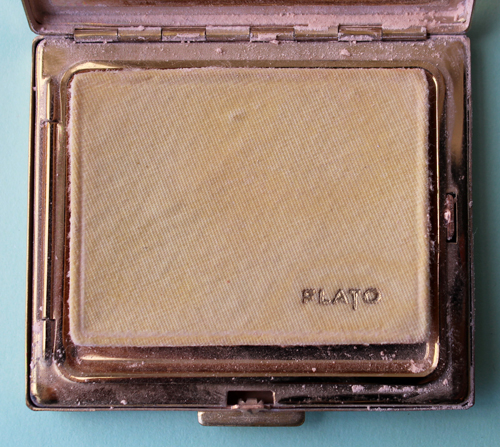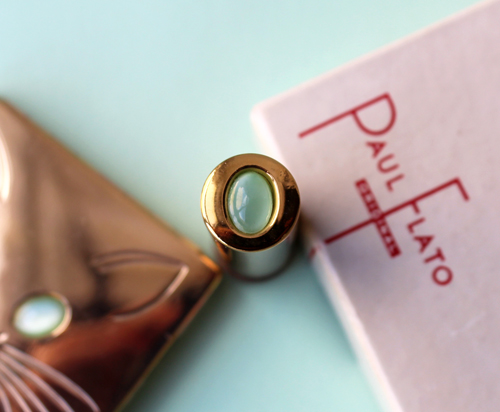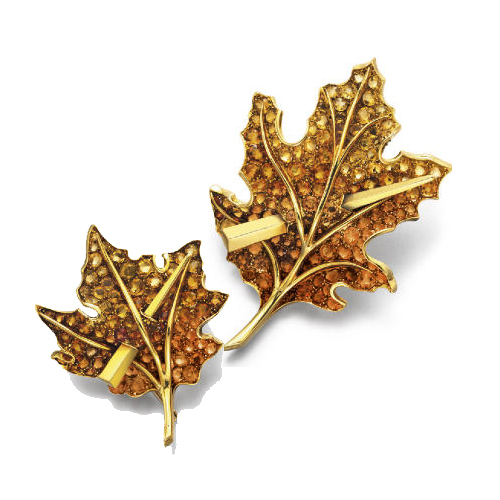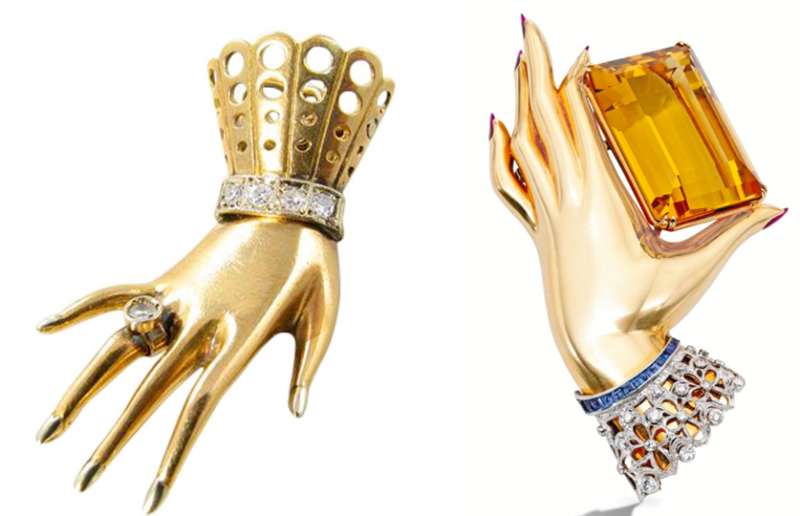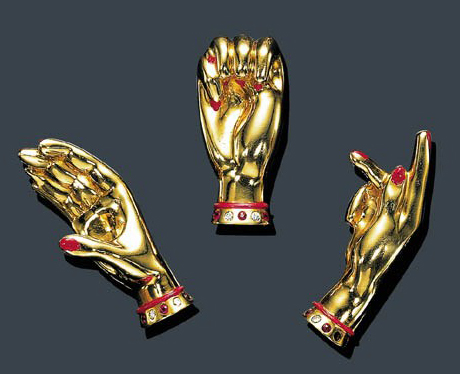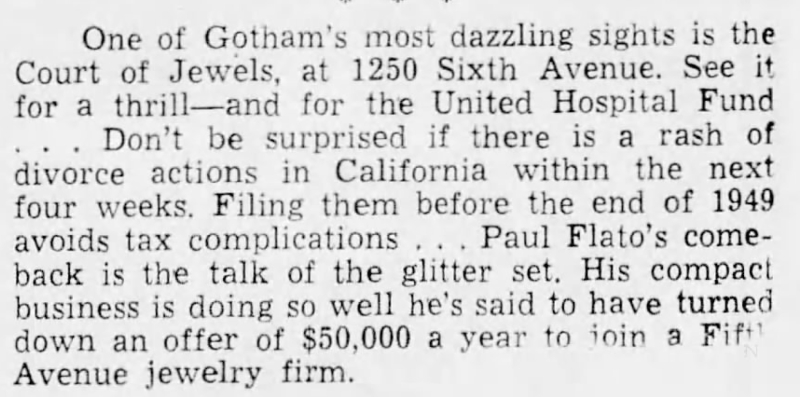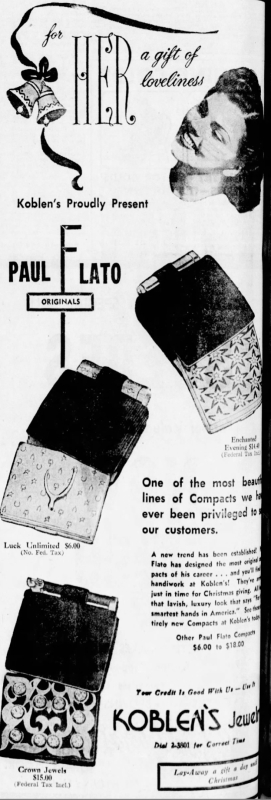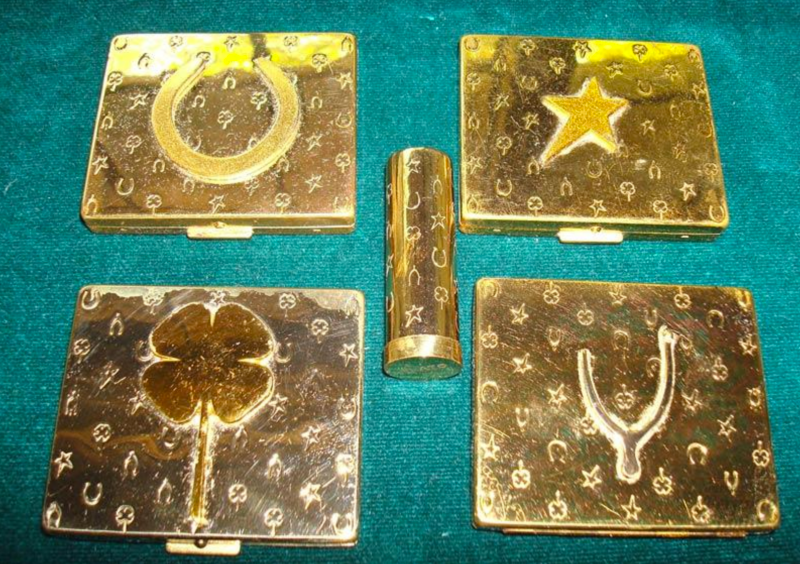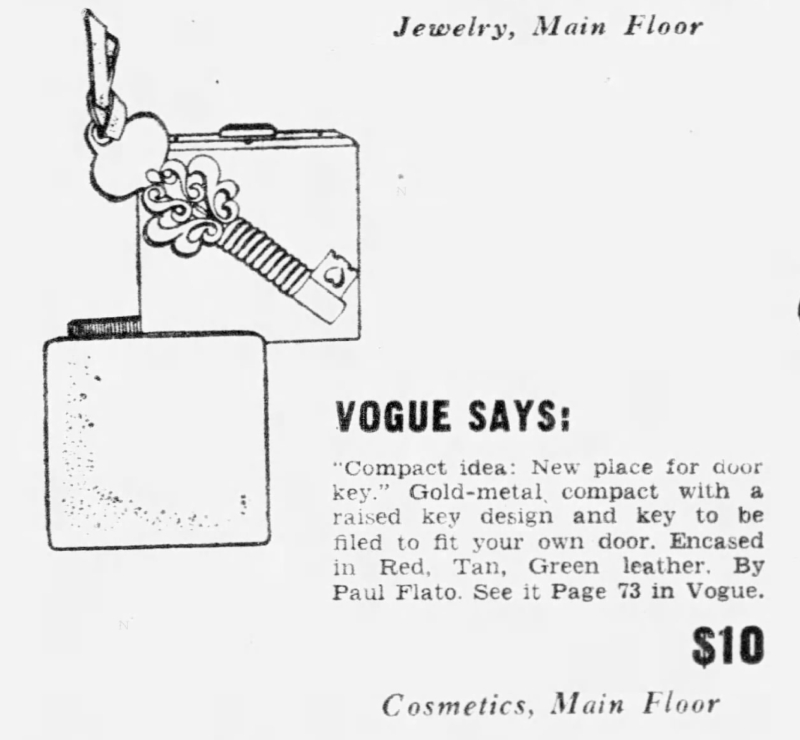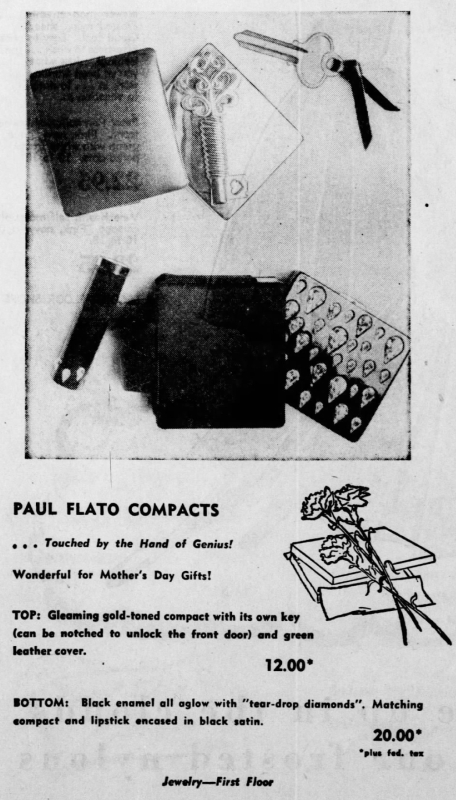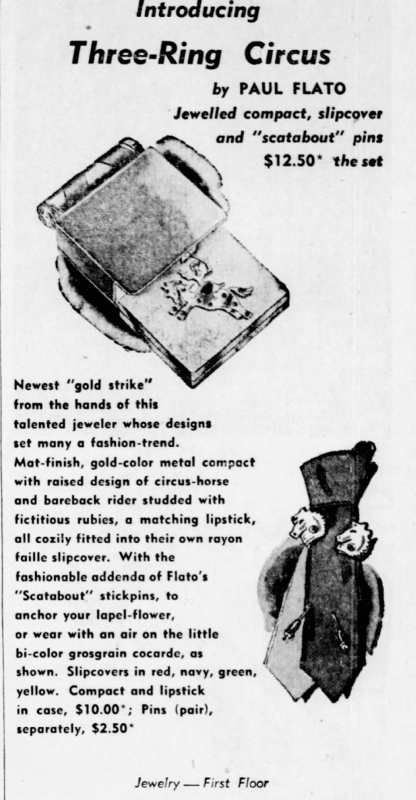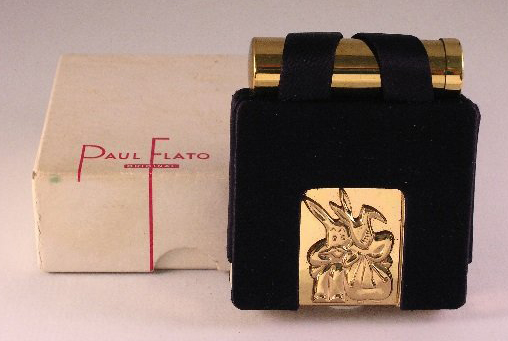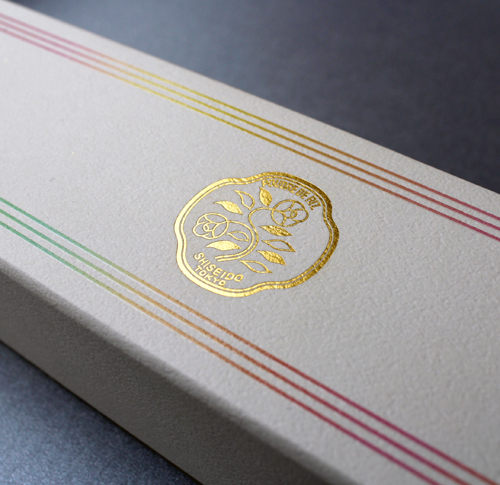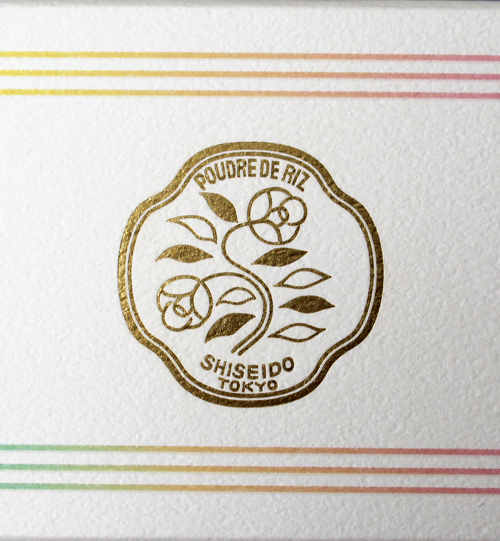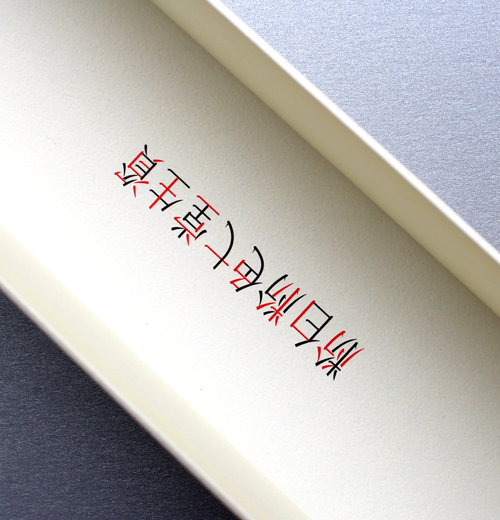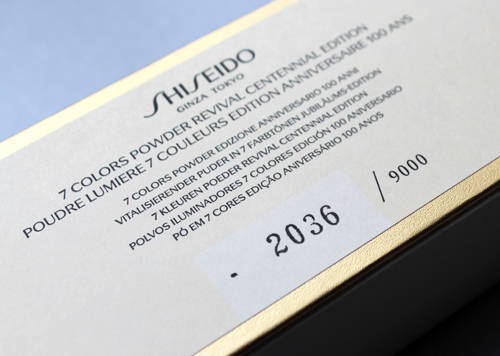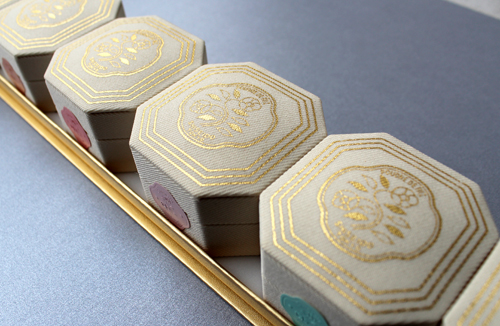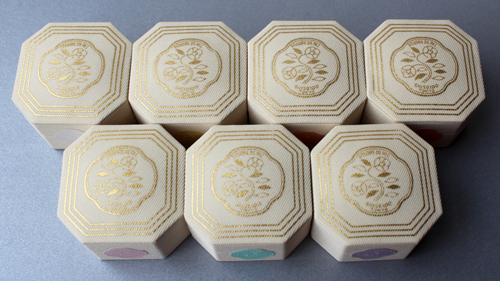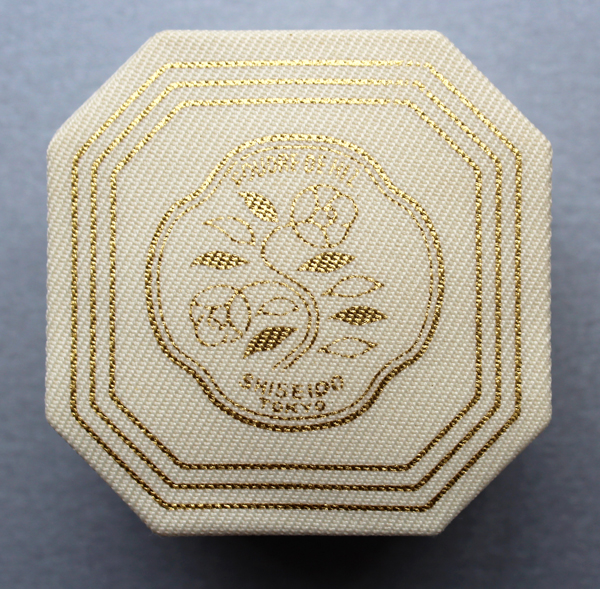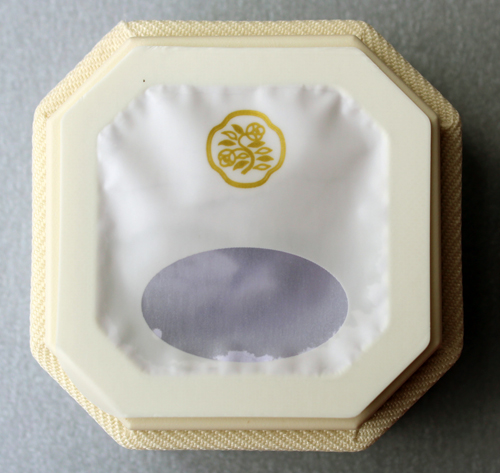- Digitization – website redesign, professional object photography, and collections management software that allows a searchable database of all objects to be published online;
- DEI initiatives – hiring of BIPOC and LGBTQ+ consultants, writers and historians;
- Research – subscription fees to various archives/trade journals and fees for external researchers (as needed);
- Preservation – purchase of archival storage materials;
- Operating expenses – annual professional membership dues, blog and domain name renewal costs.
Welcome to the 2019 edition of Curator's Picks and Pans! It's been a bad year for me and the Museum, but at least there was some great makeup! And some not so great too but again, they were a welcome distraction.
First up are my picks, i.e. the items with what I thought had the best concepts and design.
1. Mikimoto holiday 2019 collection: I haven't even written about this one yet – I hope to get a post up early in the new year – but as with last year's holiday collection as soon as I laid eyes on it I ordered without batting an eye. This year Mikimoto partnered with artist/illustrator Brecht Evens, who created even more mermaid-laden and fantastical underwater scenes than last year's collection.
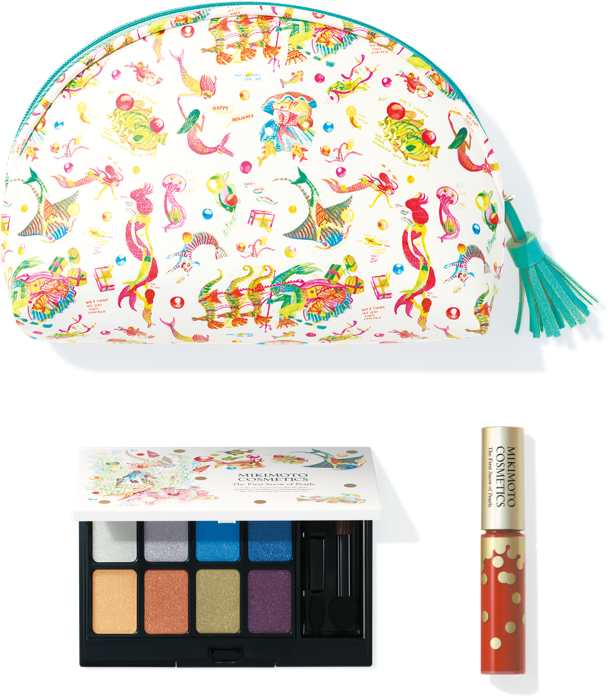
(image from mikimoto-cosme.com)
2. Paul and Joe x Doraemon: I must admit I was totally unfamiliar with Doraemon, a wildly popular manga character from Japan, when I first heard about this collection. It was a perfect fit for Paul & Joe given the founder's love of cats as well as her penchant for quirky, playful prints and collaborations (see the 2016 Warner Bros. collaboration.) I hope to write about it sometime in 2020.
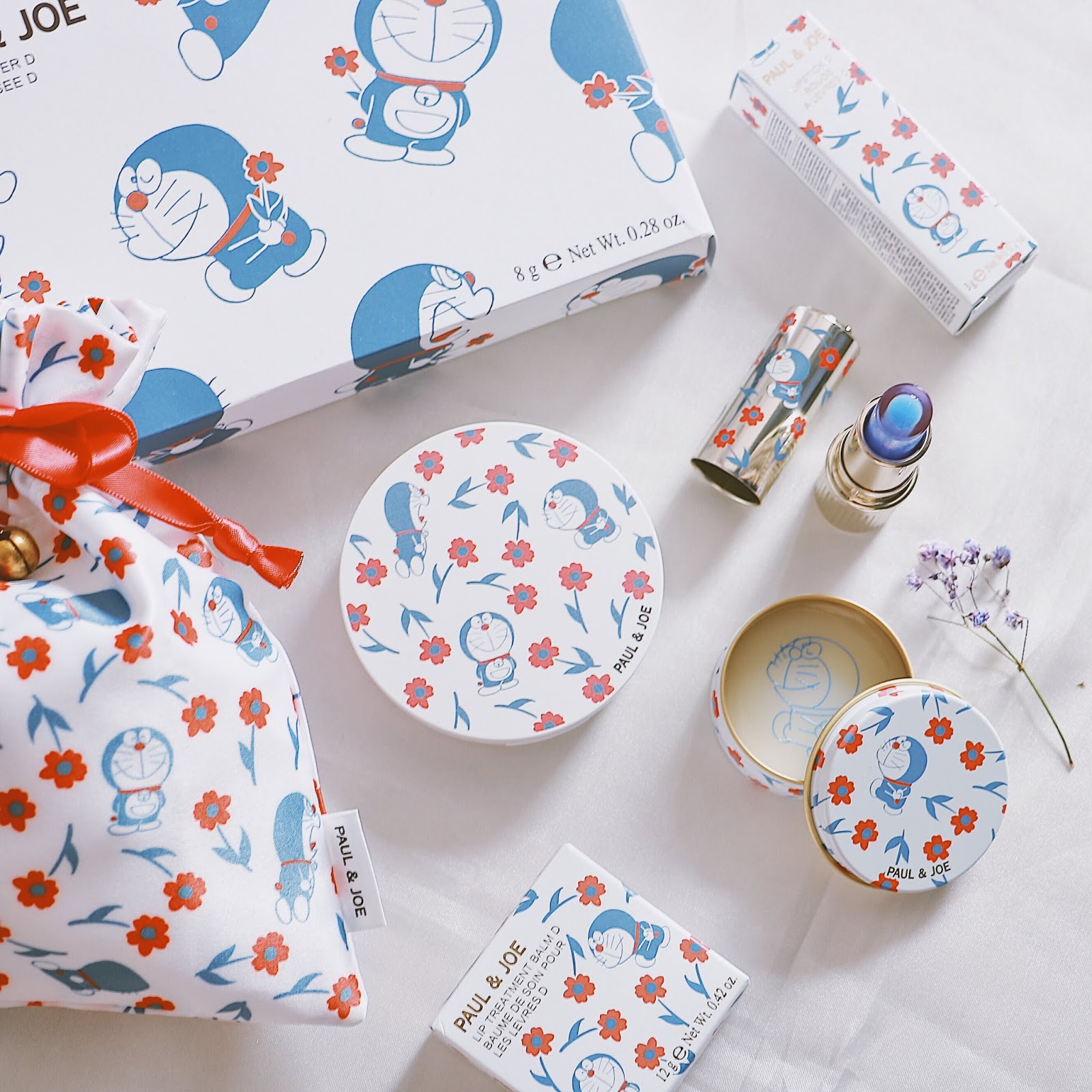
(image from blog.ulifestyle.com)
3. Chanel Eiffel Tower Illluminating Powder: I don't have much to say about this other than it was released in honor of the opening of Chanel's first beauty-only boutique in Paris. The embossing was so lovely and intricate, and the exclusivity made it impossible for me to resist – it was only available at Chanel boutiques in France and and the French website (I acquired it through ebay). Plus it's a fabulous piece to have if I ever want to revisit the Museum's fall 2015 Paris/French-themed exhibition.
As the Museum continues to expand its vintage holdings, for the first time I'm including my top vintage acquisitions.
1. Stila paint cans: The picture shows the Museum's entire collection since I was too lazy to weed out exactly which ones I got this year, but back in February I bought 20 rare vintage (okay, maybe not quite vintage yet but very close) paint cans on ebay from a former collector who didn't have room. I was sad for her but glad I could give them a good home. Plus they really added something extra to the Stila girl exhibition.
2. Volupté Petite Boudoir: among my many weaknesses are novelty compacts and palettes. I had been coveting this adorable vanity-shaped compact for ages, so when I saw one in excellent condition at a great price I pounced. For photography purposes (and because I love miniatures) I purchased some mini makeup items as accessories.
Here's an ad for it from one of my collector's guides, in case you're curious.
3. Yardley Glimmerick eyeshadow set: Another I haven't gotten around to sharing, but I was so pleased to get this one in fantastic shape and still with with the insert.
And now for the more lackluster releases this year.
1. Madonna by Too-Faced: A hugely successful brand collaborating with a pop culture icon seems like a surefire hit, but dear lord was this unimaginative. I'm truly shocked at how boring this was. Between the flamboyance of Jerrod Blandino and Madge's propensity to push boundaries, I expected way more not just in packaging but the entire concept.
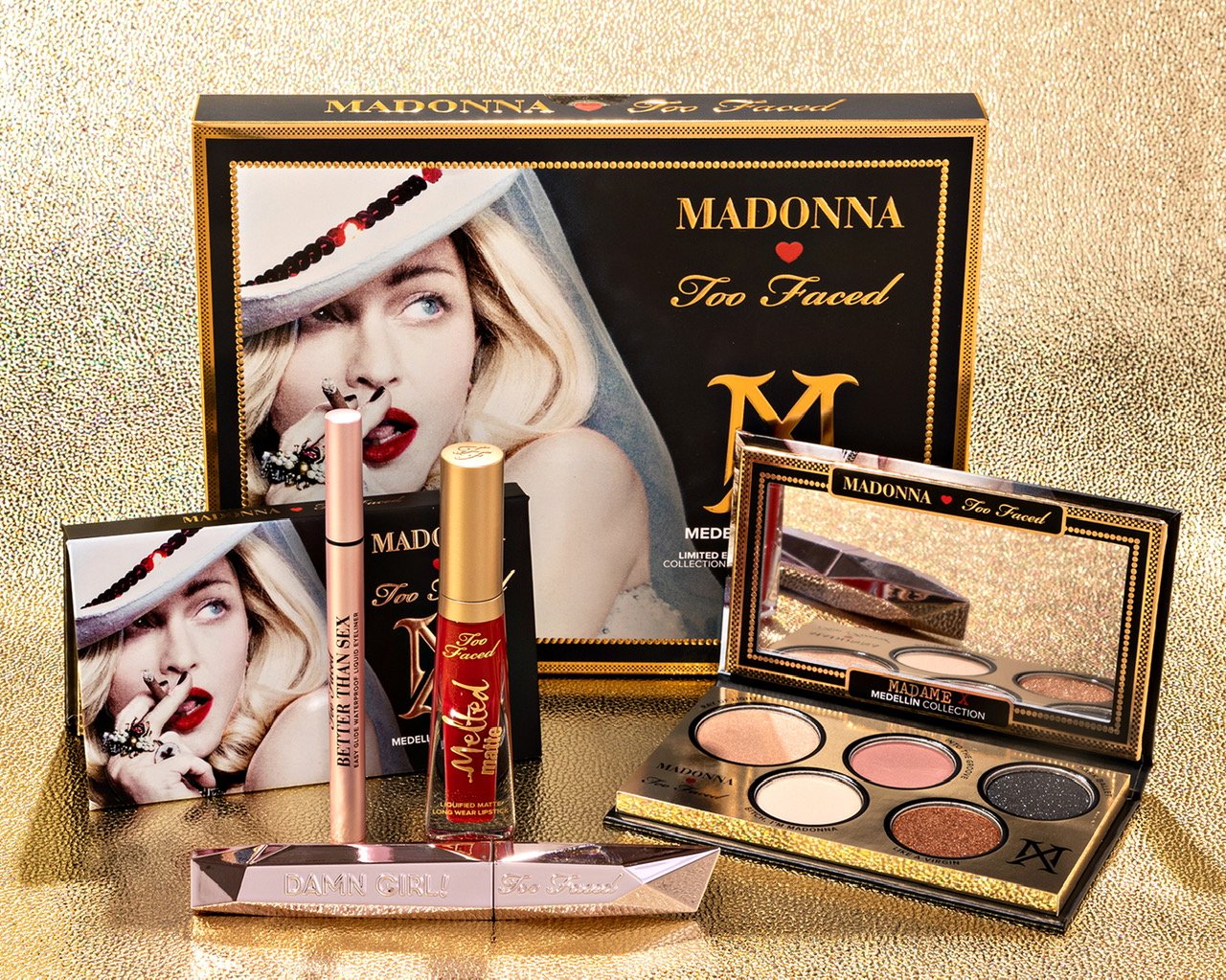
(images from shop.madonna.com)
2. Revlon x Mrs. Maisel: Another squandered opportunity, and much like the Estée Lauder Mad Men collaborations, a good idea but poor execution. You would think The Marvelous Mrs. Maisel would be a goldmine for inspiration. Midge worked at the Revlon makeup counter so the brand makes sense, but why the packaging didn't get a fabulous retro/vintage treatment I'll never know.
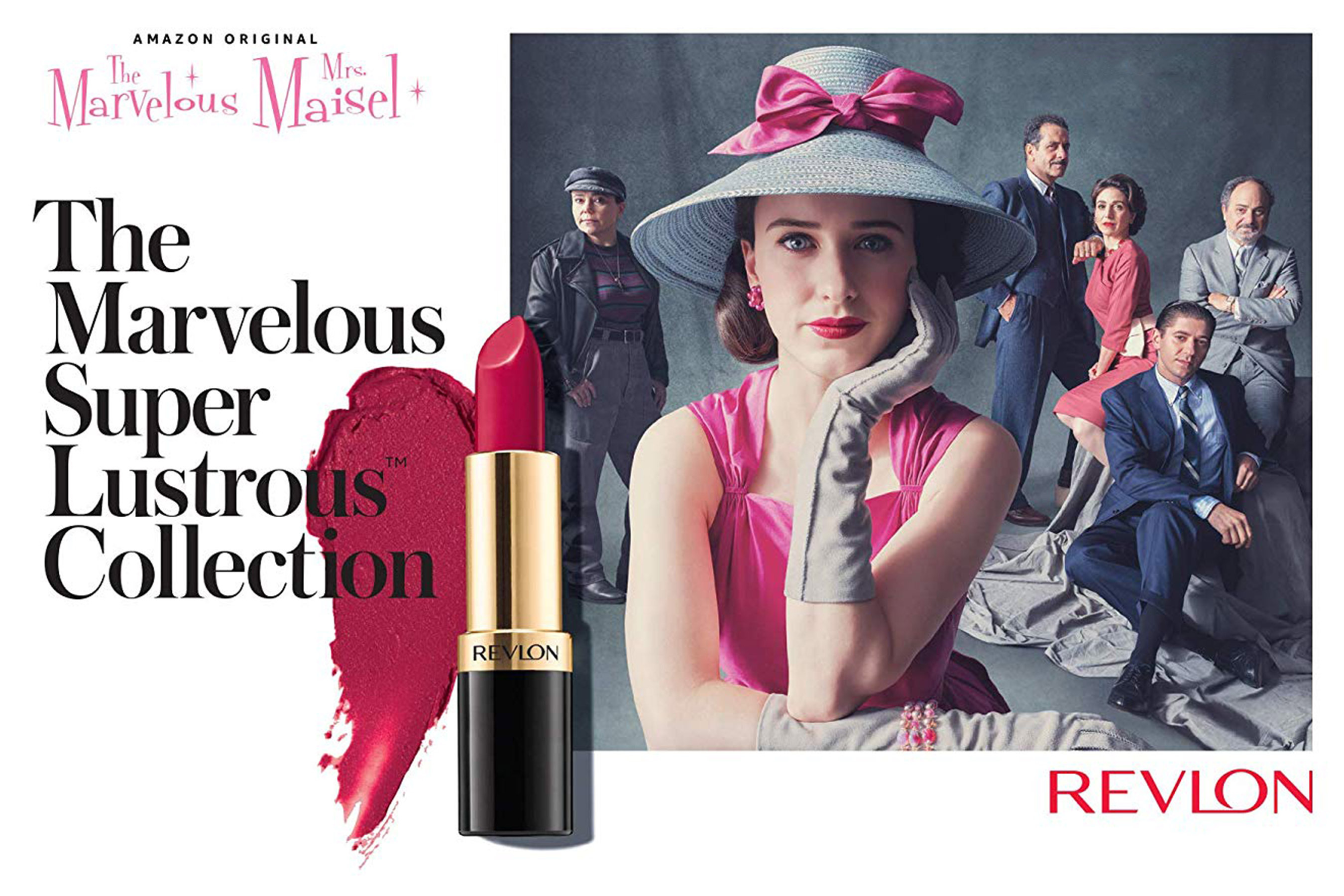
(image from ew.com)
3. Guerlain Rouge G Wild Glam case: Maybe it's sour grapes because I can't afford it, but I wasn't a fan of this one. It's a cool design, but not $290 cool! I honestly have no idea what Guerlain was thinking.
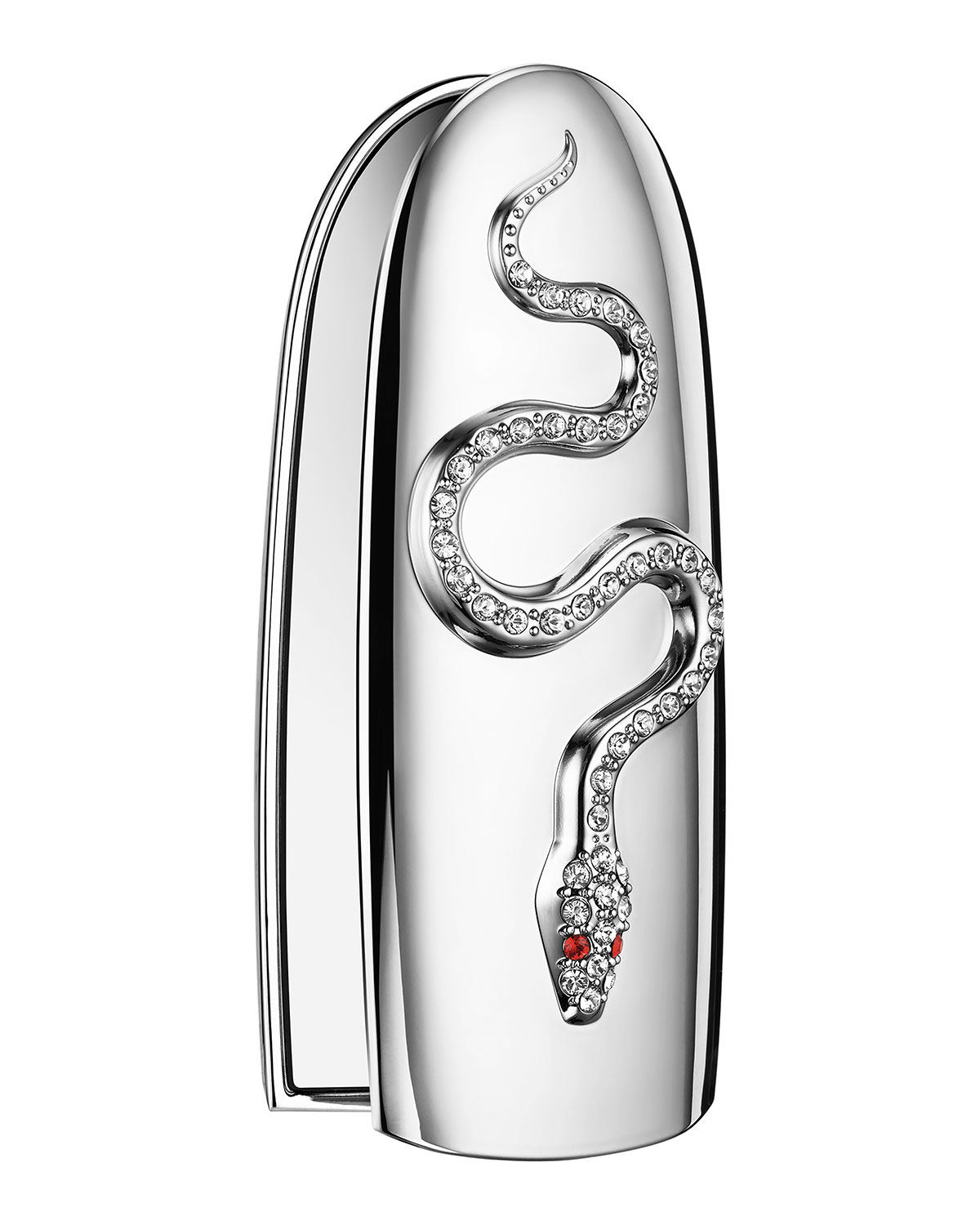
(image from neimanmarcus.com)
If I'm going to pay 300 bones for a lipstick case (and I've done it before, embarrassingly enough) it better at least have some sort of handmade element or utilize precious materials. As far as I can tell, neither of those things came into play here. It's just plain old rhinestones (not even Swarovski – I mean COME ON) and a silver-toned case, not real silver plating. And it wasn't handmade by a jeweler, just designed by one. It does say the rhinestones were "hand-set", but I'm skeptical. Plus this other rhinestone-encrusted case is within a normal price range, costing a mere $36. Finally, I'm confused by the snake motif, as it doesn't have any significance for Guerlain that I'm aware of. It felt like a very uninspired piece overall.
And those are some makeup highlights and lowlights of 2019. (I was going to do picks and pans for the past decade but immediately got overwhelmed, so I'm keeping it simple.) What do you think of these choices? Please visit the archives and let me know!
I'm so very excited to announce the Makeup Museum's special exhibition in honor of Stila's 25th anniversary! I was too overwhelmed to do a full history of the brand, so I decided to just focus on the famous Stila girl illustrations. If you've been following me for a while you know that the Stila girls were sort of the gateway drug for my interest in collecting makeup and seeing cosmetics packaging as art. For such a milestone anniversary I knew I wanted to pay tribute to them, even though the year is almost over (thankfully – it's been miserable for a number of reasons), especially given that I've been itching to put together a special exhibition for them since at least 2016. I also wanted to try something totally new for the Museum in terms of exhibitions. Technically all of them are online, but instead of putting things on shelves and taking photos, I wanted it to have a more "real" online exhibition feel. I've been doing a lot of thinking the past year or so about how to improve the exhibitions even though I'm so limited in what I can do, and I was really inspired by the Kanebo Compact Museum website, and once the husband showed me Squarespace I was sold. Well that, and the fact that he kindly offered to design the entire exhibition site for me. ;) So I set up a domain there which, if this exhibition is well-received, will serve as the space for the Museum's special exhibitions going forward. The seasonal ones will remain here if I decide to keep going with them. Looking ahead, I think I'd rather focus on more specific topics than general seasonal trends. Not that I can delve too deeply into particular themes given the never-ending lack of resources, but I still want to at least try to do slightly more in-depth exhibitions even though they won't be exactly how I want them. I'm looking at them as a starting point for bigger things.
Enough of my blabbing about the basic stuff, I want to give some more details about the exhibition itself. It came together nicely, or at least, it was the one I worked most on with the possible exception of Sweet Tooth (still want to revisit that one!) I really wanted to get interviews with the key people behind the illustrations, so I put my crippling fear of rejection aside and boldly contacted Jeffrey Fulvimari (Stila's original illustrator), Caitlin Dinkins (illustrator during Stila's early aughts heyday) and Naoko Matsunaga (who took over for Dinkins in 2009). While I was disappointed at not hearing back from two of the three, if only one responded, I was glad it was Jeffrey since I've been following him for a while on Instagram and I love his approach to art and his personality. He is quite the character! It ended up giving me so much confidence I reached out to the grand poobah herself and my curatorship namesake, Jeanine Lobell. Yes, I actually DM'ed the founder of Stila on Instagram and asked if she'd be up for an interview. And…and…are you sitting down?? You really need to. Okay, now that you're sitting and won't have far to fall in case you faint, I can tell you that she agreed to do it!!
Not only that, she actually answered all of my interview questions!! You have no idea how ecstatic I was to finally be heard by a major industry figure. Took over a decade but I finally made contact with a big name! So that was most exciting, easily one of the most exciting things to happen in the Museum's 11-year history. And her answers were really good too, I've incorporated them throughout the exhibition so make sure to read through.
As for the items, I didn't take photos of everything in my collection because again, too overwhelming. The Museum has over 130 Stila items, nearly all of which feature the girls. I mean…
The photos I did take have purposely plain backgrounds because I wanted the emphasis to be on the illustrations. I tried to have a good mix of memorabilia and the makeup itself. I even had to iron a few items.
I also included a couple photos of things that I don't actually own but are important in getting a full picture (haha) of the illustrations. I'm pleased with how the sections are arranged, and I must thank my husband for organizing them so perfectly in addition to designing the whole site. I'm thinking of adding a section called Soundbites, a repository of quotes from the both the beauty community and general public telling me why they like the Stila girls or really anything related to the brand, so be sure to email me or comment here. I really wish I could have an app that would "Stila girl-ize" the user, i.e. you upload a picture of yourself and it would automatically generate a Stila girl style illustration of you, just like this. And of course, if the Museum occupied a physical space I'd definitely hire an artist to do live drawings at the exhibition opening – how fun would that be?
So that about wraps it up! Please take a look and tell me what you think of the new exhibition format!
As with lipstick holders and tissues, another piece of makeup ephemera has seem to gone nearly extinct: the built-in lipstick mirror. Sure, there are still some run-of-the-mill fabric and leather lipstick cases with mirrors inside, and some contemporary companies have recycled the basic designs, but no current lipstick mirrors are as novel as their vintage counterparts. Today I'll take a look (haha) at the various vintage contraptions and mechanisms that allowed for a quick lipstick touch-up. As usual this exploration is not intended to be a comprehensive history of lipstick mirrors, but a brief overview and theories as to why they have mostly disappeared from the beauty milieu as well as the reasons they were even produced in the first place.
The simplest design consisted of a mirrored tube, favored by the likes of Avon and Flame-Glo.
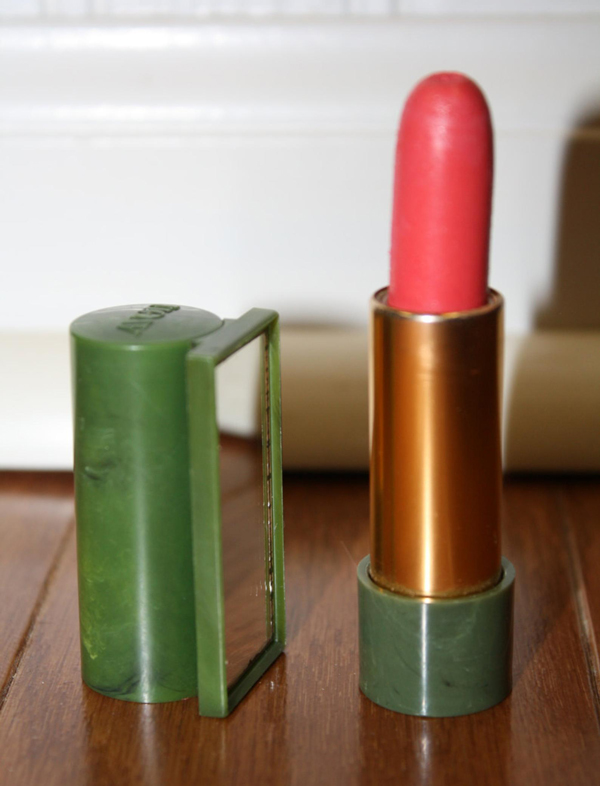
(image from etsy.com)
The second most basic and inexpensive option was the humble lipstick clip, which attached directly to the lipstick tube. The adjustable design meant that it could fit virtually any tube and was easily removable.
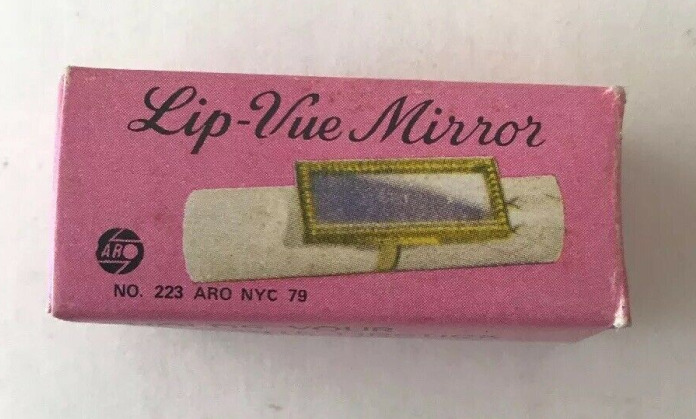 (image from ebay.com)
(image from ebay.com)
I purchased a couple of these clips for the Museum's collection. Here we have the "Looky" mirror, which was patented in 1957, and Compliments, which most likely dates to around the same time.
The only design flaw with these types of mirrored tubes and clip-on mirrors was that they would be easily smudged since the mirror was exposed. Enter the folding lipstick mirror and clip! Elizabeth Arden's Rolling Mirror lipstick debuted in 1959, and while I couldn't find an exact date for Stratton LipViews, they probably were released around the same time and continued to be sold until the early '90s.
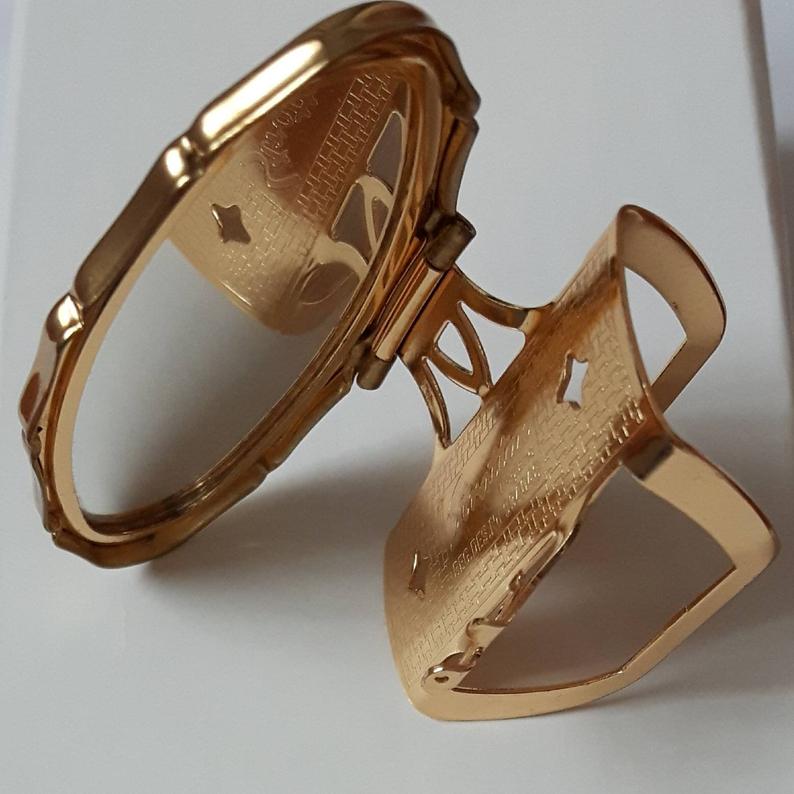
(images from etsy.com)
Avon also made a far less elegant plastic version.
The mirror could also be protected from smudges and scratches via a sliding mechanism instead of a folding one, as shown in this fan-shaped Stratton lipstick holder.
These next few will put a spring in your step. Spring-loaded, sliding cases in which the mirror popped up when the lipstick was opened were also quite popular. Shown here is Volupté's Lip Look, which dates to 1949-1950. Elgin, Elizabeth Arden and Kotler and Kolpit offered similar cases.
Given how many came up in my search for lipstick mirrors at Ebay and Etsy, it appears that the most widely available model of the spring-loaded variety of lipstick mirrors was a silver carved case accented by gemstones. They're unmarked, meaning no particular company patented the design and choice of metal. I believe they were mostly sold in department and jewelry stores.
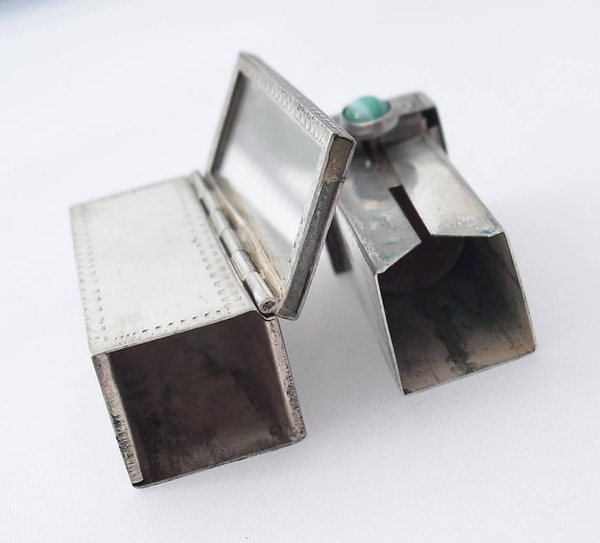
(images from etsy.com)
Despite the silver cases' ubiquity, I'd say the most recognized name-brand spring-loaded lipstick mirror was Max Factor's Hi-Society, which was heavily advertised from their debut in 1958 through approximately 1965.
You might remember I featured these in the Museum's holiday 2016 exhibition. I'm still hunting down all the designs, which actually isn't difficult given how many the company produced.
Next up is a more complex version of the folding mirror. Instead of a tube clip, this was an entire folding hand mirror with the lipstick hidden within the handle. Here's an unmarked, super blingy version. Stratton also made a bunch.
Here are some rather dainty petit point and floral versions by Schildkraut.
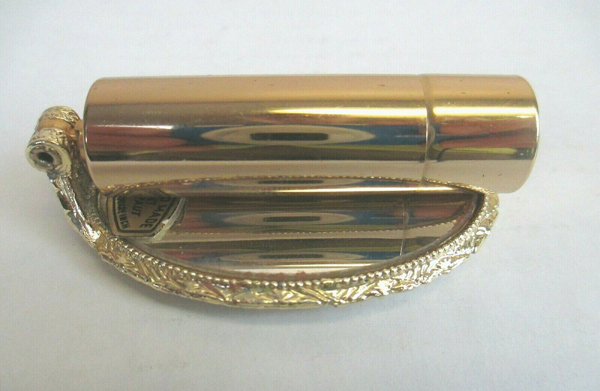
(images from ebay.com)
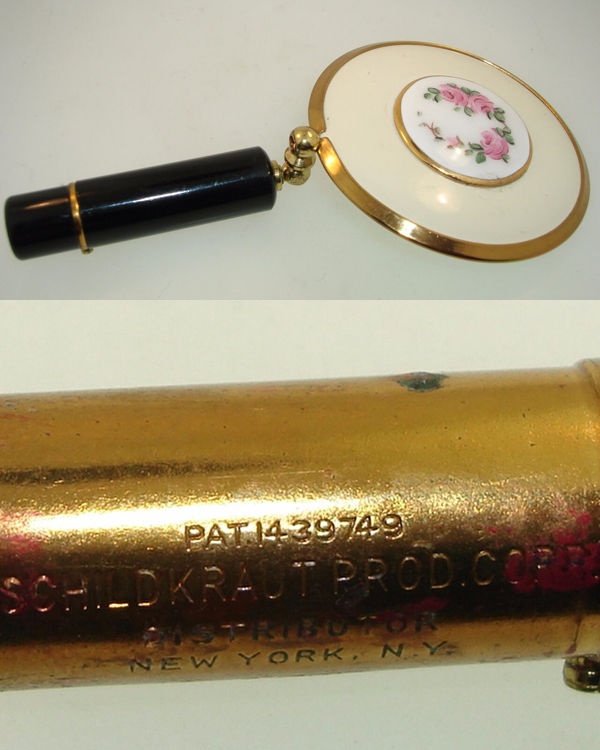
(images from ebay.com)
Schildkraut's represent possibly the earliest form of lipstick mirrors, judging from the patent.
The folding model's popularity continued well into the 1960s, as evidenced by Kigu's "Flipette".
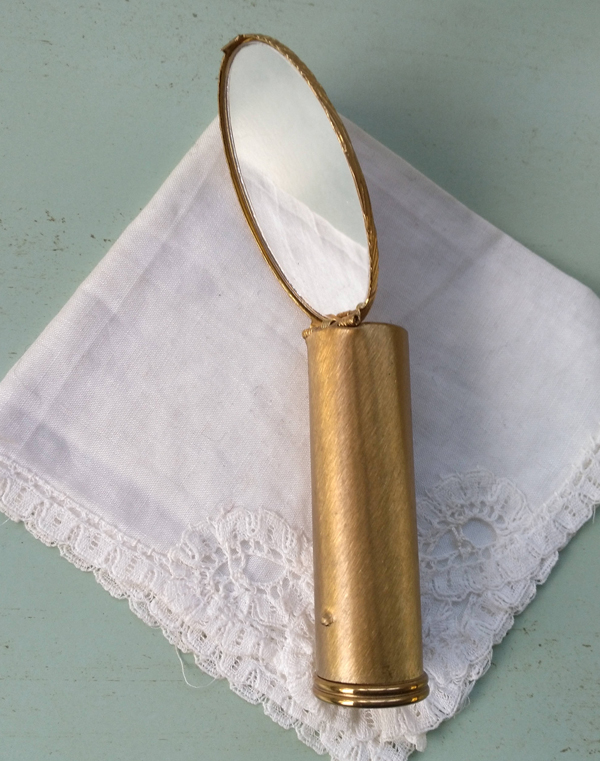
(images from etsy.com)
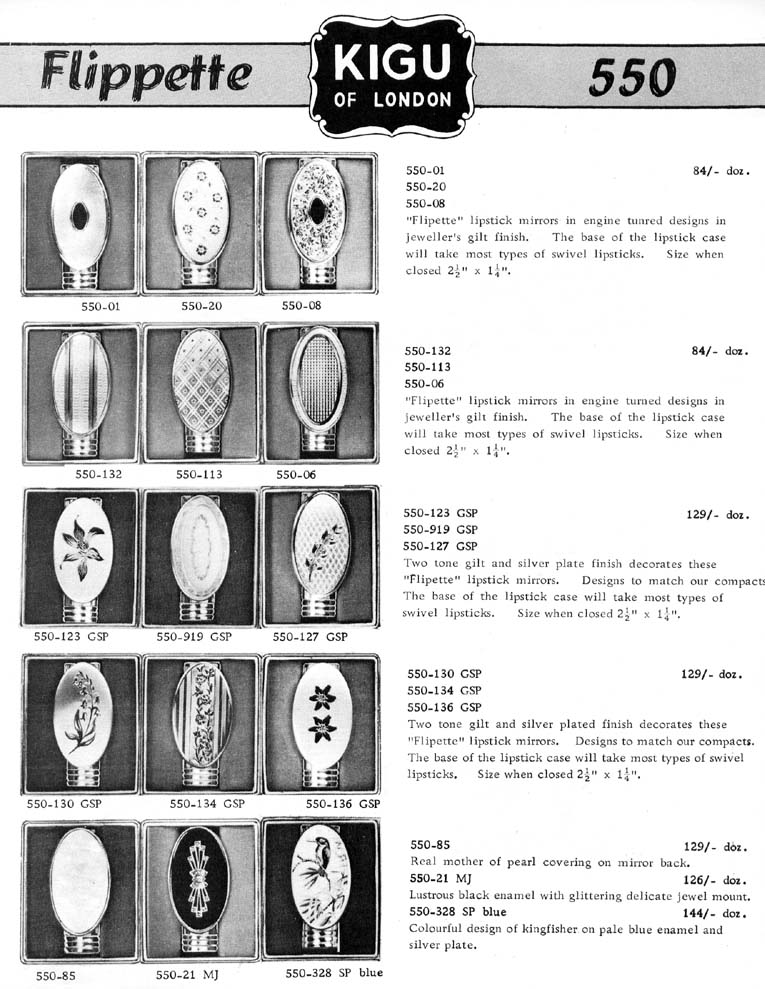
(image from vintage-compacts.com)
Finally, there are the handle inserts. This item from Revlon would appear to be a regular hand mirror, but the lipstick is cleverly hidden in the handle. It was introduced in 1950 as the "biggest news in lipsticks since swivels were born". How very exciting.
Of course, Max Factor upped the design ante with their "Doll Set" lipsticks, which were introduced in 1967.
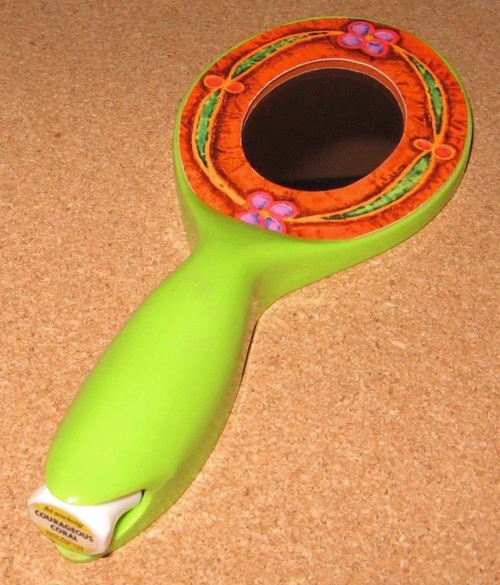
(images from pinterest)
Now that we have a good sense of the types of mirrors that were available, let's spend a little time thinking about why they were made, or at least, why the advertising claimed they were the greatest things since sliced bread. The first reason built-in lipstick mirrors were a necessity – again, according to the advertising at the time – was the ease provided by a fused lipstick and mirror. Presumably women who wore lipstick also would have also carried around mirrored powder compacts, which could be used for lipstick touch-ups. Fumbling around in your purse for a mirrored compact when you just needed to touch up your lips and not your face powder, apparently, was too difficult to handle on a regular basis. As this 1935 newspaper blurb states, "Keeping lipstick and mirror together is the biggest trouble." Oh, the horror! (Bonus points for the blatant racism at the beginning of the piece.)
Such a "harrowing experience" to not be able to find a mirror!
The second reason was that the lack of digging around for a mirror meant lipstick could be applied more discreetly, you know, for "when you want to sneak a look while the boyfriend's back is turned." (More bonus points for the weight/food shaming piece below the lipstick article.) Much like lipstick tissues, lipstick mirrors were meant to be used to avoid an etiquette faux pas.
This 1940 column takes the idea of discretion a step further. As we've seen time and time again, a woman's makeup habits are dictated by what men think. "We suspect that the bold-face manner of applying lipstick is due for a set-back as a table pastime. Recently we heard more than one rumor that men are expressing a dislike for the practice. And it is a smeary, messy looking operation for a beloved with his own dreams about a natural beauty. Better keep him, if not guessing, then not too much in-the-know about your coloring source." Heaven forbid a man actually see a woman mend her lipstick! Ladies, please keep your silly frivolous face painting to yourself so as not to ruin TEH MENZ' unrealistic expectations of so-called natural beauty. I can't roll my eyes hard enough.
Thirdly, one can't be seen with a beat-up compact. Women should always present the prettiest possible cosmetic cases when in public. Seriously though, at least this 1956 clip is straightforward in proclaiming that a lipstick mirror is merely aesthetically pleasing instead of a necessary accessory in the battles against flaunting your makeup application and a messy purse in which no separate mirror can be easily unearthed. Just a little dose of "extra glamour".
And of course, let's not forget that as part of their goal of making a healthy profit, beauty companies are forever trying to invent another superfluous gadget or product and declaring it the next must-have. Perhaps lipstick mirrors were the mid-century version of vibrating mascaras. In any case, despite the lack of popularity for the built-in lipstick mirror as well as the cynicism of modern-day makeup wearers like myself, several brands forged ahead with attempting to resurrect the lipstick mirror over the past 20 years or so.
In late 1999, with much fanfare, Givenchy introduced their Rouge Miroir lipstick designed by by sculptor Pablo Reinoso. Reinoso became Givenchy's Artistic Director for their fragrance and beauty line shortly after the lipsticks' release.
The March 2000 issue of Vibe magazine proclaimed the sleek, futuristic design to be the height of convenience: "No more knives or rearview mirrors". Wait, who uses a knife to apply lipstick?!
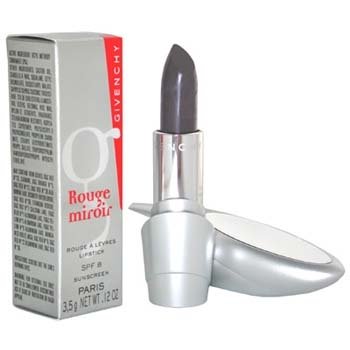
(image from amazon.com)
A year or two later, Estée Lauder launched their Pure Color lipstick line. I believe these mirrored cases came out in the mid-2000s when Pure Color lipsticks were at their height.
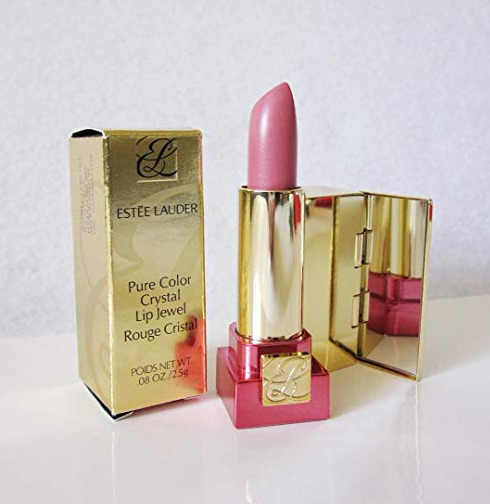
(image from amazon.com)
Some more recent examples I found include this mirrored tube from Kailijumei, a brand best known for their "flower jelly" lipsticks.
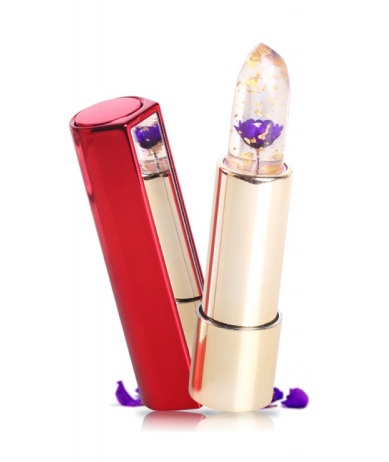
(image from kailijumei.com)
Guerlain's Rouge G series was introduced in the spring of 2018 and comes in a variety of collectible cases (and, duh, I'm working on acquiring them all). The mechanism is similar to Stratton's in that they won't close unless there's a lipstick bullet inside. While practical, it makes for quite the hassle to take photos of the cases only as they keep popping open. I have to tape them closed, which is a less expensive option than buying lipstick bullets to go in each case.
Finally, I spotted this folding lipstick mirror from J-beauty brand Creer Beaute, which was included in their 2018 Sailor Moon-themed collection.
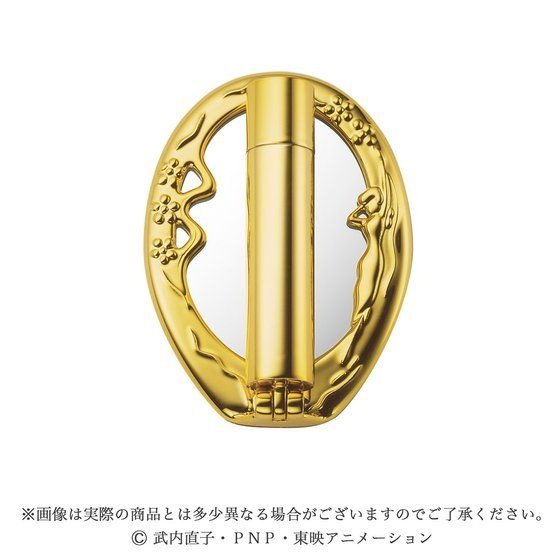
(images from alphabeauty.net)
Still, these designs are not nearly as common as their predecessors from the early-mid 20th century. Why did the popularity of the built-in lipstick mirror fade over time? One theory is that lipstick packaging with built-in mirrors is more expensive than non-mirrored packaging, and therefore, not as appealing to consumers. Guerlain's Rouge Gs, for example, cost $55 ($33 for the bullet and $22 for case) while their KissKiss lipsticks are priced at $37. Going further back in time, Elgin's spring-loaded mirrored case by itself was $5.50, while the price of an average lipstick was $1.10. Why pay for a mirrored lipstick case if you (most likely) already have another mirror available? Yes, you might have to dig around in your purse a bit, but at least it won't be lighter for having spent money on a lipstick/mirror combo. This theory could also explain why clip-on mirrors were seemingly everywhere, as they were the cheaper route to fusing lipstick and mirror.
Another theory for the continuing disinterest in built-in lipstick mirrors could be that for the last 5-10 years there's been increasing demand for less, or at least recyclable, packaging. While some higher-end brands are refillable, most lipsticks sold with a built-in mirror don't appear to have a refill option, and consumers may be less likely to buy a mirrored lipstick tube knowing yet another packaging component will eventually end up in the ocean. Plus, while the new designs are relatively slim, they're still bulkier than lipsticks without built-in mirrors. The majority of beauty consumers, myself included, don't want anything taking up more room in their purse or makeup bag.
Finally, I believe beauty consumers are savvier than they were in the early days of the industry and are less susceptible to marketing and gadgets. A built-in lipstick mirror may have been considered revolutionary in the '40s because swivel tube lipstick had been invented just a few decades prior, but by the '70s these mirrors may have seemed old hat. So certainly by the 21st century we know these designs are not truly a breakthrough, nor are they anything that would be considered a necessity. I featured no fewer than 6 Kailijumei lipsticks in the Museum's spring 2017 rainbow-themed exhibition, and just now noticed there were mirrors on the tubes. The fact that the mirror didn't even register with me, a person who enjoys re-applying her makeup and has spent countless hours poring over product packaging, until now when I'm actually discussing lipstick mirrors shows just how unnecessary a built-in lipstick mirror is. And again, the majority of beauty consumers is likely to be carrying a compact mirror anyway, rendering a lipstick with a built-in mirror redundant. We also know that makeup companies update older designs and market them differently to see what sticks. To cite Guerlain's Rouge G, the description at the website highlights how the user can select both the color and case to suit their individual taste. "Every woman is unique…choose your lipstick from a wide range of shades to match your look: from the most nude to the most extravagant. Choose your case from an array of styles – from the most timeless to the most trendy". Rouge G has the same basic mechanism as the spring-loaded lipsticks of yore – it's especially similar to Max Factor's Hi-Society with the array of designs – but the marketing focuses on the customizable aspects (a concept that has spiked in popularity over the last two or so years…I've been meaning to write something about the craze for name engraving/customization) rather than the newness and convenience of a dedicated lipstick mirror.
What do you think of the built-in lipstick mirror? Would you consider it a must-have? While I certainly appreciate the aesthetics, it's nowhere near a necessity for me.
As you know, from time to time I receive email inquiries from people with cosmetics objects they've stumbled across and would like to know more about. I'm always flattered that people think that I know what I'm talking about and can help them, especially since most of the time I have no idea about the item in question, but sometimes I get irritated when the inquirer's sole objective is to determine how much money they can make off an object they found. At first it seemed this way when the original owner of this very rare compact approached me, asking for more information and how much it might be worth. As we'll see, he turned out to actually have an interest in the compact's history and wasn't after profit.
This was an epic find indeed, easily one of the rarest and most valuable in the Museum's collection. I now present the Ramses powder compact, which debuted in 1923. The design shows an Egyptian woman in profile, holding a perfume bottle in one hand and a flower in the other, which she brings to her nose to enjoy its scent. The pyramids of Giza are just barely visible in the background, while lotus flowers on each side towards the lower third of the compact bloom into an arc of leaves.
I'm not sure if the woman is supposed to be anyone in particular – perhaps Cleopatra – but given that the design is most likely not historically accurate, I'm not going to dwell on it too much.
While there are other ads for the powder that show the compact, which we'll see in a second, I wasn't able to locate any originals. I did, however, find this ad in a French publication from February 1920.
I was hoping to find some good information about the compact for the person who contacted me, and of course, the ever-thorough Collecting Vintage Compacts blog had an excellent post on the history of the Ramses perfume company so I directed the inquirer over there. I don't wish to regurgitate all of the author's hard work on Ramses' backstory – I highly encourage you to check out the post for yourself – but I will provide the abridged version. The Ramses brand was founded in 1919 in Paris and selected Le Blume Import Company to distribute the line in the U.S. in 1921. By 1923 ads for the powder boxes and compacts were appearing in Vogue magazine. As Collecting Vintage Compacts points out, the ad copy is pure nonsense: neither the perfumes nor the powders were produced in Egypt and their formulas certainly did not date back to 1683. How the company even arrived at that arbitrary date is beyond me. However, with the discovery of King Tutankhamun's tomb in November 1922, the Ramses moniker turned out to be quite fortuitous given the ensuing craze for anything Egyptian – clearly the ads wanted to milk the fad for all it was worth. The world was now swept up in the latest wave of Egyptian Revival, a style that incorporated various elements of Egyptian art and culture and encompassed design, fashion and beauty (see this compact depicting Theda Bara as Cleopatra and this ad as examples).
Egypt's influence on Western beauty from the Renaissance to today is a subject I'm looking to cover more thoroughly this year, either in a blog series or an exhibition (or both!) so stay tuned. As viewed through 21st century eyes, it was clearly unabashed cultural appropriation, a white person's fantasy of "exotic", far-off lands and artifacts. However, Egyptian inspired-beauty is such a rich topic that I can't bear not to fully explore it…especially now that I have this gorgeous piece in my hot little hands. Anyway, Collecting Vintage Compacts notes that the Ramses powder case was made by the Bristol, CT-based Zinn Corporation, a company that produced some of the earliest and most memorable compacts in the U.S. I find it interesting that while the powder was scented with the "Secret du Sphinx" fragrance, the compact itself shows a woman rather than the mythical creature. Collecting Vintage Compacts speculates, as I did, that the woman could be Cleopatra, but offered the additional option of Ramses' wife Nefertari. I agree with his conclusion that it really doesn't matter who she is – just a vague Egyptian theme was more than enough to get the point across.
Another version of the compact sported silver edging, a beautiful contrast to the warmth of the brass.
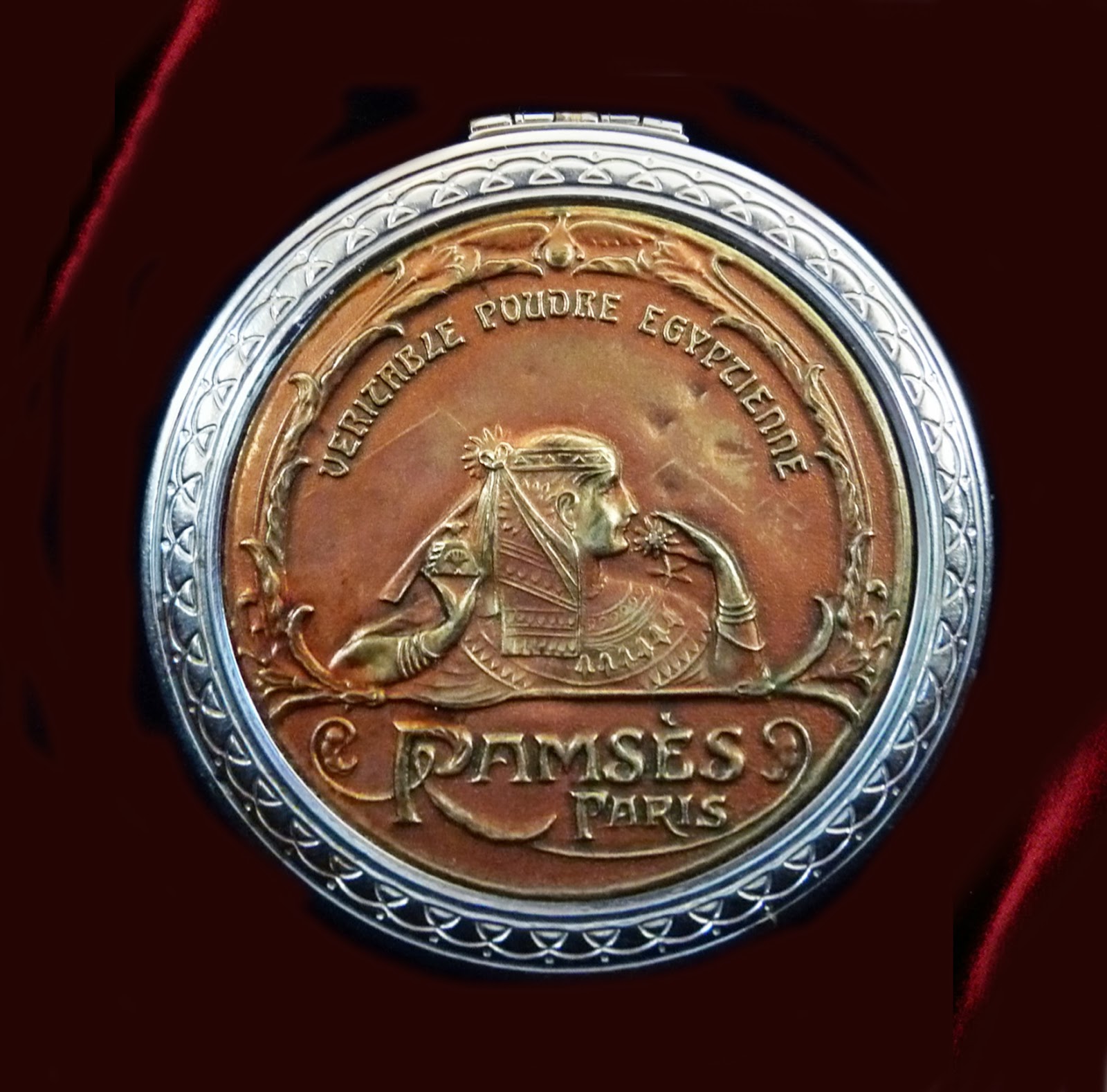
(images from Collecting Vintage Compacts and Ruby Lane)
I also spotted some ads in newspapers. They're not as visually striking as the Vogue ads so I'm not including them here, but they did come in handy for indicating the original retail price of the compact, which was $1.00. The latest ads I could find were from 1925 and both the perfumes and powder were heavily discounted, which indicates Ramses was a flash in the pan.
But why? You would think given the era's craze for Egyptian-inspired design, combined with the slight French flavor (another huge selling point – this was a time when companies actively tried to give their lines and products authentic French or at least French-sounding names) the Ramses company would be able to get more a little more mileage out of their products. Collecting Vintage Compacts unraveled the mystery. As it turns out, the perfumer behind the Ramses brand, one Léon de Bertalot, had begun quite a shady scheme to sell another one of his fragrances. In 1914, 5 years before he launched Ramses, de Bertalot named one of his fragrances Origan. As we know, Coty's L'Origan (launched in 1909) was wildly popular, pulling in roughly $3 million in sales in 1921 alone. De Bertalot decided to capitalize on the company's success and began using the Coty name to sell his own Origan, essentially passing it off as a real Coty product. Coty, rightfully so, cracked down on this very quickly. On May 15th, 1923 a French court found de Bertalot guilty of "unfair competition", and a few days later the U.S. Treasury mandated that any inauthentic products bearing the Coty name were unable to be imported unless they specifically spelled out that they were not affiliated with Coty in any way. Since the Ramses brand had nothing to do with Coty I don't know if the Treasury's mandate applied to Ramses as well, but I'm sure the 6-month jail sentence and fine of 100,000 Francs handed to de Bertolot essentially meant the Ramses brand was out of business. Hence the price markdown of their products by 1925 – I'm guessing stores in the U.S. were trying to offload any leftover stock that was originally imported two years prior. The Le Blume Import Company, in turn, was no longer allowed to distribute any perfumes from any company whatsoever. However, it did import dusting powder tins and glass jars using the Ramses name in the late 1920s.
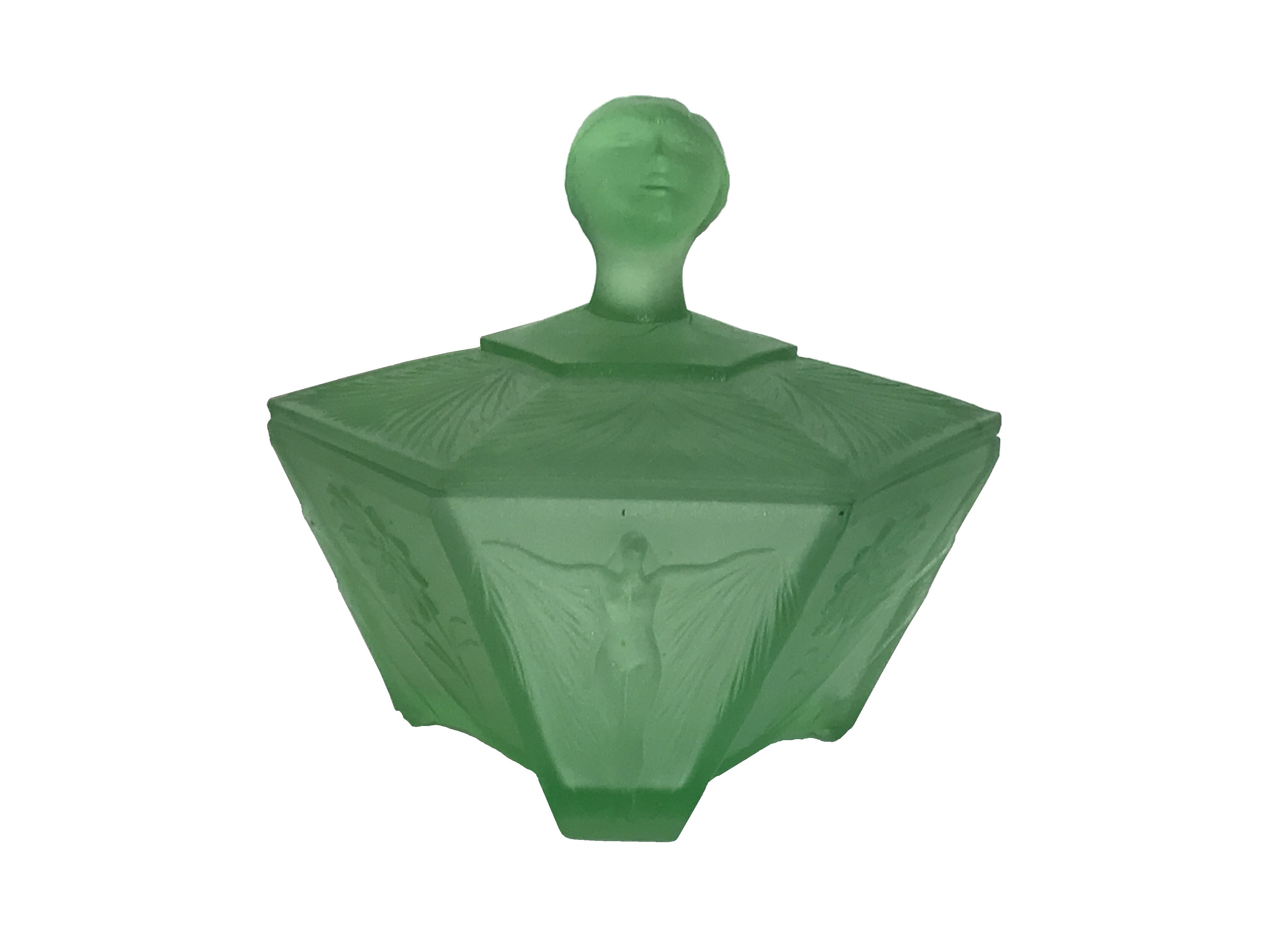
(images from Vanity Treasures and Etsy)
Getting back to the original inquiry that was the impetus for this post, here's the story of how the compact got into my hands from the person who emailed me originally (we'll call him C.) He had found it for $10 in a thrift store (!) but given the unique design, figured it was worth more. After looking through all my collector's guides and not turning up anything, I directed C. to Collecting Vintage Compacts and asked him to please let me know when/if he decided to put it on the market. Obviously I also indicated my great interest in obtaining the compact, but lamented that it was most likely out of my price range. Well, don't you know C. actually wrote back telling me that he was going to put it up for sale on Ebay, but said that while he'd like to get a good price for it (that's only fair, who wouldn't?), he believed that the Museum was the rightful place for the compact, given its rarity and my passion for lovingly researching and preserving these sorts of items. Thus he kindly offered to sell it to me directly and negotiate on price. In the end I think we both got a great deal – he got way more than what he had originally purchased it for and roughly the amount he would have gotten for it if he had put it up for public sale, and I got an amazing find at a fair price for which I was able to avoid an ugly bidding war.
After reading the Ramses history at Collecting Vintage Compacts and browsing the Museum's site, C. seemed genuinely interested in the compact and in the Museum's mission, so I was very happy to see he wasn't just in it for profit and was willing to work with me to ensure the compact went to a great home instead of merely to the highest bidder. :) I really appreciated it, as so many people who ask about value just want to know how much they can get for an item and have absolutely no consideration for the object's history or the Museum, which, as a reminder, is funded entirely out of my own pocket. Not that anyone is obligated to donate rare and valuable items, of course, but they could follow C.'s example and be open to selling their item to me at a price that works for both of us. I know if I came across an object I have no interest in but that other collectors might – say, a rare Barbie Doll – I'd seek out someone who would truly treasure it and give them first dibs.
What do you think? And yay or nay on a series/exhibition on Egyptian-inspired beauty?
The life of a makeup museum curator is insanely glamorous. For example, a lot of people go out on Friday nights, but not me – I have way more thrilling plans. I usually browse for vintage makeup at Ebay and Etsy on my phone while in bed and am completely passed out by 8pm. EXCITING. It was during one of these Friday night escapades that I came across a fabulous box of vintage lipstick pads and naturally, that sent me down quite the rabbit hole. Today I'm discussing a cosmetics accessory that has gone the way of the dodo: lipstick tissues. This is by no means a comprehensive history, but I've put together a few interesting findings. I just wish I had access to more than my local library (which doesn't have much), a free trial subscription to newspapers.com and the general interwebz, as anyone could do that meager level of "research". I would love to be able to dig deeper and have more specific information, but in lieu of that, I do hope you enjoy what I was able to throw together.
The earliest mention of lipstick tissues that I found was January 1932. It makes sense, as several patents were filed for the same design that year.
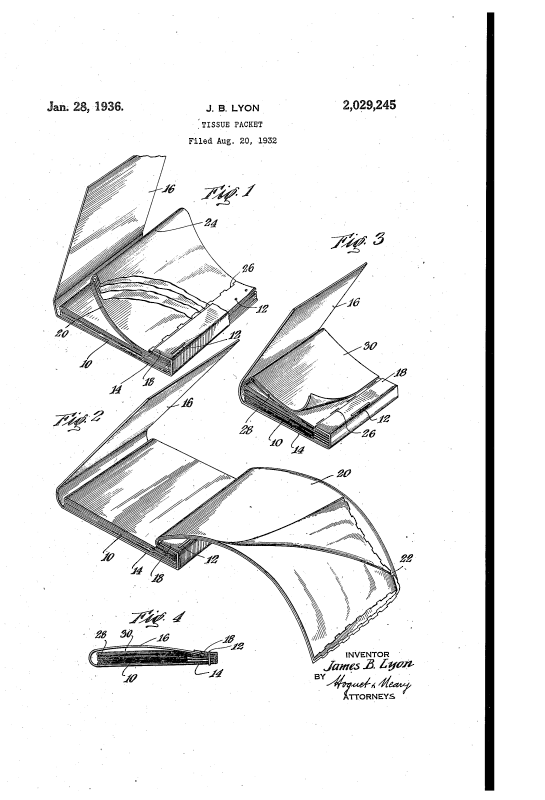
(images from google)
While they might have existed in the 1920s, I'm guessing lipstick tissues didn't become mainstream until the early 30s, as this December 1932 clipping refers to them as new, while another columnist in December 1932 says she just recently discovered them (and they are so mind-blowing they were clearly invented by a woman, since "no mere man could be so ingenious".)
In addition to the tear-off, matchbook-like packages, lipstick tissues also came rolled in a slim case.
This lovely Art Deco design by Richard Hudnut debuted in 1932 and was in production at least up until 1934. I couldn't resist buying it.
By 1935, restaurants and hotels had gotten wind of lipstick tissues' practicality for their businesses, while beauty and etiquette columnists sang their praises. Indeed, using linens or towels to remove one's lipstick was quickly becoming quite the social blunder by the late 30s.
Kleenex was invented in 1924, but it wasn't until 1937, when the company had the grand idea to insert tissues specifically for lipstick removal into a matchbook like package, that these little wonders really took off. You might remember these from my post on the Smithsonian's collection of beauty and hygiene items. The warrior/huntress design was used throughout 1937 and 1938.
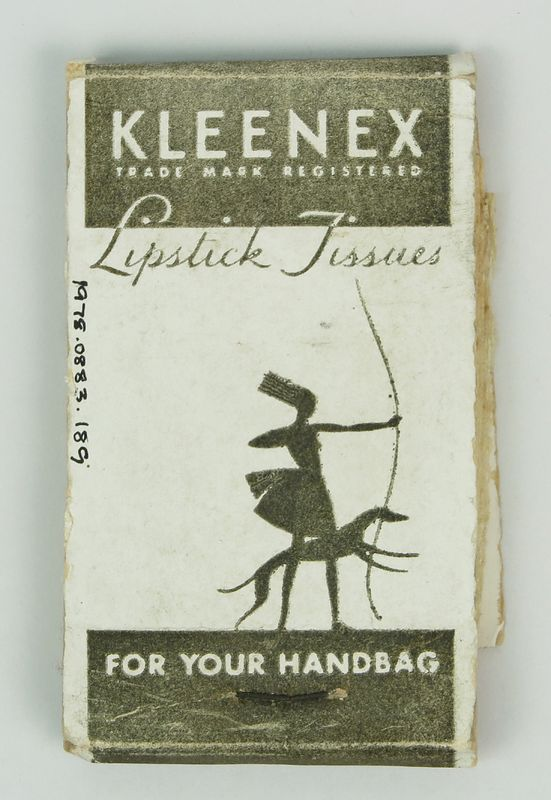 (image from americanhistory.si.edu)
(image from americanhistory.si.edu)
Kleenex started upping the ante by 1938, selling special cases for their lipstick tissues and launching campaigns like these "true confessions", which appeared in Life magazine (and which I'm sure were neither true nor confessions.) With these ads, Kleenex built upon the existing notion that using towels/linens to remove lipstick was the ultimate etiquette faux pas, and one that could only be avoided by using their lipstick tissues.
These ads really gave the hard sell, making it seem as though one was clearly raised by wolves if they didn't use lipstick tissues. Or any tissues, for that matter. Heaven forbid – you'll be a social pariah!
Look, you can even use these tissues to cheat on your girlfriend! (insert eyeroll here)
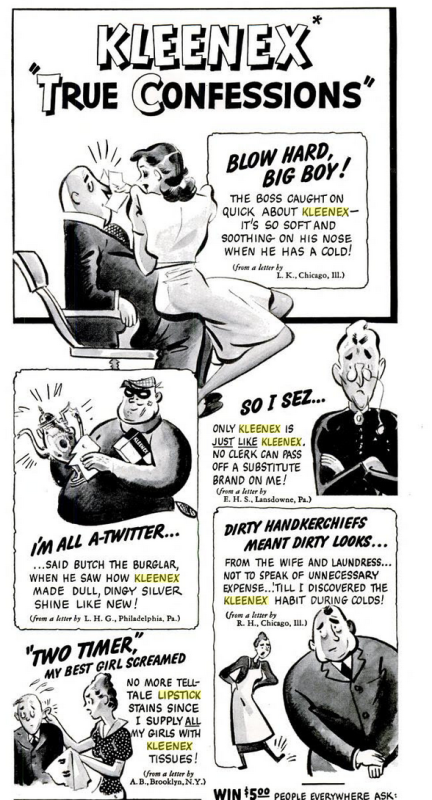
(images from books.google.com)
Not only that, Kleenex saw the opportunity to collaborate with a range of companies as a way to advertise both the companies' own goods/services and the tissues themselves. By the early '40s it was difficult to find a business that didn't offer these gratis with purchase, or at least, according to this 1945 article, "national manufacturers of goods women buy." And by 1946, it was predicted that women would be expecting free tissue packets to accompany most of their purchases.
Needless to say, most of them consisted of food (lots of baked goods, since apparently women were tethered to their ovens), and other domestic-related items and services, like hosiery, hangers and dry cleaning.
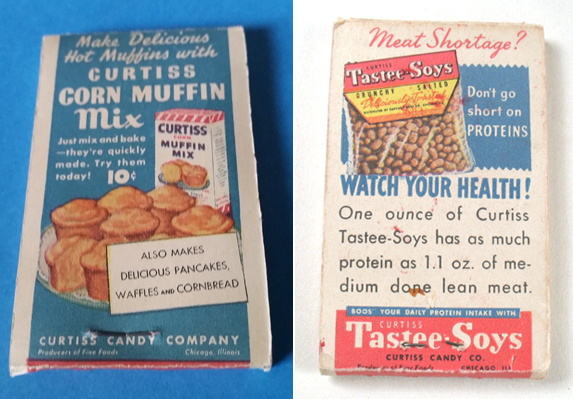 (images from ebay and etsy.com)
(images from ebay and etsy.com)
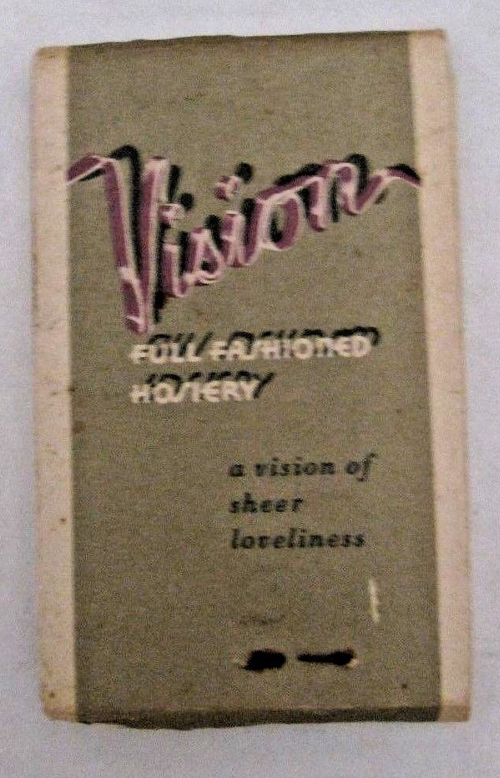
(image from ebay.com)
Naturally I had to buy a few of these examples for the Museum's collection. Generally speaking, they're pretty inexpensive and plentiful. The only one I shelled out more than $5 for was the Hudnut package since that one was a little more rare and in such excellent condition. Interestingly, these have a very different texture than what we know today as tissues. Using contemporary Kleenex to blot lipstick only results in getting little fuzzy bits stuck to your lips, but these vintage tissues have more of a blotting paper feel, perhaps just a touch thicker and ever so slightly less papery. It could be due to old age – paper's texture definitely changes over time – but I think these were designed differently than regular tissues you'd use for a cold.
Anyway, Museum staff encouraged me to buy the cookie one. 😉
I took this picture so you could get a sense of the size. It seems the official Kleenex ones were a little bigger than their predecessors.
Wouldn't it be cool to go to a restaurant and see one of these at the table? It would definitely make the experience seem more luxurious. I certainly wouldn't feel pressure to use them for fear of committing a social sin, I just think it would be fun.
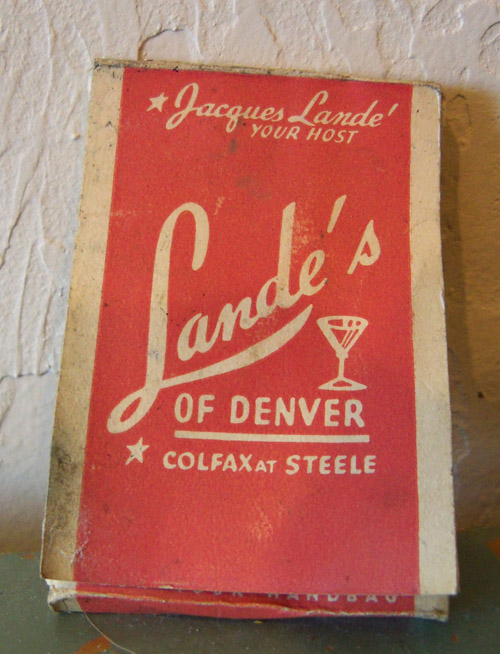
(image from etsy.com)
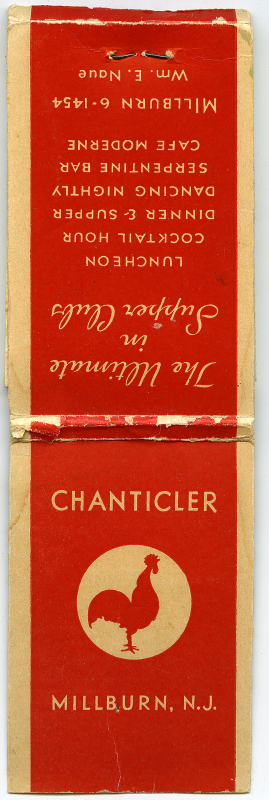
(image from mshhistoc.org)
I figured having a restaurant/hotel tissue packet would be a worthy addition to the Museum's collection, since it's another good representation of the types of businesses that offered them. I'd love to see a hotel offer these as free souvenirs.
Here's an example that doesn't fit neatly into the baked goods/cleaning/hotel categories.
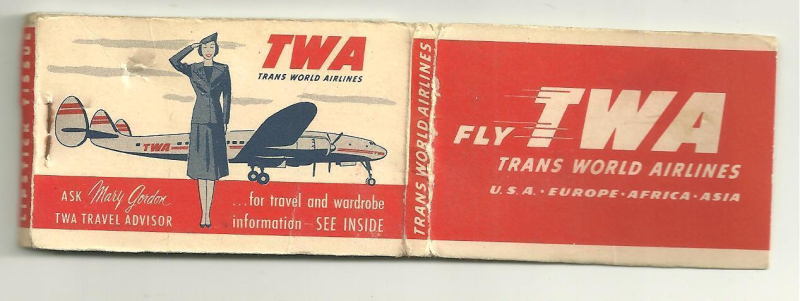 (image from ebay.com)
(image from ebay.com)
This one is also interesting. Encouraging women to be fiscally responsible is obviously more progressive than advertising dry cleaning and corn nut muffins, but it's important to remember that at the time these were being offered by Bank of America (ca. 1963), a woman could have checking and savings accounts yet still was unable to take out a loan or credit card in her own name. One step forward, 5 steps back.
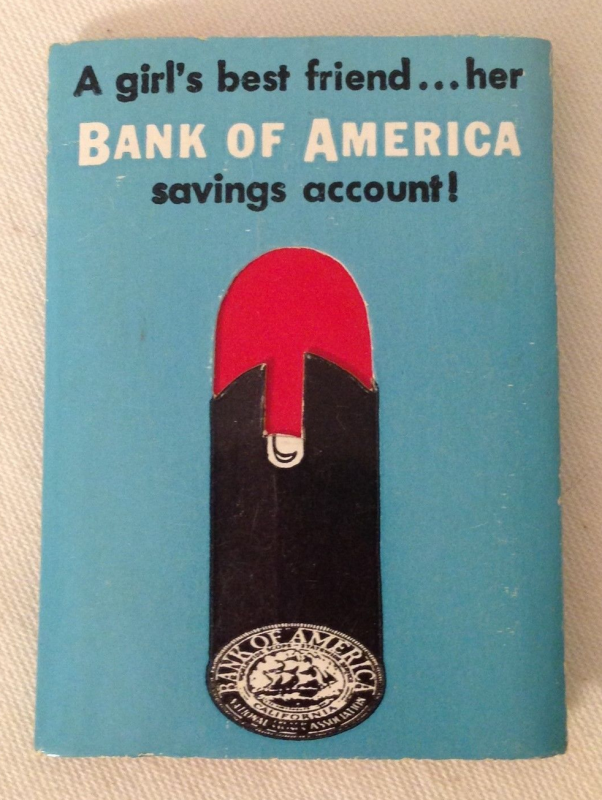 (image from ebay.com)
(image from ebay.com)
Of course, cosmetics companies also made their own lipstick tissues.
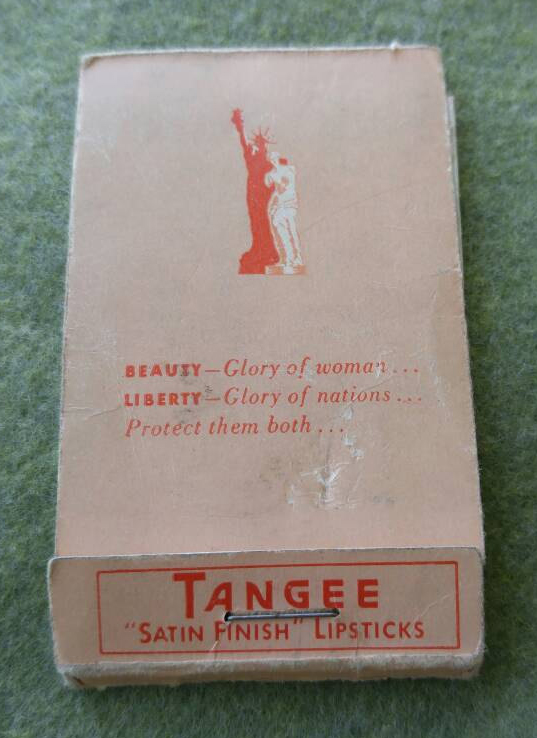 (image from etsy.com)
(image from etsy.com)
I was very close to buying these given how cute the graphics are, but didn't want to spend $20. (I think they're now reduced to $12.99, if you'd like to treat yourself.)
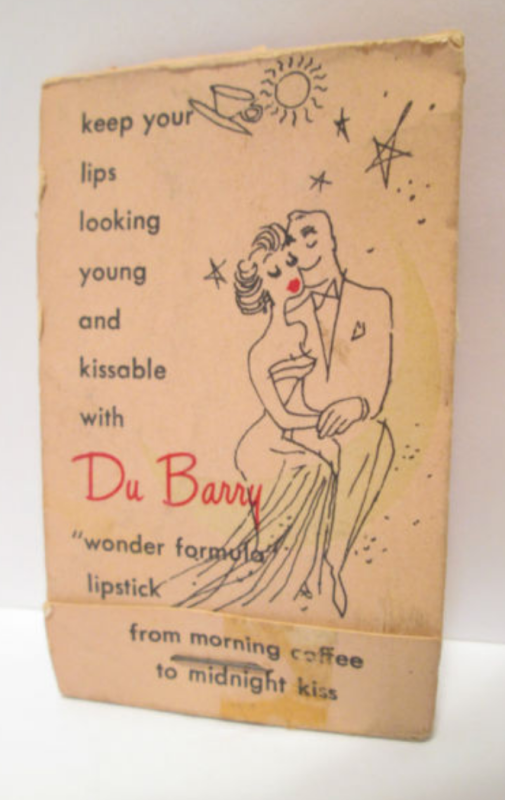 (image from ebay.com)
(image from ebay.com)
Plus, I already have these DuBarry tissues in the collection.
Funny side note: I actually found a newspaper ad for these very same tissues! It was dated July 27, 1948, which means the approximate dates I included in my DuBarry post were accurate.
By the late '40s, lipstick tissues had transcended handbags and became popular favors for various social occasions, appearing at country club dinner tables to weddings and everything in between. I'm guessing this is due to the fact that custom colors and monogramming were now available to individual customers rather than being limited to businesses.
"Bride-elect"? Seriously?
While the matchbook-sized lipstick tissues are certainly quaint, if you wanted something even fancier to remove your lipstick, lipstick pads were the way to go. These are much larger and thicker than Kleenex and came imprinted with lovely designs and sturdy outer box. This was the item that made me investigate lipstick tissues. I mean, look at those letters! I was powerless against their charm.
I couldn't find anything on House of Dickinson, but boy did they make some luxe lipstick pads.
This design is so wonderful, I'd almost feel bad using these. If I were alive back then I'd probably go digging through my purse to find the standard Kleenex ones.
I also couldn't really date these too well. There's a nearly identical box by House of Dickinson on Ebay and the description for that dates them to the '60s, which makes sense given the illustration of the woman's face and the rounded lipstick bullet – both look early '60s to my eye.
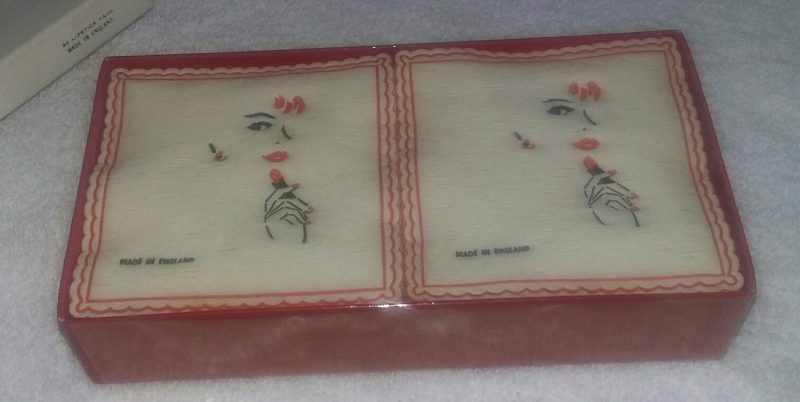
However, the use of "Milady" and the beveled shape of the lipstick bullet, both of which were more common in the '30s and '40s, make me think the ones I have are earlier.
By the mid-late '60s, it seems lipstick tissues had gone out of favor. The latest reference I found in newspapers dates to November 1963, and incidentally, in cartoon form.
I'm not sure what caused lipstick tissues to fall by the wayside. It could be that there were more lightweight lipstick formulas on the market at that point, which may not have stained linens and towels as easily as their "indelible" predecessors – these lipsticks managed to easily transfer from the lips but still remained difficult to remove from cloth. Along those lines, the downfall of lipstick tissues could also be attributed to the rise of sheer, shiny lip glosses that didn't leave much pigment behind.
While these make the most sense, some deeper, more political and economic reasons may be considered as well. Perhaps lipstick tissues came to be viewed as too stuffy and hoity-toity for most and started to lose their appeal. My mother pointed out that lipstick tissues seemed to be a rich people's (or at least, an upper-middle class) thing – the type of woman who needed to carry these in her handbag on the reg was clearly attending a lot of fancy soirees, posh restaurants and country club dinners. This priceless clipping from 1940 also hints at the idea of lipstick tissues as a sort of wealth indicator, what with the mention of antique table tops and maids.
Lipstick tissues were possibly directed mostly at older, well-to-do "ladies who lunch", and a younger generation couldn't afford to or simply wasn't interested in engaging in such formal social practices as removing one's lipstick on special tissues. Plus, I'm guessing the companies that used lipstick tissues to advertise labored under the impression that most women were able to stay home and not work. With a husband to provide financially, women could devote their full attention to the household so advertising bread recipes and dry cleaning made sense. This train of thought leads me, naturally, to feminism: as with the waning popularity of ornate lipstick holders, perhaps the liberated woman perceived lipstick tissues as too fussy – a working woman needed to pare down her beauty routine and maybe didn't even wear lipstick at all. Lipstick tissues are objectively superfluous no matter what brainwashing Kleenex was attempting to achieve through their marketing, so streamlining one's makeup regimen meant skipping items like lipstick tissues. Similarly, after reading Betty Friedan's 1963 landmark feminist screed The Feminine Mystique, perhaps many women stopped buying lipstick tissues when they realized they had bigger fish to fry than worrying about ruining their linens. Then again, one could be concerned about women's role in society AND be mindful of lipstick stains; the two aren't mutually exclusive. And the beauty industry continued to flourish throughout feminism's second wave and is still thriving today, lipstick tissues or not, so I guess feminism was not a key reason behind the end of the tissues' reign. I really don't have a good answer as to why lipstick tissues disappeared while equally needless beauty items stuck around or continue to be invented (looking at you, brush cleansers). And I'm not sure how extra lipstick tissues really are, as many makeup artists still recommend blotting one's lipstick to remove any excess to help it last longer and prevent feathering or transferring to your teeth.
In any case, I kind of wish lipstick tissue booklets were still produced, especially if they came in pretty designs. Sure, makeup remover wipes get the job done, but they're so…inelegant compared to what we've seen. One hack is to use regular facial blotting sheets, since texture-wise they're better for blotting than tissues and some even have nice packaging, so they're sort of comparable to old-school lipstick tissues. Still, there's something very appealing about using a highly specific, if unnecessary cosmetics accessory. I'm not saying we should bring back advertising tie-ins to domestic chores or the social stigma attached to not "properly" removing one's lipstick on tissues, but I do like the idea of sheets made just for blotting lipstick, solely for the enjoyment of it. I view it like I do scented setting sprays – while I don't think they do much for my makeup's longevity, there's something very pleasing about something, like, say, MAC Fruity Juicy spray, which is coconut scented and comes in a bottle decorated with a cheerful tropical fruit arrangement. As I always say, it's the little things. They might be frivolous and short-lived, but any makeup-related item that gives me even a little bit of joy is worth it. I could see a company like Lipstick Queen or Bite Beauty partnering with an artist to create interesting lipstick tissue packets. Indeed, this post has left me wondering why no companies are seizing on this opportunity for profit.
Should lipstick tissues be revived or should they stay in the past? Why do you think they're not made anymore? Would you use them? I mean just for fun, of course – completely ignore the outdated notion that one is a boorish degenerate with no manners if they choose to wipe their lips on a towel, as those Kleenex ads would have you believe. 😉
For the majority of inquiries I receive - say, around 75% – I'm ashamed to admit that I can't provide any information. I do enjoy researching them but I loathe not being able to give a definitive answer on the item or brand people are asking about. Recently I receive an inquiry from a woman who was, sadly, going through her deceased mother's belongings and came across 4 gorgeous compacts that she wanted to know a little more about. While I was still not able to provide solid information for a couple of them, I was able to delve a bit more deeply into 2 of them. I guess 50% is better than my usual rate for inquiries!
First up is this lovely gold-tone number with a sunburst pattern on the front and a basket weave pattern on the back.
Fortunately the puff was still in there so I could see the brand. The Melissa company, according to the British Compact Collectors' Society, dates from around the 1950s-70s. Says one researcher: "Melissa is thought to have been based in Acton, London W3 from the early 1950s, but I found that by 1962 the company had premises in Arundel Road, Uxbridge, Middlesex. In 1970, the company was still listed at this address in a telephone directory, but by 1972 another company occupied the site. A local trade directory of 1976 listed Searchlight Products, so possibly the firm was still trading at this later date, but I have been unable to find out at what date it ceased manufacturing compacts."
Next up is a "sweetheart" black enamel compact, so named for their popularity among WWII soldiers who gave them as gifts to their loved ones during wartime. Without a maker's mark I couldn't identify the brand, but from what I could make out the insignia in the heart looks a bit like the "prop and wings" motif from the U.S. Air Corps. I asked the submitter if anyone in her family was in the military and she confirmed that her father was in the Army Air Force during WWII. What a sweet gift for her mom.
I'd love to write a comprehensive history of sweetheart compacts, but it's such a huge project that it will have to wait for when I have time…like, maybe when I'm retired. 🙁
For these last two a little more information was available. Zell was a leading compact company from the '30s-'60s and was one of the "5th Avenue" lines, along with Rex, Dorset, Columbia and Dale. Zell had some quite novel compact designs early on, including the "First Nighter" – a compact with a flashlight that was released in the '30s (can you believe that?!) But Zell was primarily known as a solid brand that offered understated, stylish designs as well. The compact in question is an elegantly striped square piece with rounded edges.
I tried to find a little more information from my local library about the company, but came up mostly empty-handed. I learned through a few meager news clippings that the company was founded by David H. Zell, who passed away in 1944. While his widow Sophie was technically President, it was the Vice President, one of their sons Daniel D. Zell, who was really running the show, given this clipping (not to mention numerous patents in his name.)
After I scoured the historical newspapers, I decided to try old-fashioned googling to at least try to find when the Zell company was founded and when it went out of business. I didn't find those dates, but I did unearth something quite interesting and bought it immediately.
Well, look what I spy! It's the very same compact! The ad indicates that this particular style actually had a name: it was called the "Countess". Here it is up close in case you couldn't make it out. (The one above is the "Aristocrat" and the one below is the "Princess". Ooh la la.)
When I originally researched this inquiry I guessed that the compact in question was from the '50s, as that was the height of Zell's popularity and, in my opinion, gold-tone compacts. But I was wrong. The promotional ad is from 1946, so it must have been released if not that year then around then. While I'm still a little miffed at not being able to put together a full history of Zell, I'm glad I could at least identify this particular compact. It was complete luck but I'll take it. 🙂
I saved the most interesting one for last. I couldn't for the life of me recognize the brand, as the photo of the mark on the back was too dark and small.
Thankfully the submitter included a picture of the puff. I recognized the concentric L-shapes as the logo belonging to Lucien Lelong, a famed French couturier turned perfumer and cosmetics manufacturer.
The design of the compact is truly fascinating. The intricate, regal birds are reminiscent of motifs found on royal crests, and I can't say I've ever seen a compact with little rings attached to it. Off I went to find more information and found a few ads so I could give a date of when this compact was released. Known as the "tambourine" compact, it looks like it first appeared in September 1948. The rings could be simply decorative and just there to be "pleasant sounding", or perhaps Mom could attach some charms to them – seems they were really pushing this as either a Valentine's Day or Mother's Day gift. It may also have waned in popularity by 1950, given the price drop from the original $5 to $0.99. As a side note, my mind is always blown by the retail prices of vintage pieces! They seem so inexpensive, but according to this online calculator a $5 compact would cost approximately $52 nowadays. Still, that's a reasonable price for a nice compact…and it would be only $10.13 on sale. 🙂
LOL at "gifty!" These old ads crack me up sometimes.
I was really curious to know why Lelong decided to introduce this compact, as it didn't seem to have a connection to any of the company's fragrances or couture. I did come across this "Ting a Ling" perfume bottle which also had rings attached and was released around the same time as the compact.
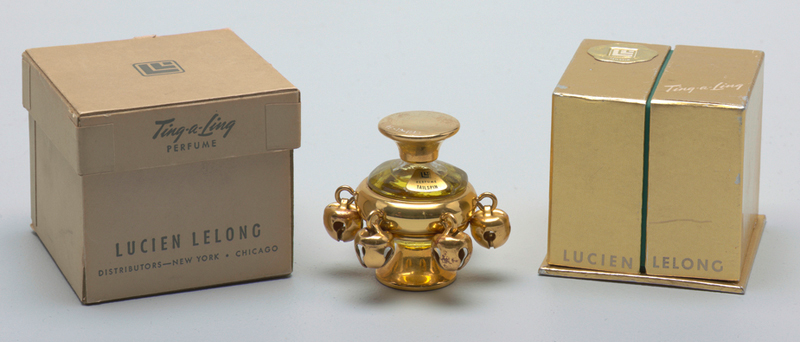
(image from collection.cooperhewitt.org)
But as you can see, it has bells, whereas I didn't see any Tambourine compacts with bells. According to the New York Times ad above, the compact was a replica of a vintage French tambourine, which, when I first laid eyes on that description, sounded like utter marketing garbage. However, thanks to extensive information provided on Lelong by the Fashion Institute of Design and Merchandising, it's entirely possible that the design was indeed inspired by a vintage tambourine. Lelong employed the services of noted artist Peter Fink to create novel, unique packaging for his perfumes and lipsticks, such as the Ting a Ling bottle and Full Dress lipstick mentioned in the ad above, so it's probable that Fink came up with the tambourine compact design as well. As for the notion that the compact was specifically a French tambourine replica, that's also credible given Lelong's love for his home country. So maybe the advertising isn't a complete pile of crap spun by unscrupulous marketing directors.* ;) Anyway, I was happy that I could find a name and date for this compact. This is definitely one I'd love to add to my collection, but they are rare (read: expensive, especially when in good condition) and tend to get snatched up immediately.
In closing, I'd like to thank the person who took the time to share these items with me. Since I was able to provide a couple tidbits, this was one of the few inquiries that didn't end with me getting very upset at finding zero information. Plus, all of the compacts are great from a design standpoint. Even if I didn't find a single thing about them, I would have just enjoyed looking at them.
What do you think? Which of these is your favorite?
*Eh, it probably is. Another newspaper ad from December 1948, which I didn't clip since I refuse to upgrade to the "premium" subscription of newspapers.com (they're such jerks – this stuff should be free!), and my local library didn't carry the particular newspaper, notes that the tambourine is an "exact replica of a g—y's tambourine". Oof. That would be pretty unacceptable language now, not to mention that it makes me doubt how inspired the design was. Or it could also be a matter of marketing to different geographic areas – perhaps the advertising people thought that "French" would be more appealing to what they perceived to be a high-fashion East Coast crowd so they used it in the ad that ran in the New York Times, and changed the description to the g-word for simple Midwestern folks, whom they assumed had less stylish taste than New Yorkers and may have been put off by anything described as French (the g-word ad was found in the Indianapolis Star.)
Welcome to the Makeup Museum's spring 2017 exhibition! As you may know, for the past few months I've been hopelessly under the spell of anything holographic/iridescent/prismatic, and I think this morphed into an obsession with all the colors of the rainbow. (Or it could be Desus and Mero's nightly rainbow feature seeping into my subconscious.) Duochrome makeup is obviously different than rainbow makeup – I see the former as having color-shifting principles, while the latter is vibrant yet static – but I'd argue that they're all on the same…spectrum. (Sorry, couldn't resist). What I mean is that merely colorful makeup is different than holographic, but they share similar qualities. Generally speaking, I was inspired by the broader notion of color play and the endless possibilities a variety of colors can provide. I've always loved vividly colorful makeup because as we'll see, over the years it's become synonymous with fun and self-expression, which is basically my makeup credo. From 6-hued rainbow highlighters and a set of primary colors to create unique shades to more subtle gradient palettes and sheer lipsticks, makeup that encompasses the whole spectrum allows for a great amount of experimentation. Even color correctors offer the opportunity to play. I wanted this exhibition to express the joy and creativity that a wide range of colors can bring, especially when viewed as a collective whole such as a rainbow.
While I could have probably could have done an entire rainbow-themed exhibition, there were some new, non-rainbowy releases that were simply too good not to include, plus I thought they added a nice balance to all the color. Also, did you notice the labels? I got the idea to make them a gradient rather than all one shade, but my husband, super smarty pants that he is, chose the exact colors and how to arrange them. I think this is the first exhibition where I had to determine where everything was going prior to printing the labels. Usually I just print them out and figure out placement of the objects later since I can always move the labels around, but this time I had decide on placement first since moving things would mess up the gradation effect.
Let's take a closer peek, shall we?
Top shelves, left to right.
I spotted this 1970 Yardley set on ebay and knew it would be perfect.
The box isn't in the best shape but aren't the graphics so cool?!
I love that the insert encourages you to have fun and experiment. It's a stark contrast to actual ad for the product, which, underneath its seemingly feminist veneer, is horrifically ageist.
I tried cleaning up the tubes but I scrubbed too hard on the yellow one, which resulted in a few cracks. I forget these things are over 40 years old and that plastic doesn't necessarily remain durable for that amount of time.
The similarity between the eye makeup for Dior's spring 2017 collection campaign and an ad from 1973 is striking.
My heart skipped a beat when I saw that Addiction would be featuring the work of Swedish artist Hilma af Klint on their compacts this spring. Af Klint's work really spoke to me and I'm so happy Addiction helped spread the word about her.
Second row, left to right.
These lipsticks are so delectable!
I know it's just a fake flower with highlighter dusted on top, but it still makes me swoon.
Still haven't figured out a name for this little lady.
If you remember that popular video that was making the rounds a little while ago, it showed a Charles of the Ritz powder bar.
If I ever display this again I'll update the label. Turns out Charles of the Ritz tried to bring back the service in August of 1988, but I don't think it stuck around long. Perhaps they couldn't compete with the likes of Prescriptives, who was by that point leading the way in custom blending? (Sidenote: I'm tickled at how the article is written by Linda Wells, who was just 2 years shy of launching what would become the world's best-known beauty magazine, and how it also cites Bobbi Brown and refers to her as simply a "makeup artist." Little did they know that Bobbi's own line would be taking the makeup world by storm in another 3 years.)
Third row, left to right.
I'm not sure why Guerlain used a rainbow for this spring's campaign and not for their summer 2015 Rainbow Pearls, but they look good together.
Shiseido 7 Color Powders Centennial set (well, part of it):
Burberry Silk and Bloom palette:
Bottom row, left to right.
Rainbow highlighters…I just received word that the original was re-stocked so I will have to purchase it. 🙂
Loubichrome nail polishes:
Interestingly, when I working on the label I came across a Vogue interview with Julie Verhoeven that was published after I had posted about these makeup sets. She clarified that Jacobs had specifically requested to revisit the imagery on the 2002 Louis Vuitton collection, so it wasn't a random decision to go with that style. As for the frog motif, which I am completely smitten with, it was most likely a nod to Jacobs' fondness for the animal (another recent interview with Verhoeven tipped me off.)
Ah! I was so excited when this set popped up on ebay I could hardly contain myself. This is probably the best representation of late '60s/early '70s beauty. It doesn't have the insert but overall it's in great condition. I don't know whether this particular set is specifically the pastel version mentioned in the ad (which is a printout of an original from 1973 – forgot to put that on the label, oops) or the regular non-pastel crayons, but I was overjoyed to finally get one into the Museum's collection.
In doing a little background research for this exhibition I came across some interesting things. I couldn't possibly pull together a comprehensive history of colorful/rainbow-inspired makeup, but here's a quick look back on some of the highlights. While color correcting powders existed early on in the modern beauty industry, it seems as though the more colorful side of makeup wasn't popularized until the early '60s. Ads for collections featuring a robust range of vibrant shades included words like "fun", "play" and "experiment", thereby associating color variety with happiness and creativity.
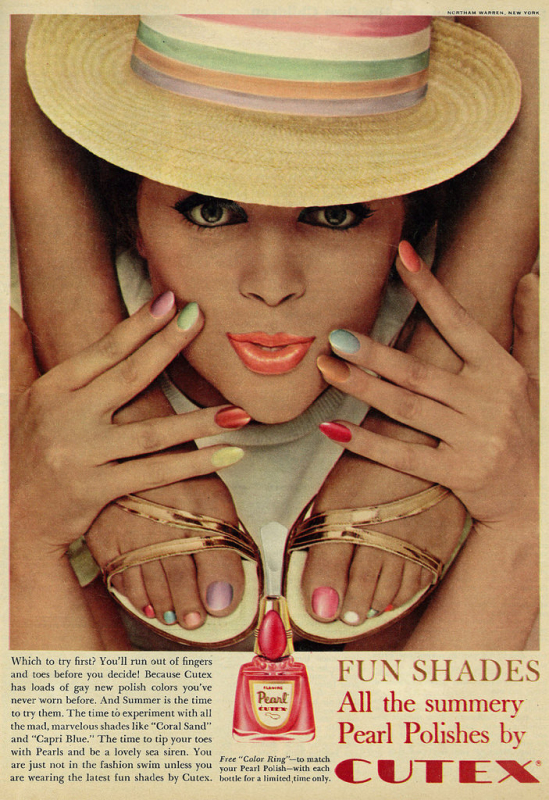 (image from flickr.com)
(image from flickr.com)
This was the earliest ad I could find that mentions a "rainbow" of shades.
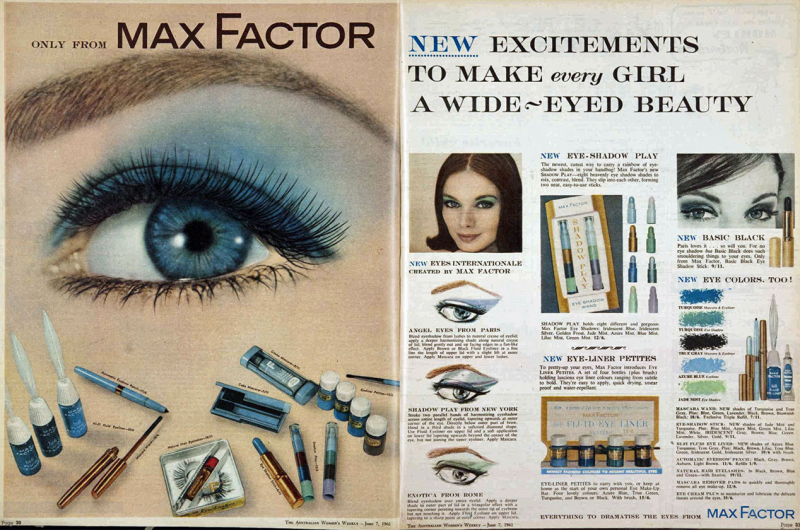 (image from hair-and-makeup-artist.com)
(image from hair-and-makeup-artist.com)
This 1967 ad not only depicts a spectrum of color, it encourages the wearer to create different looks by adding varying amounts of water to the pigments. I'm assuming you could adjust the opacity this way.
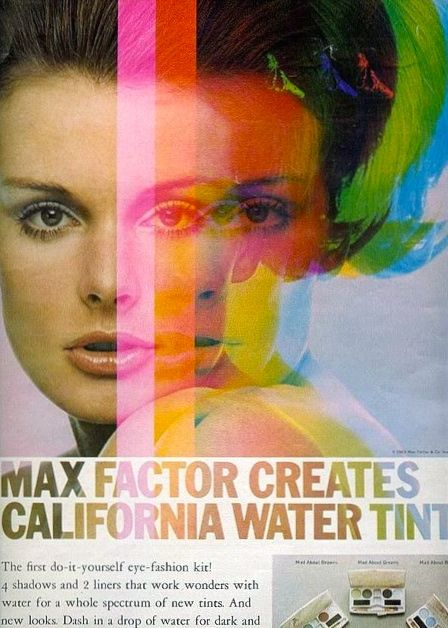
(image from pinterest.com)
While I love the Yardley Mixis set and the classic Mary Quant crayons, I think this brand is my favorite representation of late '60s beauty, at least in terms of advertising (you can see more here). It's so crazy and psychedelic…looking at this makes me want to dance around in a field with flowers in my hair, LOL. Sadly I was unable to track down any original makeup or ads from this line, which I believe was exclusive to Woolworth's in the UK.
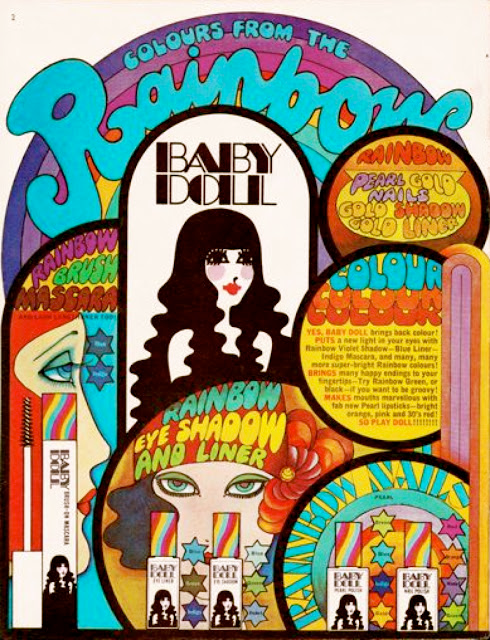
(image from sweetjanespopboutique.com)
The demand for color didn't end with the '60s, as evidenced by these early '70s Yardley and Dior ads.
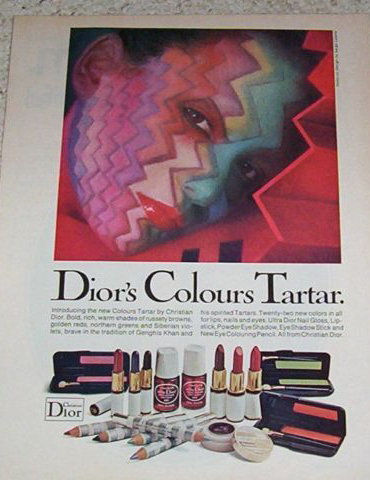
(images from ebay.com)
Once again, a variety of colors is linked to self-expression and fun.
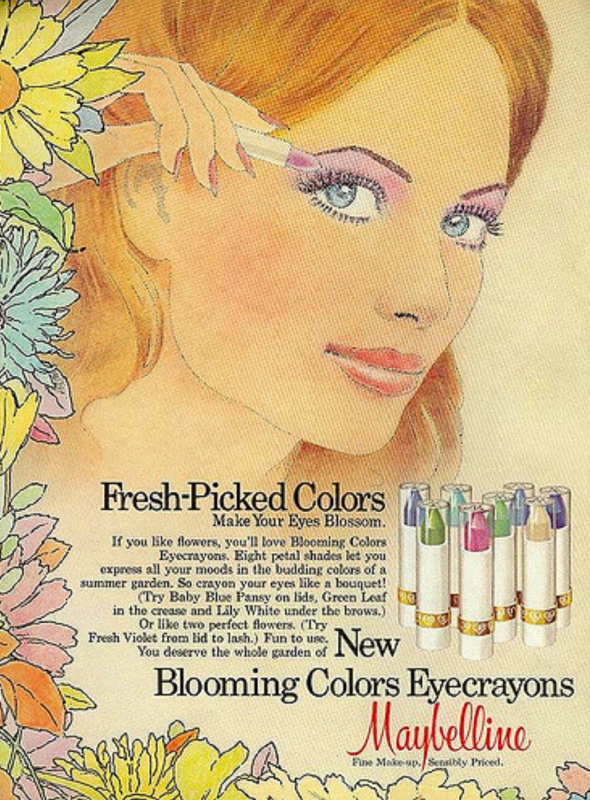 (image from flickr.com)
(image from flickr.com)
Dior kept the color game strong in the '80s. (There was a 1981 Elizabeth Arden collection entitled Rainbows, but it didn't really offer much of a shade range).
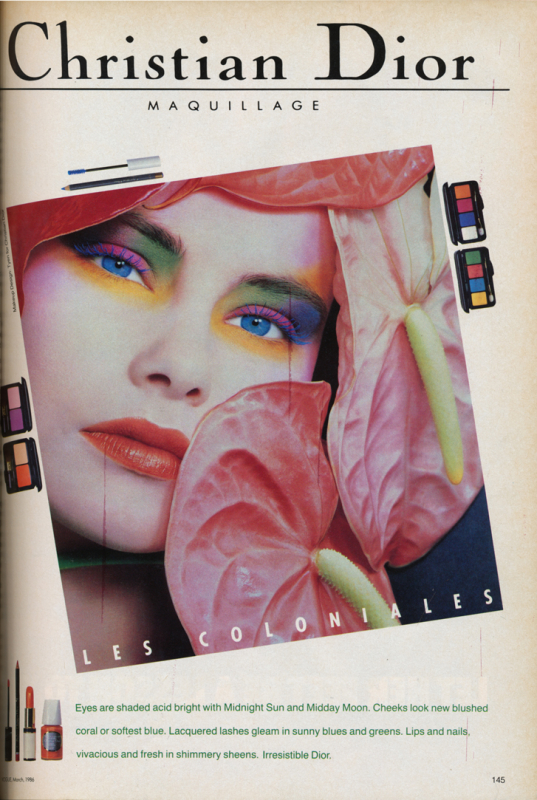 (image from sighswhispers.blogspot.com)
(image from sighswhispers.blogspot.com)
More recently, rainbow-inspired beauty has had its moments. The models at Peter Som's spring 2013 runway show sported pastel rainbow eye shadow, while later that year, Sephora's holiday collection brush set featured iridescent rainbow handles. For summer 2015 MAC released a collection with basically the same finish on the packaging, and come November, Smashbox's collaboration with artist Yago Hortal offered an eye-popping array of shades. I'd argue that 2016 was the tipping point for the rainbow beauty craze, with fashion designers leading the way. These runway looks helped set the stage for the likes of ColourPop's rainbow collection and Urban Decay's Full Spectrum palette, both released last year, along with MAC's Liptensity collection, which brought a whole new dimension to color perception. While it wasn't a rainbow-themed collection per se, Liptensity's "tetrachromatic" formulation ushered in a new way of thinking about and playing with makeup pigments in much the same way rainbow makeup did.
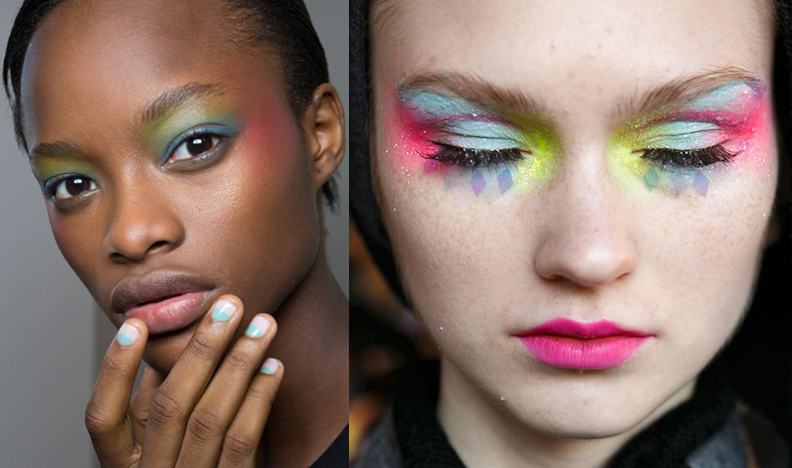
(images from makeupforlife.net and fashionising.com)
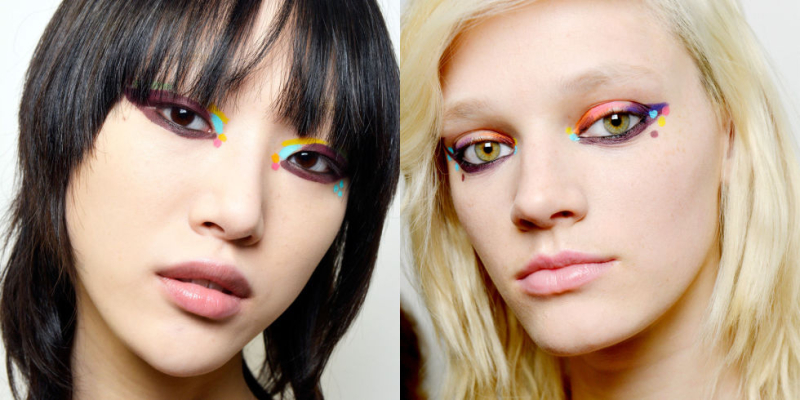 (image from harpersbazaar.com)
(image from harpersbazaar.com)
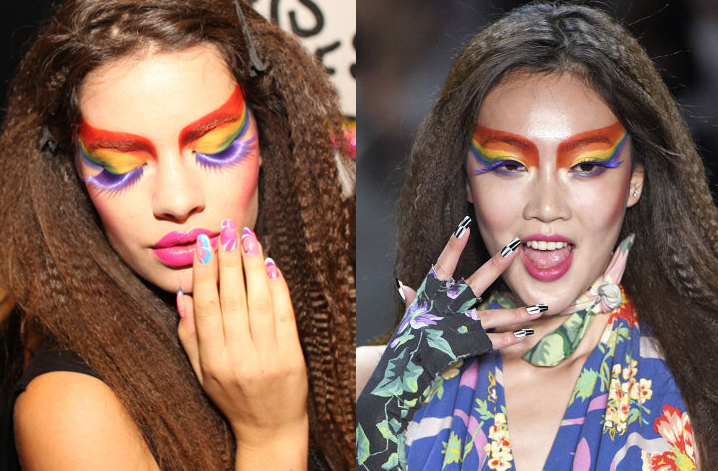 (images from wwd.com and seventeen.com)
(images from wwd.com and seventeen.com)
It doesn't look like rainbow makeup is going anywhere soon, as evidenced by the stunning looks Pat McGrath created for Maison Margiela's fall 2017 show, along with products like MAC's Colour Rocker lipsticks and Kat Von D's Pastel Goth palette. Even Sephora's typography got a rainbow makeover. (While the gradient rainbow style was used more to convey holographic makeup/highlighters, it represents exactly what I meant earlier – rainbow makeup and holographic makeup may be distant cousins, but they definitely belong to the same family).
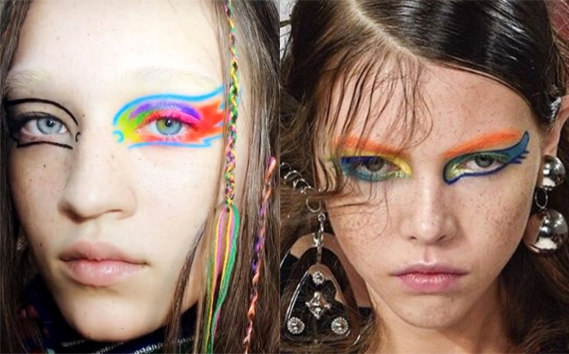 (images from instagram.com)
(images from instagram.com)
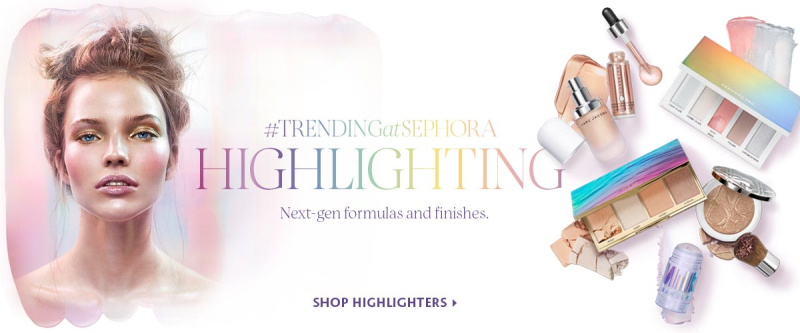 (image from sephora.com)
(image from sephora.com)
Then there are these magazine features from the March 2017 issues. (Yes, I still tear out magazine pages. Yes, I'm aware there's Pinterest and that we live in a digital world.)
That was long! Phew, I'm tired. Actually I'm not, since looking at a bunch of different colors together energizes me. As a matter of fact, I tend to get a little overstimulated, which is why I do most of my makeup shopping online – in-store browsing at all those colors displayed on the counters is very bad for my wallet.
Update, 4/3/2020: I realized I never addressed rainbow makeup as it pertains to the LGBTQIA+ community. In addition to rainbow makeup's role as a way for people to explore more colorful cosmetic options, it also functions as an important extension of the rainbow symbolism created by and for the community over 40 years ago. One questionable trend, however, has been the rise of companies slapping rainbow packaging on some of their regular line items in order to "celebrate" (co-opt?) Pride month. By and large, it’s a positive development as the products raise visibility for LGBTQIA+ rights and most of them donate the sale proceeds from these items to various charities. They also call attention to makeup’s significance for the LGBTQIA+ movement, both past and present. On the other hand, sometimes it feels like a shameless cash grab with the main focus being the product instead of meaningful action or change. If you’re on the market for new makeup and want to feel good knowing that your purchase helps a marginalized population, go for it – no one should be embarrassed to buy them. I personally cannot get enough of rainbow packaging and purchased several items just for the colorful designs on the boxes. But the motivations of some of these companies are questionable, i.e. are they really committed to the cause or just once a year when they put rainbows on their packaging and call it a day? One thing is for certain though: although the Museum is committed to LGBTQIA+ rights year round, I look forward to the rainbow looks Pride month brings (and obviously I think people should feel free to wear rainbow makeup year round as well.) Pride looks exemplify the raison d’etre of rainbow makeup by demonstrating the joy playing with color can bring and the freedom to wear it.
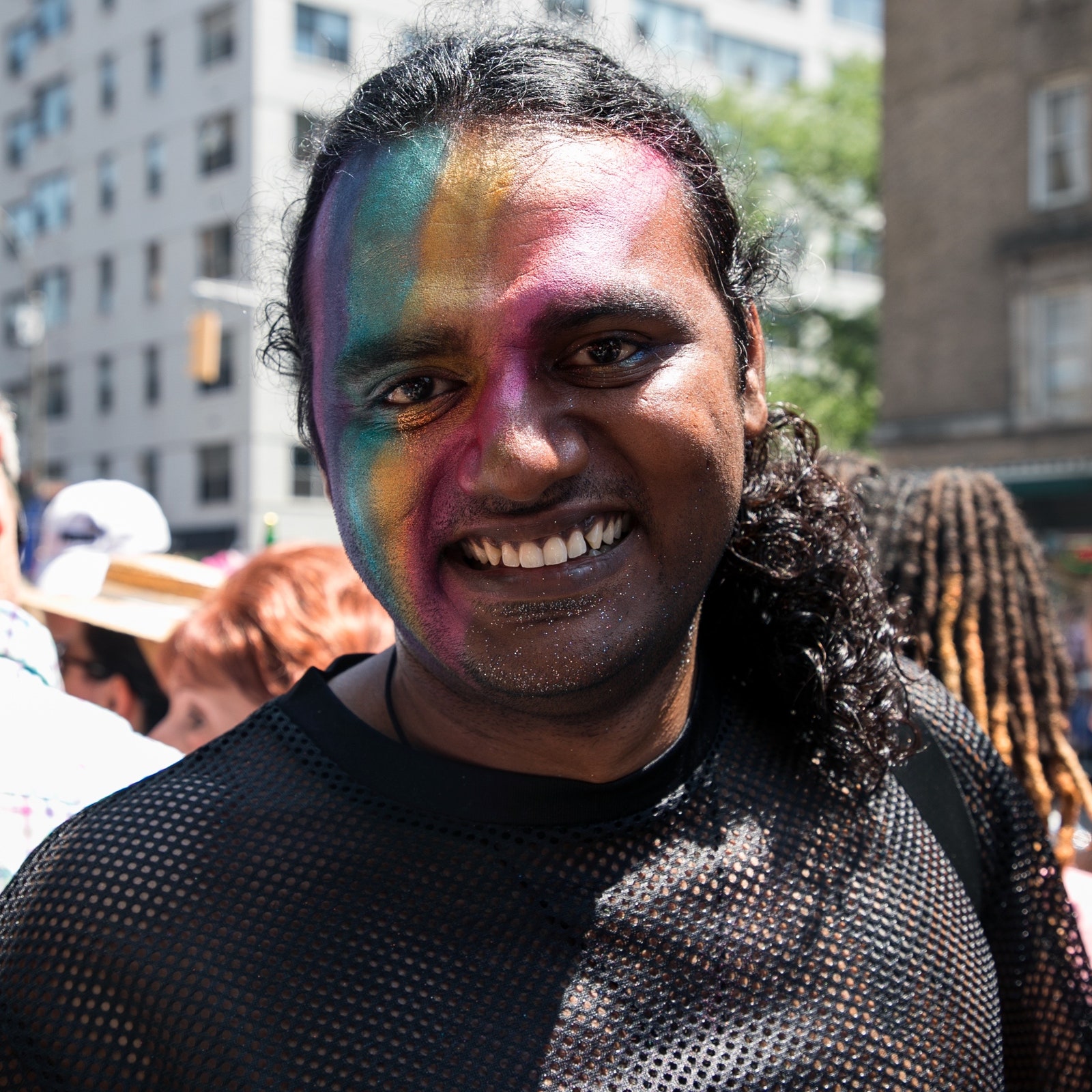
(images from allure.com)
I hope you enjoyed the exhibition and that you'll play with color this season, either by wearing shades so bright they hurt your eyes or simply giving color correctors a go (and everything in between). Just have fun!
Tiffany? Harry Winston? Fred Leighton? Forget about 'em. While they might be supplying the sparkling baubles for today's red carpet, back in the late '30s and '40s there was a jeweler bigger than those 3 put together: Paul Flato. I'll get to why I'm talking about a jeweler in a sec, but first a brief bio is in order. Paul Flato (1900-1999), moved from his home state of Texas to New York City at the age of 20. He opened his own jewelry store shortly afterwards and employed several designers. By 1937 he had another store on the West Coast to further solidify his status as the go-to jeweler for the biggest Hollywood stars (think Joan Crawford and Katherine Hepburn) as well as a jewelry designer for major films.
Now here's where his story goes off the rails. In 1943 he was arrested for pawning over $100,000 worth of jewels that clients and fellow jewelers had entrusted to him on consignment and served 16 months in Sing Sing. Upon his release from prison he started a lucrative business designing compacts, which was fortunate as his Hollywood career was basically over. After the compacts, Flato continued to design jewelry in the store he opened in Mexico City from 1970-1990, then returned to Texas for the last decade of his life. To my knowledge he never got back into Hollywood's good graces – I couldn't find anything about him supplying jewelry for movies/actresses after 1943 – but it didn't matter since he had already become a legend.
I had seen the Flato brand floating around previously during my various vintage compact hunts and figured one would be a good addition to the Museum's collection, but none of the designs really appealed to me. Since they can be on the pricey side I decided to hold off to see if any really caught my fancy. And as luck would have it this adorable compact and lipstick case, still in the original box, eventually surfaced. Against my better judgement I got involved in a nasty Ebay bidding war, but ultimately won (and probably overpaid a smidge).
Looking back it was totally worth it given how awesome the design is. You may or may not know I have a thing for mint green/jade/bakelite so when I gazed into this kitty's glowing mint green eyes I knew she had to be mine.
Love the matching design on the lipstick case!
I thought it would be good to discuss Flato's style a little so we can see how it translated to the compacts. I find his pieces to be whimsical and tongue-in-cheek, while still piling on the sparkle. Some examples, according to his obit in the New York Times: "Among them were a diamond 'corset' bracelet, with garters in rubies and diamonds, based on Mae West's undergarment…a compact for Gloria Vanderbilt was studded with gold and enamel angels, including an angel on a chamber pot. A pair of little brooches of gold feet with ruby toenails was originally made for Irene Castle, a play both on her maiden name, Foote, and her dancing career." Flato also drew on everyday experiences and items – his observation of fallen leaves one crisp autumn day turned into this brooch, while a basic belt buckle became a dazzling aquamarine necklace.
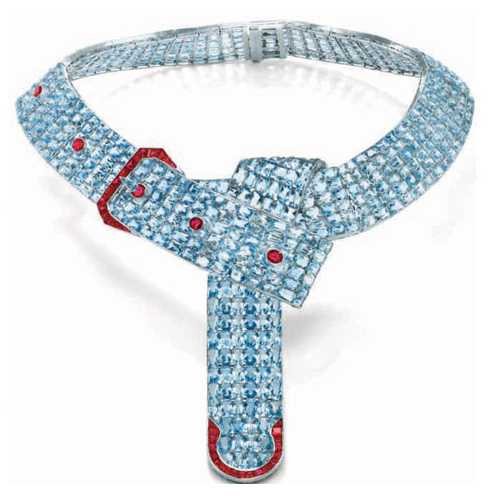
(images from langantiques.com)
Another prominent motif in Flato's work was hands, according to this site: "Hand imagery had always been of interest to Flato, who notably used antique hand sculptures to display jewelry in ads that appeared in Vogue and Harper’s Bazaar during the 1930s." Here are some quite literal examples.
Not only that, but Flato's own battle with hearing loss at a young age inspired a series of sign language pins.
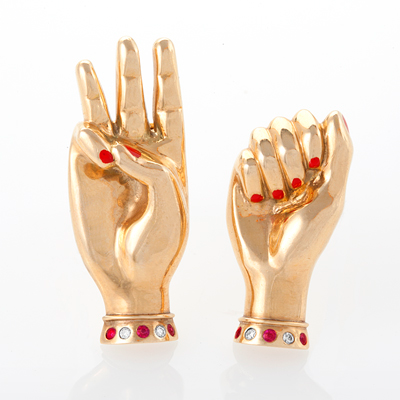
(images from jewelsdujour.com)
This same playfulness mixed with a healthy dose of sparkle carried over to Flato's compacts. I liked that he created designs that were different from his jewelry line but still maintained his signature style. It looks like Flato filed the patent for the compacts in February 1948 and they were available for sale later that year. Interestingly, this wasn't the first time Flato had the idea to design compacts, as evidenced by this 1940 patent for a compact, cigarette case and lipstick combo.
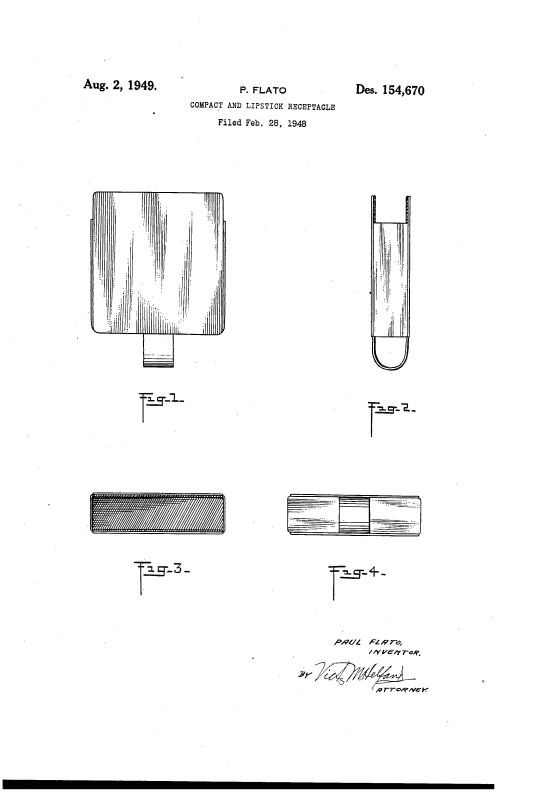 (image from google.com)
(image from google.com)
I meant to order this ad from hprints in time for this post and completely spaced on it. Sigh.
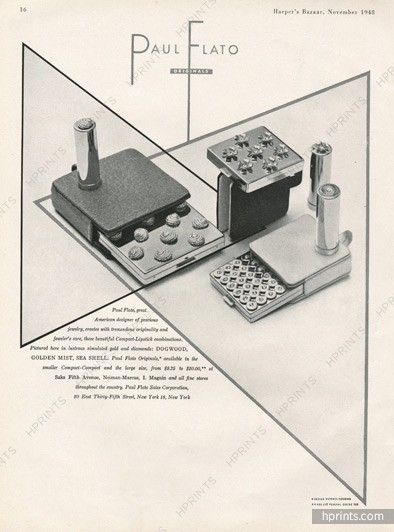
(image from hprints.com)
The ones shown in the ad above are fairly common. I wouldn't mind adding the seashell one to my collection. ;) There's also a patent for it too, which is pretty cool.
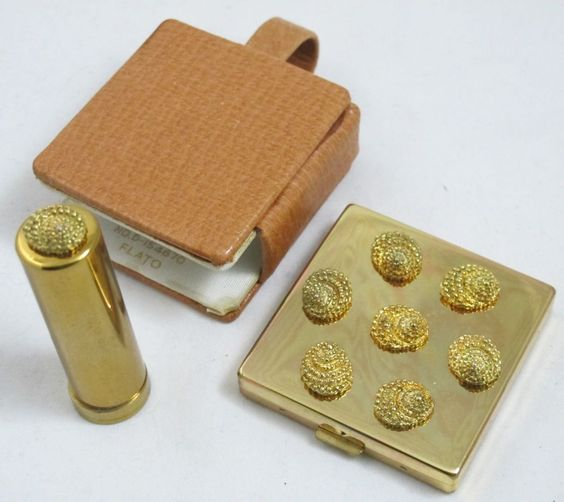
(image from pinterest.com)
The popular dogwood design:
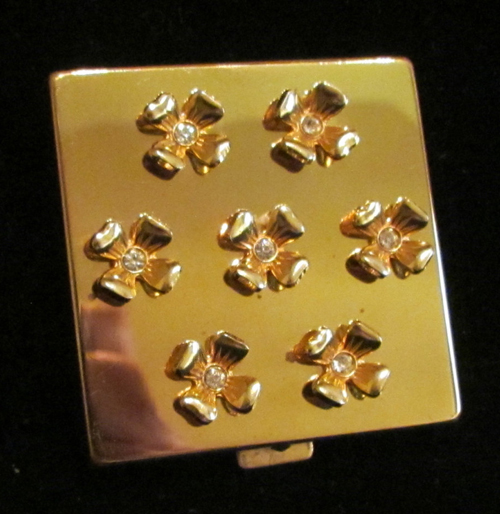
(image from etsy.com)
And this circular patterned one.
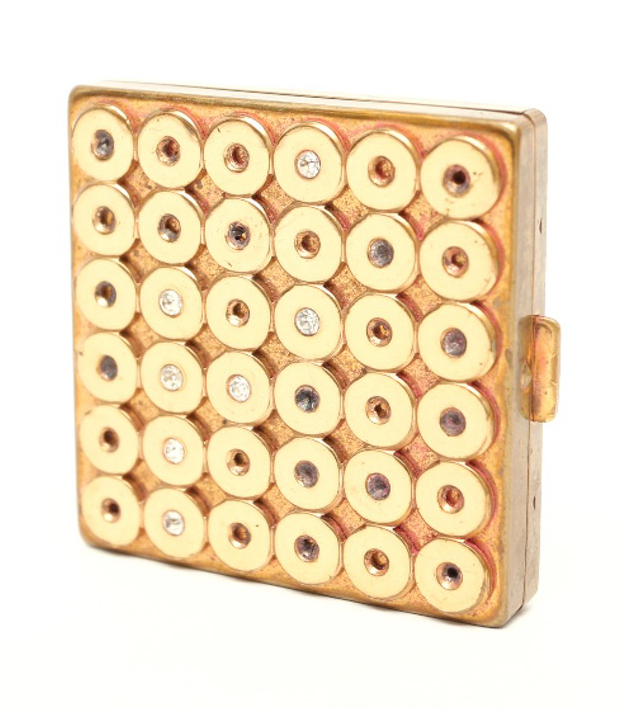
(image from ebth.com)
Apparently the compacts were a pretty big hit right away, according to this news snippet from 1949.
Some more, just for fun.
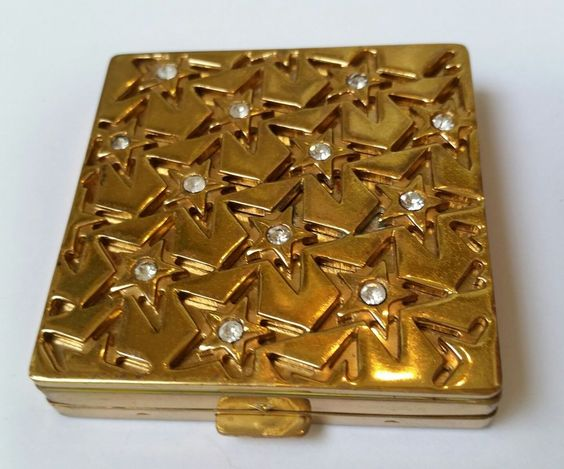
(image from pinterest.com)
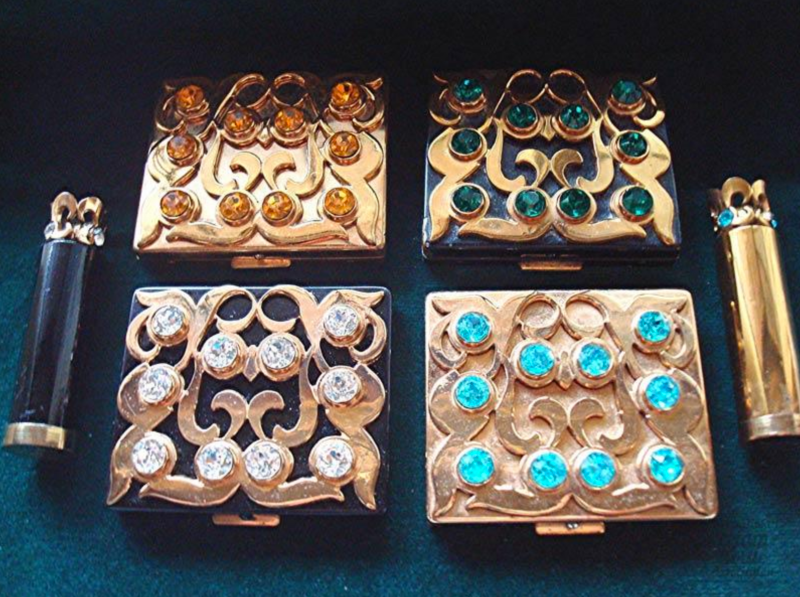
(image from perfumebottles.org)
It's not just a key design; it's a key holder! Yes, you could have the key on this compact custom filed to fit your door. Personally I'd be petrified of losing it – my keys need to stay on a ring – but you have to admit there's some innovation there.
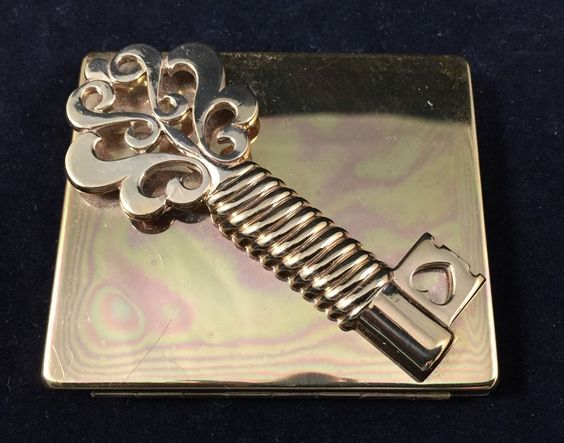
(image from pinterest.com)
Another key ad, plus the wonderfully blinged-out teardrop design.
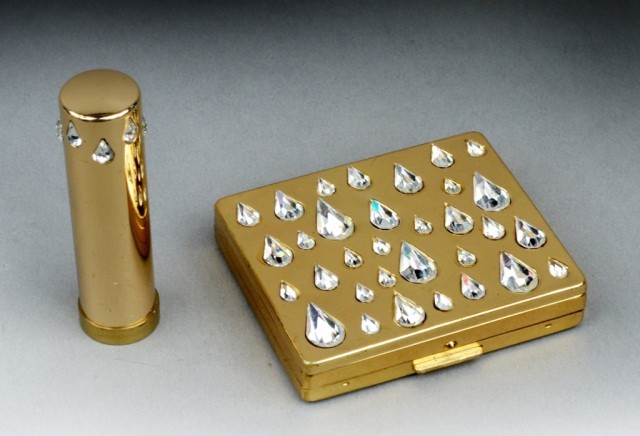
(image from liveauctioneers.com)
This one definitely shows Flato's sillier side. Would you like one of his "scatabout" pins while you're at it? You know, to anchor your lapel flower? Fashion sure has changed!
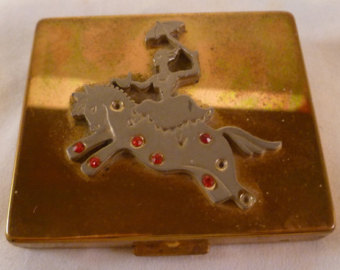
(image from etsy.com)
This one is also a lot of fun. I couldn't find any ads for it but I wonder if it was a special release for Easter.
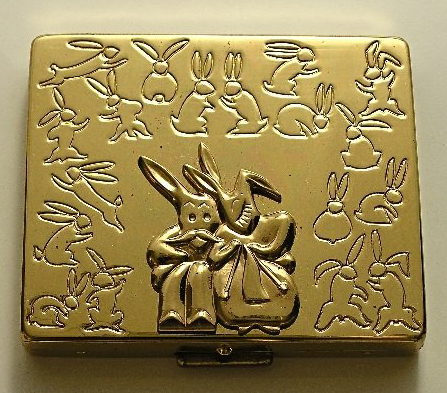
(images from liveauctioneers.com)
The kitty one I have seems to be relatively rare. In my searches I did see one other in a beautiful tiger-eye colorway instead of the green, but I can't seem to find the photo of it now. In any case, I'm pretty pleased with this acquisition as I do think it's one of Flato's better compact designs.
What do you think, both of Flato's jewelry and compacts? Most of them aren't my style but I appreciate them nonetheless. If his jewelry is really striking your fancy you can always buy this lovely catalog of his work.
While color correcting seems like a new trend, my experience as a self-taught makeup historian tells me that it probably existed decades ago. However, I had no idea that color correcting was in effect as early as 1917, when Japanese company Shiseido introduced their "rainbow" face powders. In honor of the 100-year anniversary of this cutting-edge beauty development, Shiseido released the 7 Color Powders Centennial Revival Edition (that's a mouthful!), which is essentially a re-creation of the original powders using contemporary color correcting technology and ingredients. The powders come in a gorgeous keepsake box adorned with concentric metallic rainbow lines. I am very fortunate to have such a kind and generous husband who procured this set for me for Christmas. 🙂
Does anyone know what this means?
I always get positively giddy over a numbered edition. In the eyes of a collector, numbering makes the item seem really special…even if there are 9,000 of them produced!
The box design is nearly identical to the original. Shiseido was ahead of its time back then not just for product innovation but also for packaging. Chapter 3 of an excellent dissertation entitled "Imperial Designs:" Fashion, Cosmetics, and Cultural Identity in Japan, 1931-1943" by Rebecca Nickerson sheds light on the design process. In 1915 Shiseido's founder, Fukuhara Arinobu, unofficially passed ownership of the company to his son, Fukuhara Shinzo, who had been traveling domestically and abroad to study art and photography for a number of years prior. The younger Fukuhara used his passion for art and aesthetics to form an official cosmetics division for the company and in 1916, he appointed a design team consisting mostly of artist friends he had met during his travels to create sophisticated, appealing packaging for all of Shiseido's products. The creation of such a group, focused on cohesive design and marketing, was cutting-edge for the time. Their artistic skill proved quite effective: "The design team came up with unique packaging for the face powder. Each of the seven colors was in its own original eight-sided, white satin box, and the lids were embossed with two concentric gold lines and Shiseido's camellia logo. Above the logo were the words 'poudre de riz', the French term for face powder, and below it in Roman letters, 'Shiseido, Tokyo'. The package design was simple yet sophisticated and conveyed a sense of the foreign, which was exactly what Fukuhara wanted consumers to associate with the Shiseido brand. This was Shiseido's second attempt to introduce Western face powders to Japanese consumers. While most women could not afford or had little interest in Western face powders in 1906, by 1917 consumption was on the rise and greater numbers of women were eager to embrace this new trend in beauty culture. The flood of modern Western culture, Hollywood films, and a general enthusiasm for 'Americanism' also increased demand for modern fashion and cosmetics. Shiseido was one of a number of companies to introduce similar face powders around this time, and the 'Rainbow Face Powder' succeeded in making Shiseido a visible player in the cosmetics market." (p. 103).
I was so hesitant to try to peel off one of the seals to open the box, but I managed to do so without ripping it.
For comparison's sake, here are photos of the original powders and you can see more pictures of them from the Shiseido Museum here. I think the only differences are that the new revival ones are covered in a fabric material whereas the old boxes seem to be made from cardboard (I don't think it was satin), and the camellia logo is at the top of the powder covering in the revival versions – the originals don't seem to have the logo on the inside. I'm guessing the old ones didn't have the color-coded seals on the boxes either.
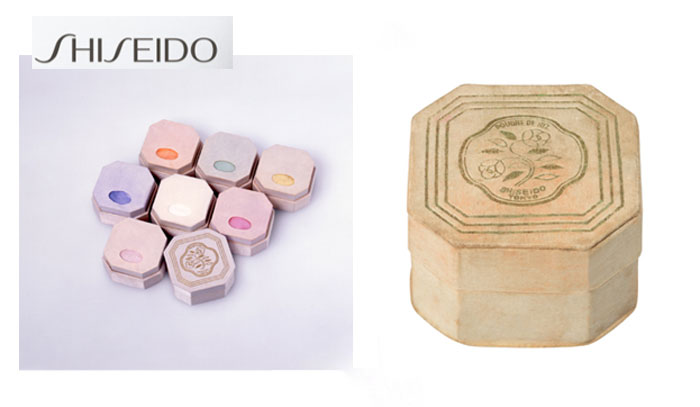 (image from davelackie.com)
(image from davelackie.com)
Anyway, why were these so groundbreaking? Well, besides the design, colored face powder didn't really exist back then. I've mentioned this excellent paper from art historian (ahem) Gennifer Weisenfeld before, but here's another excerpt explaining why these were a breakthrough: "Tinted face powders were exceedingly rare in prewar Japan and Shiseido pioneered them early on with a series of colors under the brand name Poudre de Riz. The female entertainers (geisha) who worked in nearby Shinbashi and who were loyal Shiseido customers particularly liked the green and purple powder colors because they were thought to flatter the complexion under electric lighting." Not only did these powders have color correcting ability in less than ideal lighting conditions, Shiseido maintains they were a way for women to "match their face powder shade to their attire." This was in keeping with the shift towards more Western styles and a desire for more natural looking makeup. "Gradually, as Japanese cosmetic practices changed over time and moved toward a greater naturalism, the traditional thick white cosmetic foundation (o-shiroi) ceased to be used for daily wear." Finally, the rainbow powders, quite simply, were among the first steps in customized makeup that encompassed a much wider range of colors than were available previously. This in turn allowed Shiseido to reach a significantly greater portion of the cosmetics market, since the colors could be mixed to suit one's skin tone. Says Jessica Guerra, author of "Consumerism, Commodification and Beauty: Shiseido and the Rise of Japanese Beauty Culture" (another fantastic scholarly piece!), "Through different combinations of the seven provided colors, consumers could create their own shades and color palettes. Understandably, this would mean increased international appeal and marketability as racially diverse consumers could purchase Seven Colors Face Powder and create their own personalized shades based on preference." (p. 29). Indeed, even today Shiseido touts the customization ability of the revival powders, noting that they also give one "the freedom to experiment and create the most beautiful finish for your skin."
Shiseido hadn't completely abandoned the idea of reviving their rainbow powders until now. I couldn't read this whole article because it's behind a paywall (thanks, jerks), but apparently in late 2001 the company released a rainbow powder available only to their Camellia Club members: "Shiseido has resurrected a face powder-Rainbow Face Powder-that debuted in 1917 but in a way geared to the woman of the 21st century. The debut product featured seven colors-white, yellow, flesh, rose, peony, green, and purple-instead of the typical white to offer women the shade that best enhanced their facial features and to create an appearance more suited to the increasingly popular Western-style fashions. Renamed La Poudre Ruisselant, the face powder is sold in specially designed container with lids shaped like a camellia blossom-the symbol of Shiseido." I tried my darndest to find a photo of this "specially designed container" but only turned up a picture of the refill.
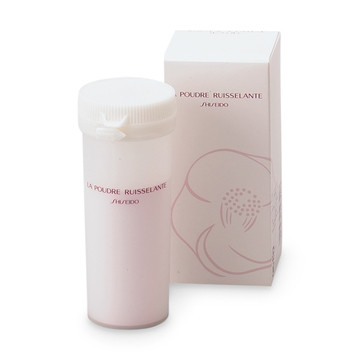
(image from honoaka-japan.jimdo.com)
While I couldn't find a photo, I do think it's interesting to note that Shiseido tried revamping their rainbow powders previously. Maybe in 2001 the makeup world at large wasn't yet receptive to color correcting and that's why Shiseido offered the Ruisselante powder to only a handful of consumers. But as color correcting has been all the rage for the past couple of years, now is a great time to re-introduce these to the public, not to mention the fact that it syncs perfectly with the 100th anniversary of the products' debut. I love how they updated the packaging too – very similar to the original but just enough details to make it modern and special enough to commemorate the anniversary. I'm still drooling over the shiny rainbow on the box, and the numbering…well, that's like collector's catnip.
What do you think of this set? Do you color correct at all? I do but with liquid or cream concealer rather than powder. 🙂
